
Hong Kong to Tokyo
February 14 to March 5, 2025
Mike and Judy Henderson
In this installment we travel from Shanghai to Jeju (an island off South Korea), and then to Japan. We do not go to Busan, as shown on the map.

+++++++++++++++++++++++++++++++++++++++++++++++++++++
2/26/2025 (Wednesday) Today is a sea day, so there is very little to report. The seas were calm last night and there were no problems with the cabin.
We slept late and I spent most of the morning working on this blog. In the afternoon we joined our Trivia group for another round, followed by the Seven Seas Society reception at 6pm.
At 6:30pm we had dinner in the Prime 7 restaurant.
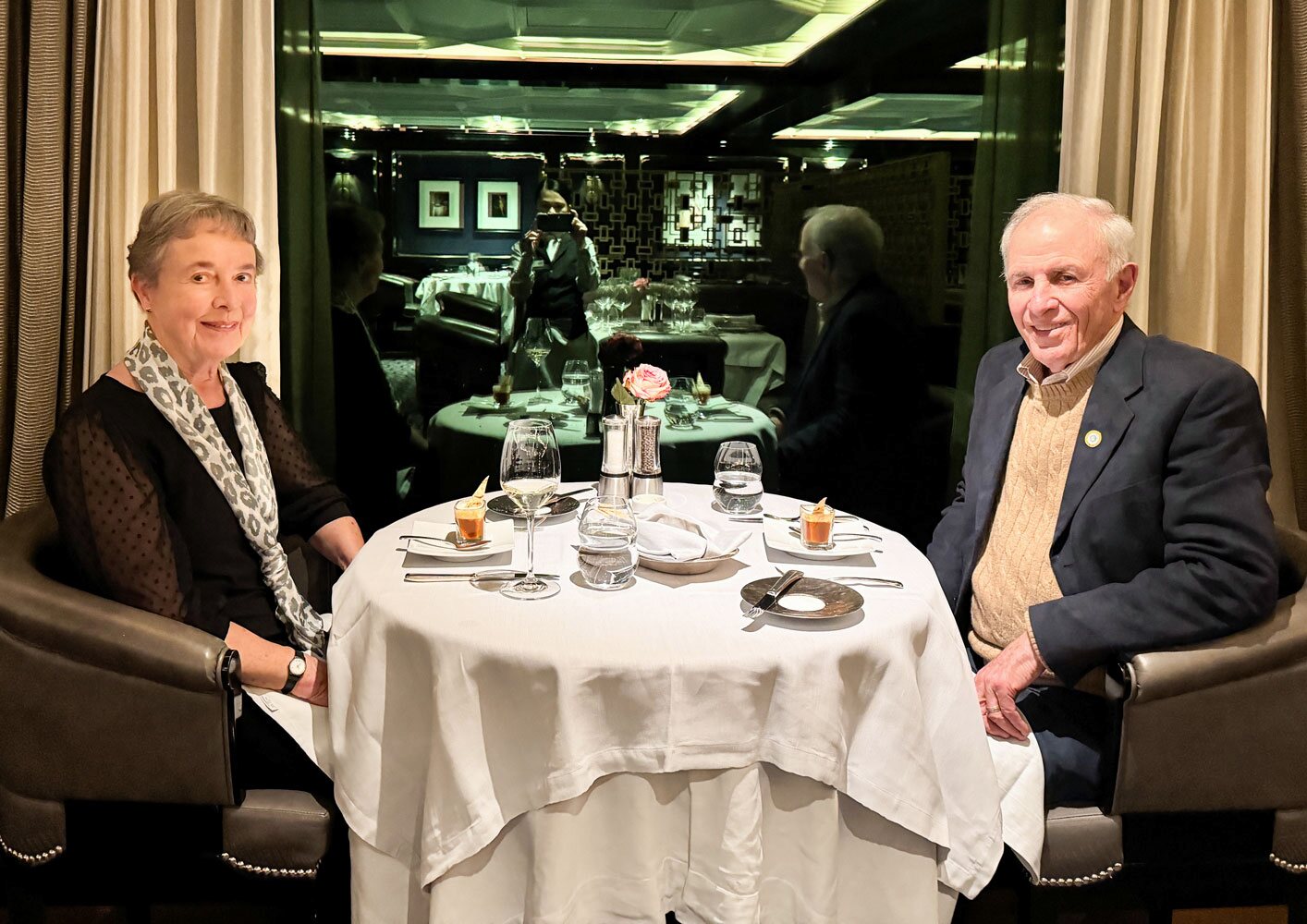
That was the end of our day.
+++++++++++++++++++++++++++++++++++++++++++++++++++++
2/27/2025 (Thursday) We docked at Gangjeong cruise terminal on Jeju Island (another link here) this morning. The cruise terminal is associated with a navy base that was built recently. The building of the navy base led to a significant amount of protest by the local people.
The population of Jeju is about 700,000 and the tour guide said that they get about one million tourists a year. I'm not sure what the tourists come for - could be just warmer weather and beaches.
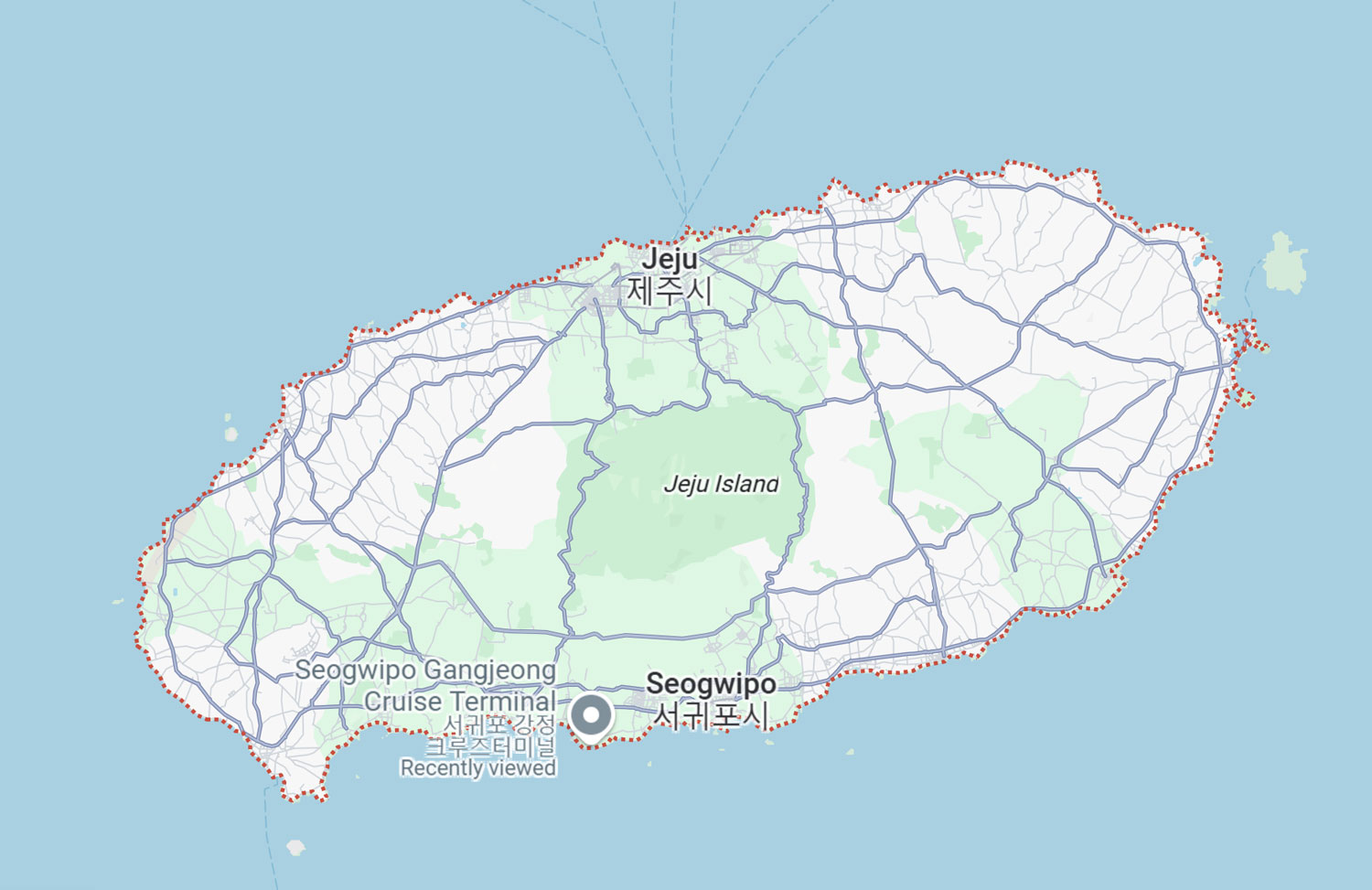
After an early breakfast we were in the theater for an 8:30am departure on our tour bus. It was a long walk from where we were docked to the main port building. My Apple watch measured just over a kilometer (about six tenths of a mile).
Here's a view down one part of the walkway. A bit further on there were moving sidewalks, so that helped the guests with mobility issues.
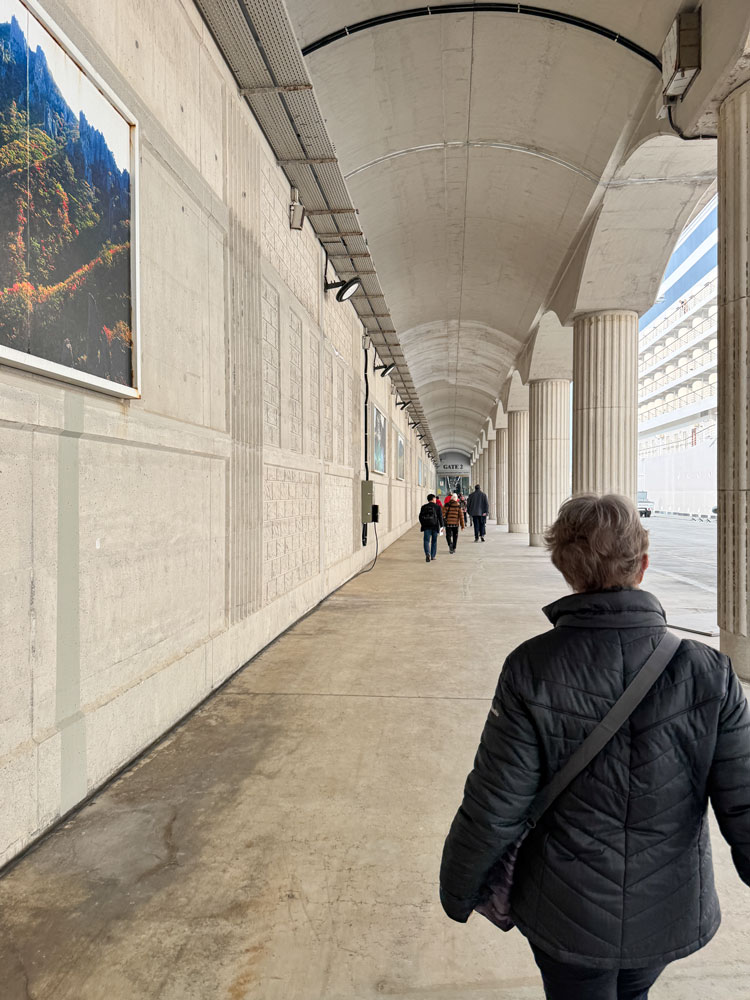
In the port terminal we had to clear immigration, but it was quick. Our first stop was the Sangumburi crater. It's located to the north east of the cruise ship terminal, and it took about an hour to get there.
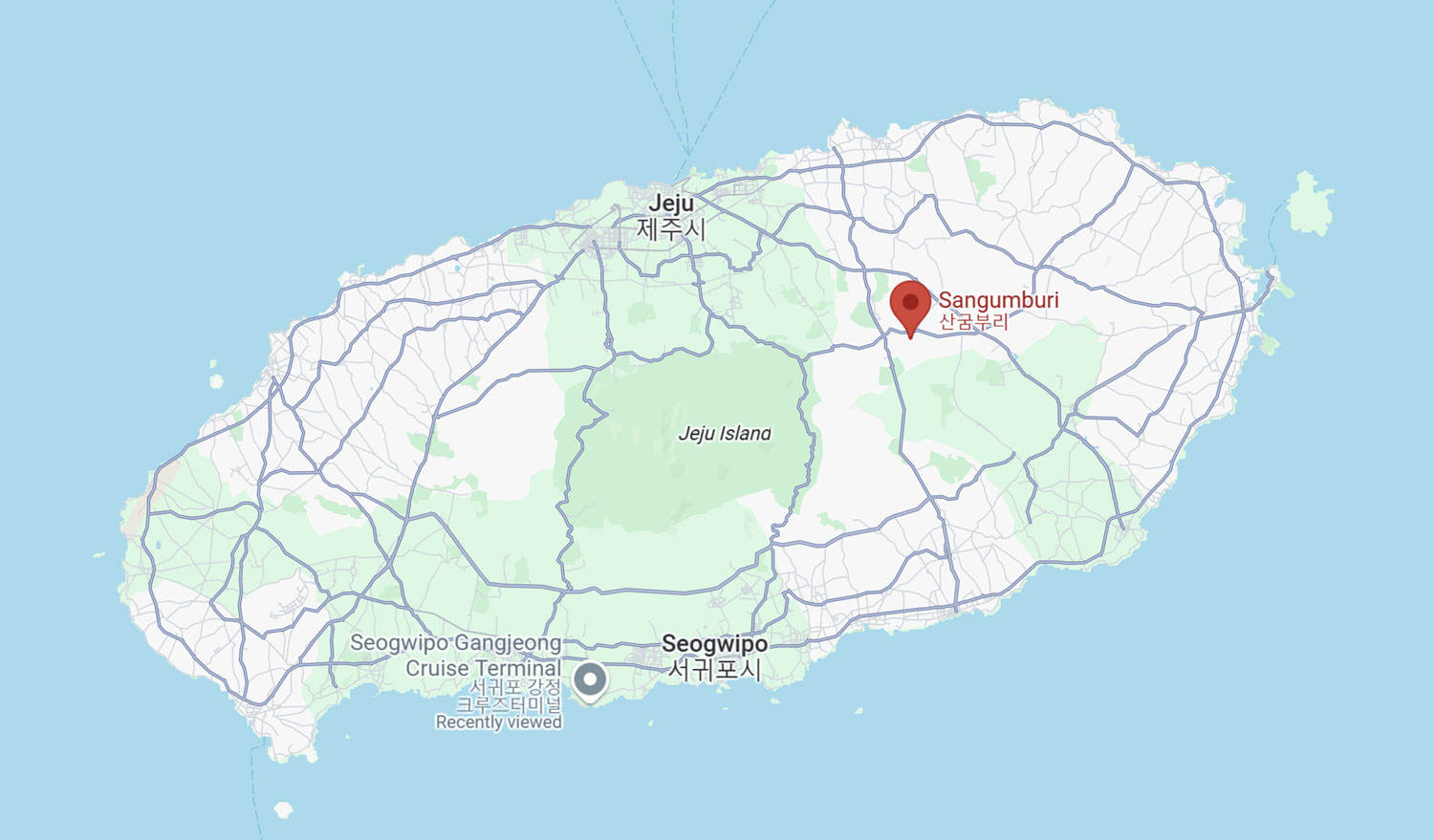
There are some Doi Hareubang statues in the area. The guide said that "Doi Hareubang" translates to "Grandfather made of stone". They were made about 1754, and they symbolize a protector.
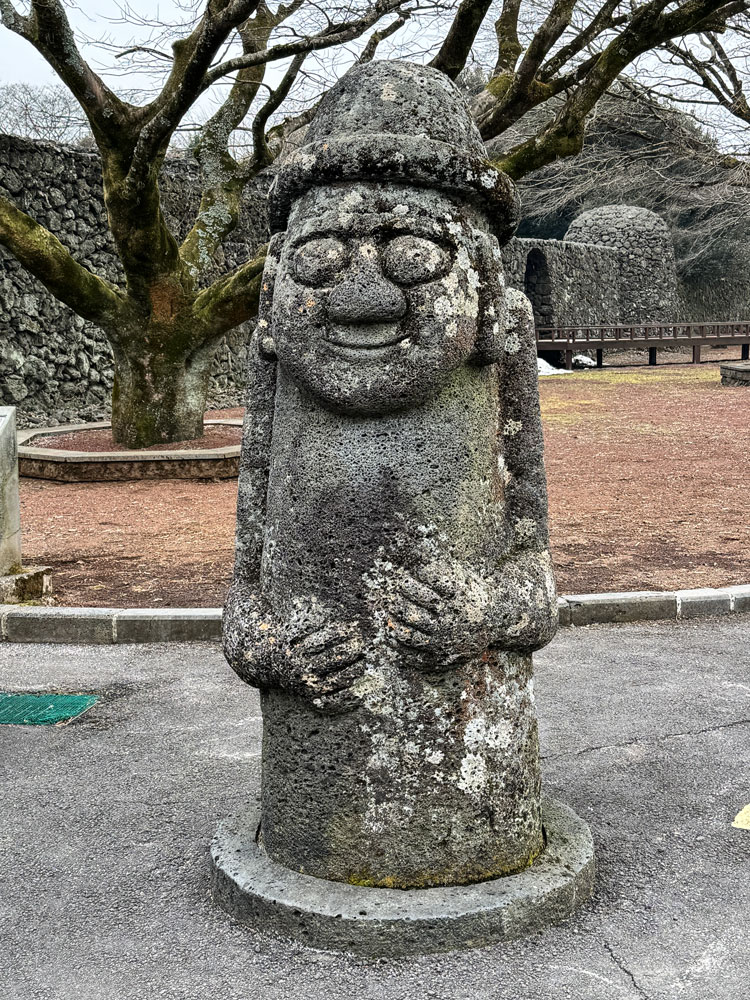
Here's the entrance to the park.

Just inside the entrance there were some large stones with a hole completely through them. The guide explained that the lava had flowed around a tree and then solidified. Eventually the tree decayed, leaving the hole.
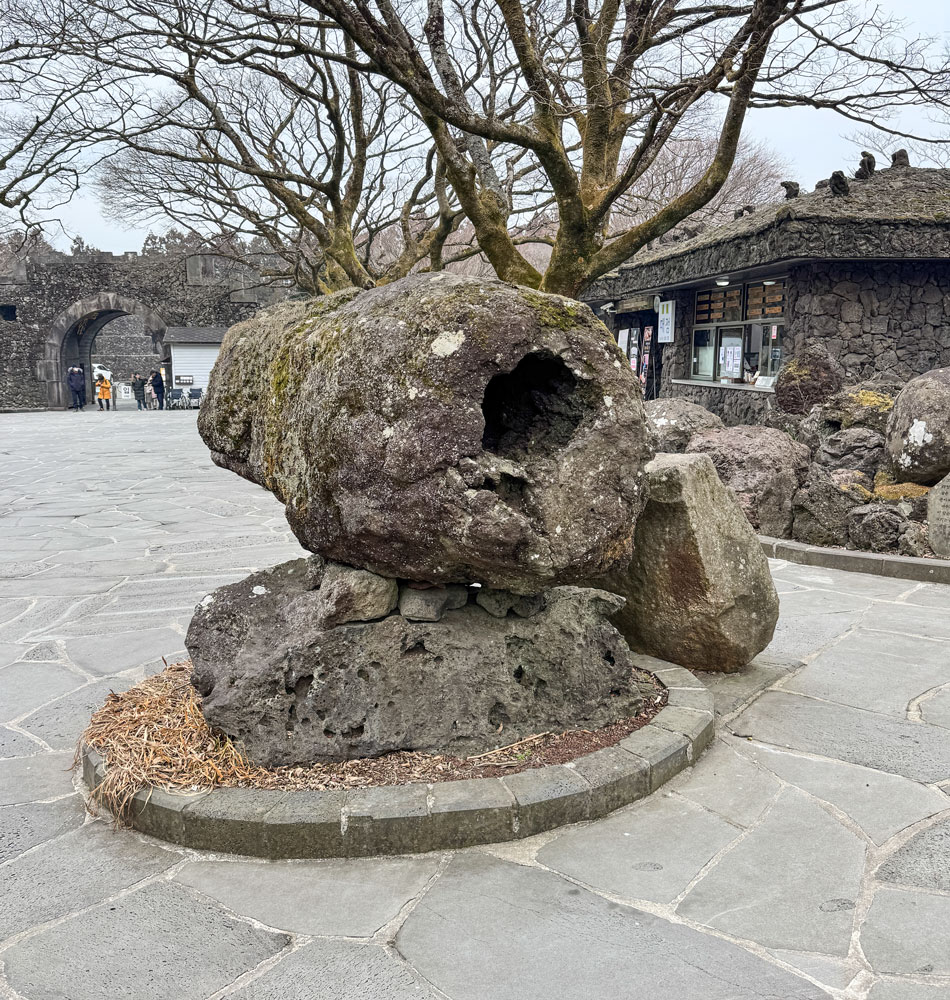
We walked up a fairly steep walkway to the highest point in the park. On the way, there was a depression caused by several of the fumaroles. We're heading up toward that building in the top right of the picture.
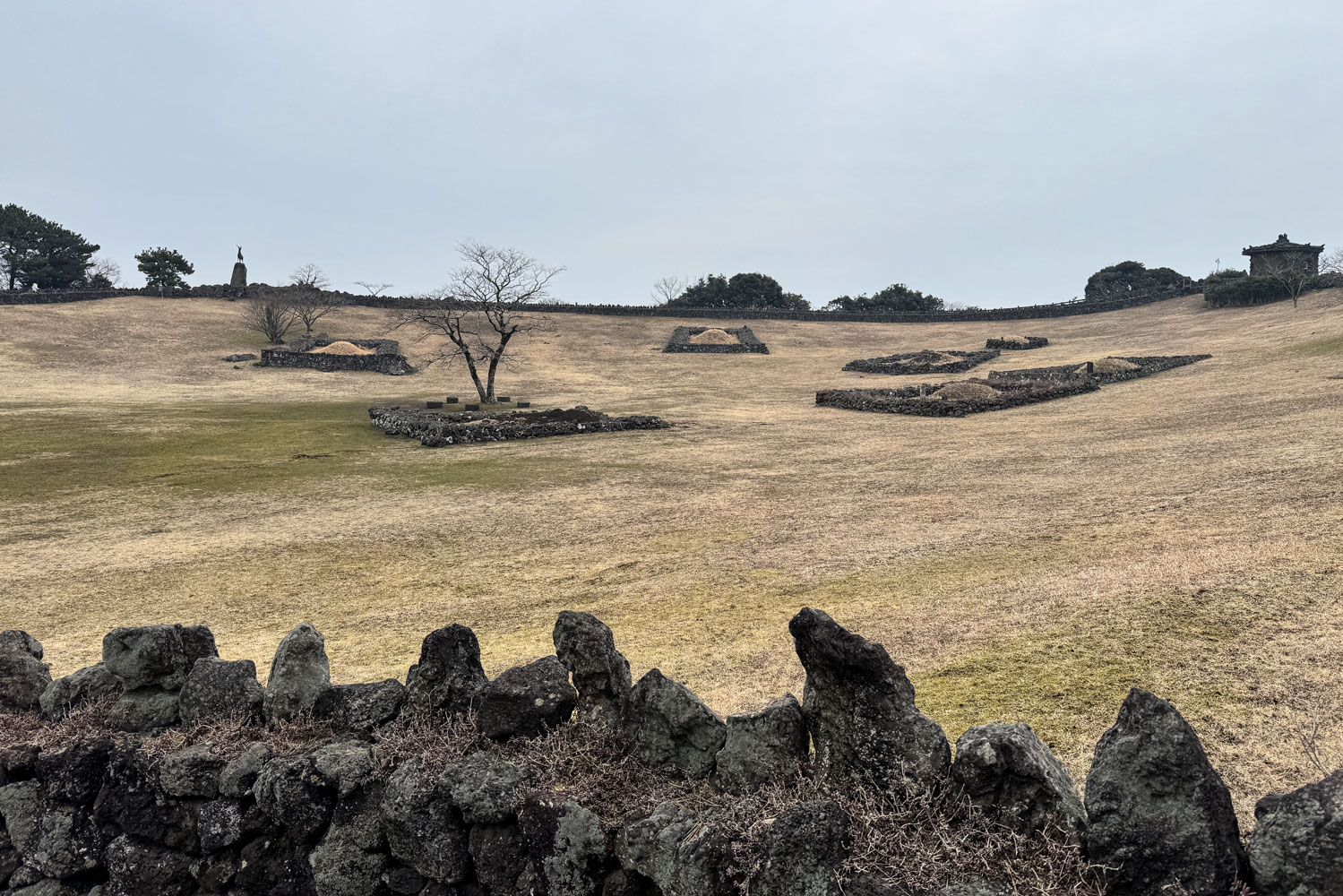
At the highest point was this marker monument.

Here's the actual crater, kind of stadium-shaped. Mostly just grown over with shrubs.
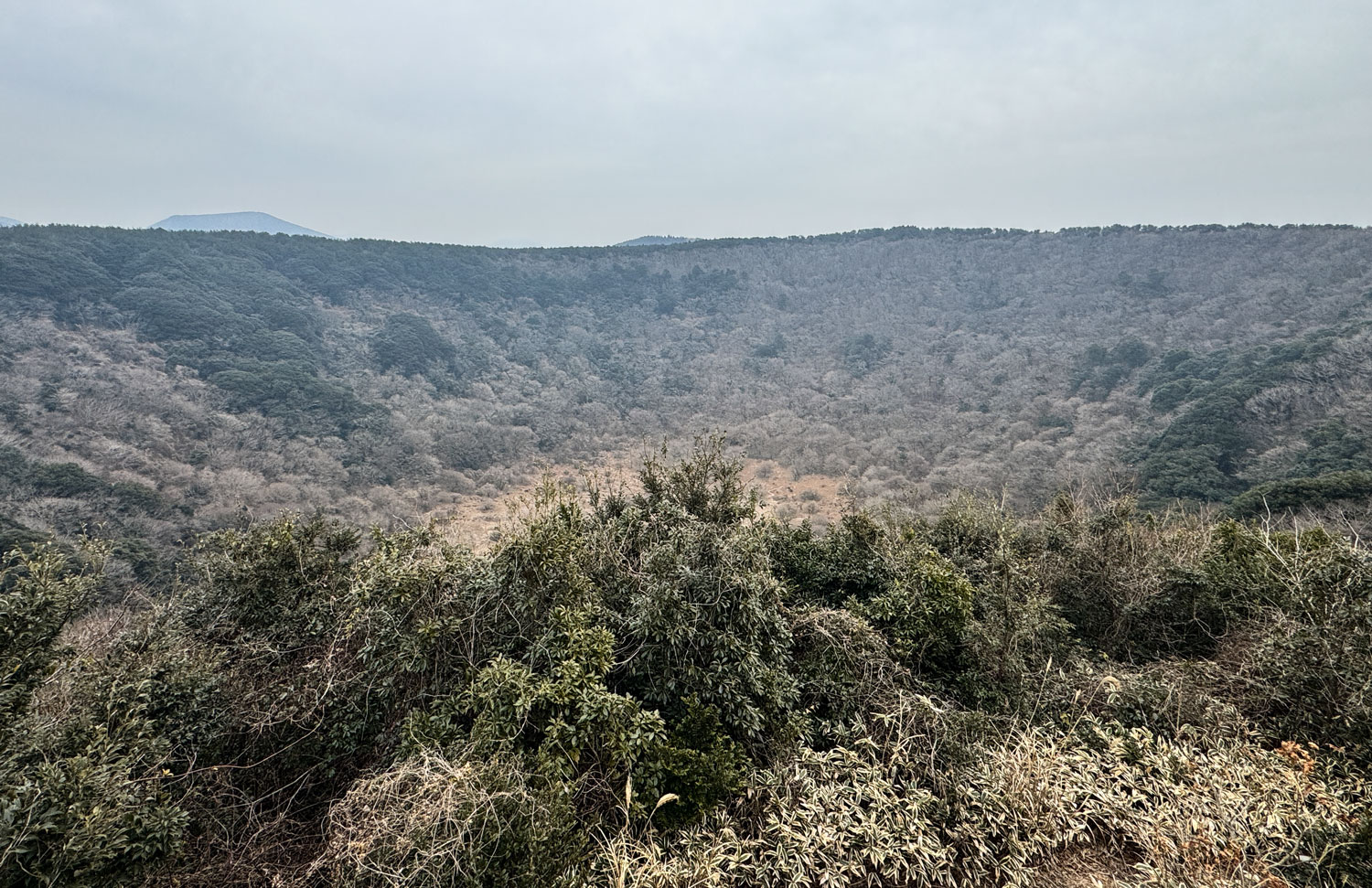
From the high point we walked the path around the smaller crater.
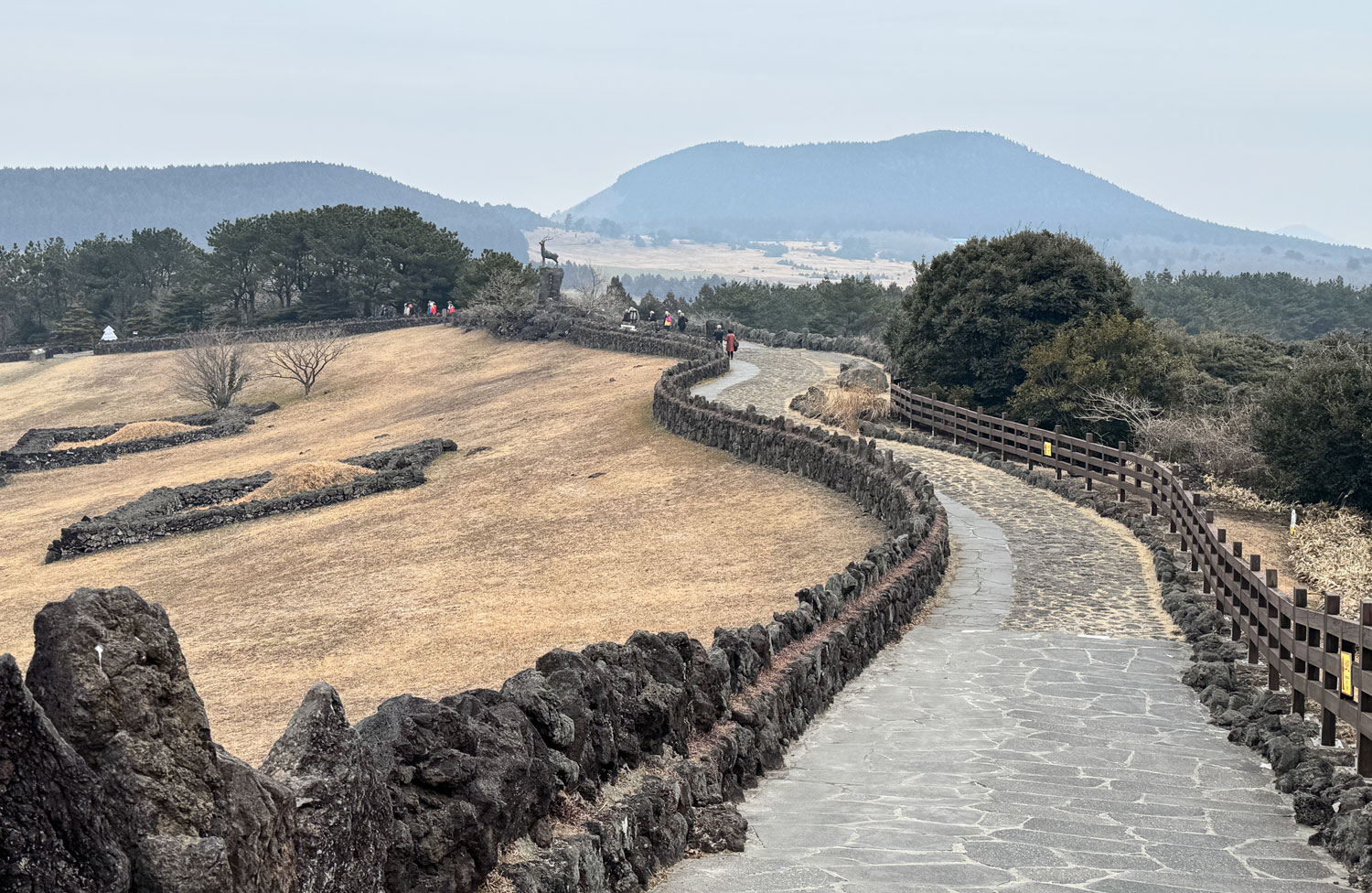
We came to the famous stag statue. Looks like a crow is using his nose as a resting place. I don't know the meaning of the stag.
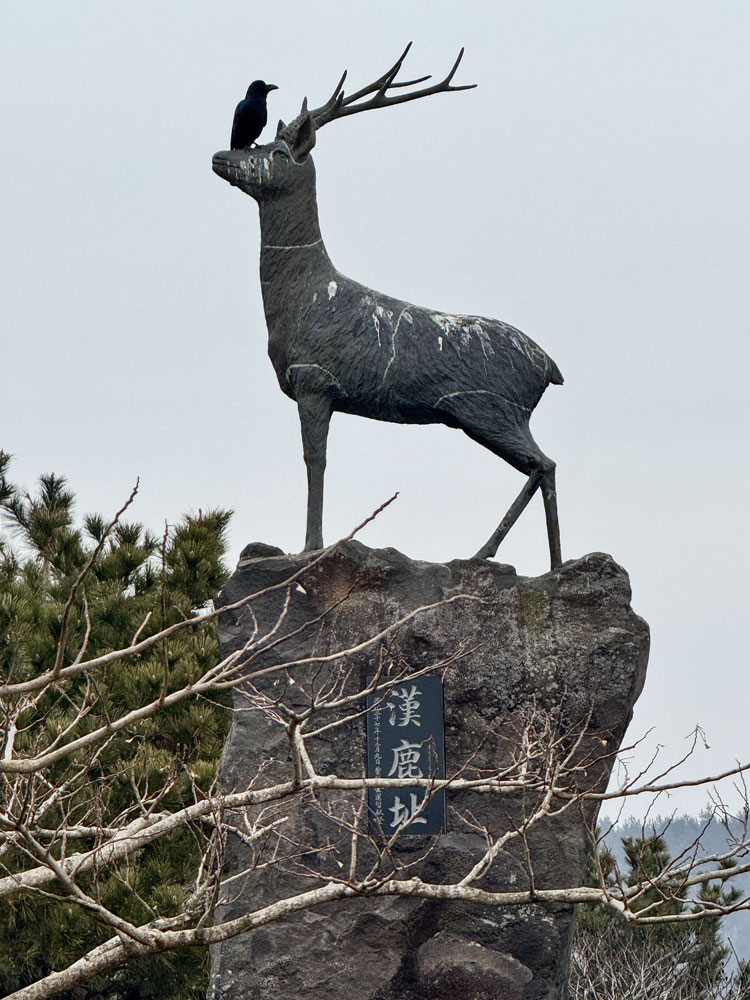
That was the extent of our visit to Sangumburi. We headed next to the lava tubes on the island, located not far from Sangumburi. Here's the entrance.

These Doi Hareubang statues were just inside the entrance. They are not smiling, like the ones are at the crater.
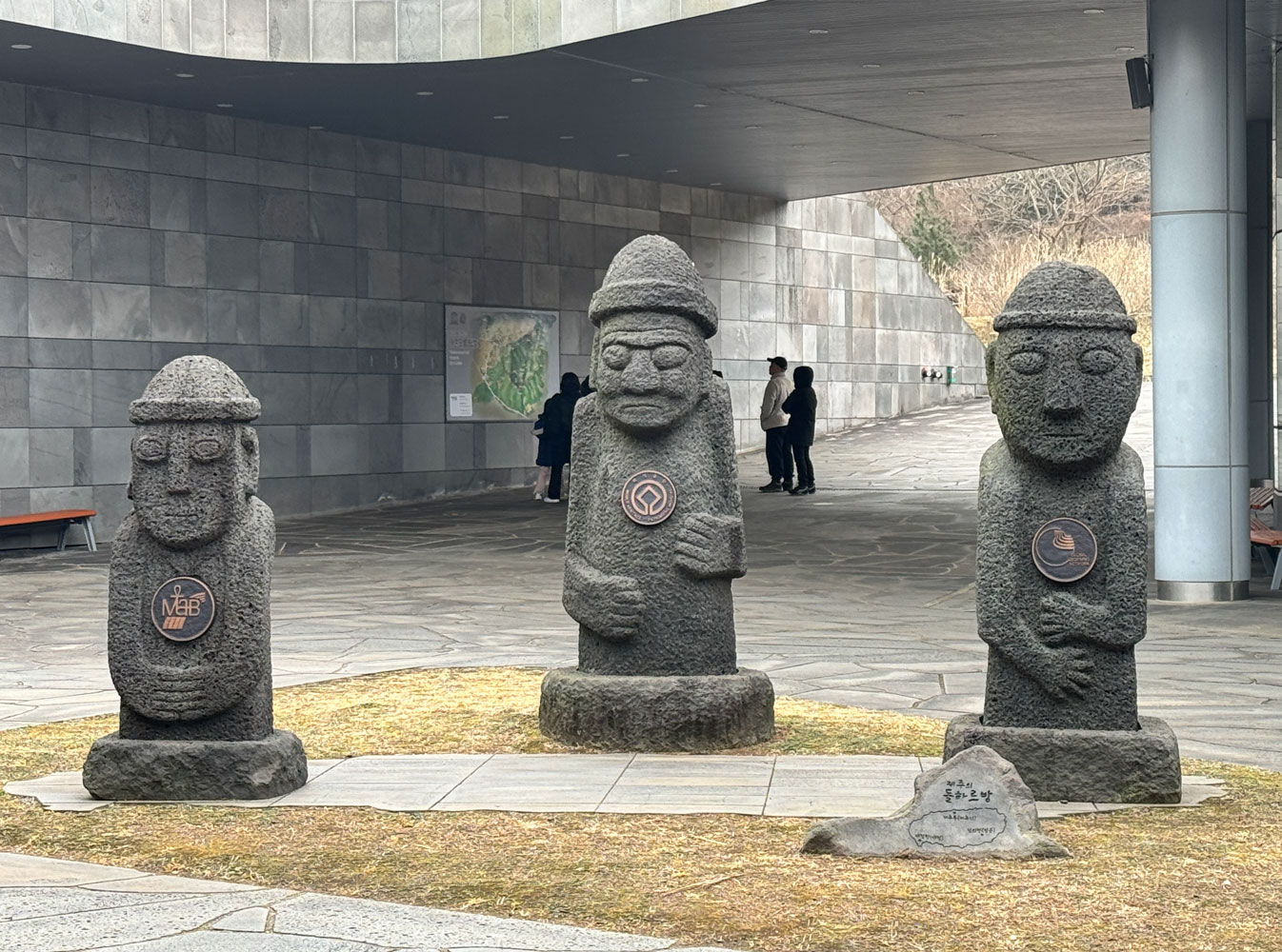
However, when we went into the facility there was some reason we couldn't go into the real lava tubes and were only shown the building facility which had exhibits about the lava tubes.
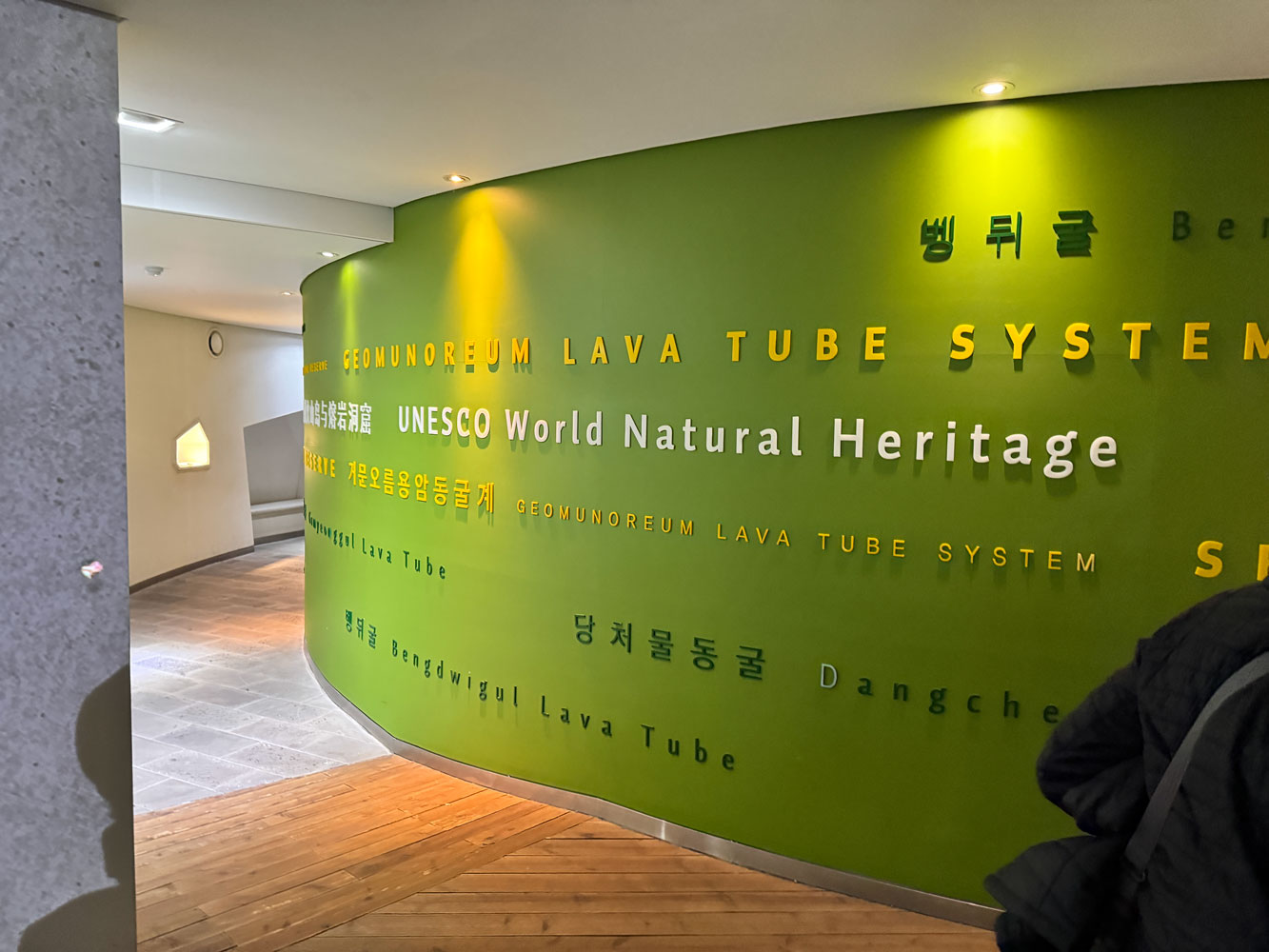
One display was a circular platform where there was a 360 degree projection of scenes around the area. It reminded me of the scene in the movie Soylent Green where Edward G. Robinson's character has gone to the euthanasia center to die and, as he's dying, is shown scenes of what Earth was like before it was overpopulated.

An exhibit with a model of what the lava tubes looked like.
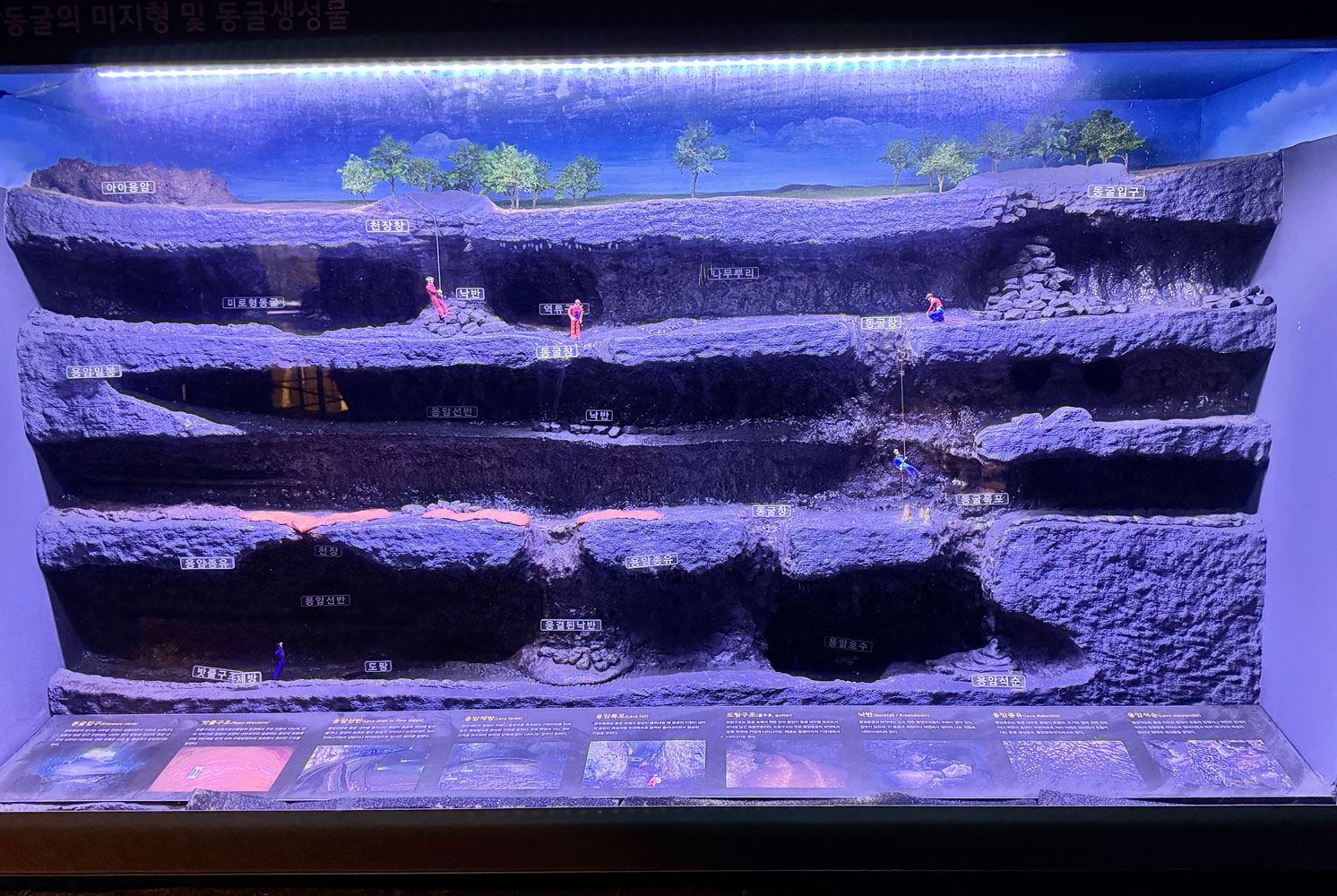
I have a few more pictures but it wasn't all that interesting. Regent had cancelled our visit to Busan and substituted Jeju Island, but Busan must have been more interesting.
With that, we returned to the ship and had lunch. That afternoon we played Trivia and I took a picture of our Trivia group. It's not a great picture because I couldn't back up enough and had to go super-wide with the lens. From left are Jeff, Robb, Suzanne, Michelle, and Judy. Note that everyone except Judy has double letters in their name. Maybe we can rename Judy to Judyy. I could go with Miike.
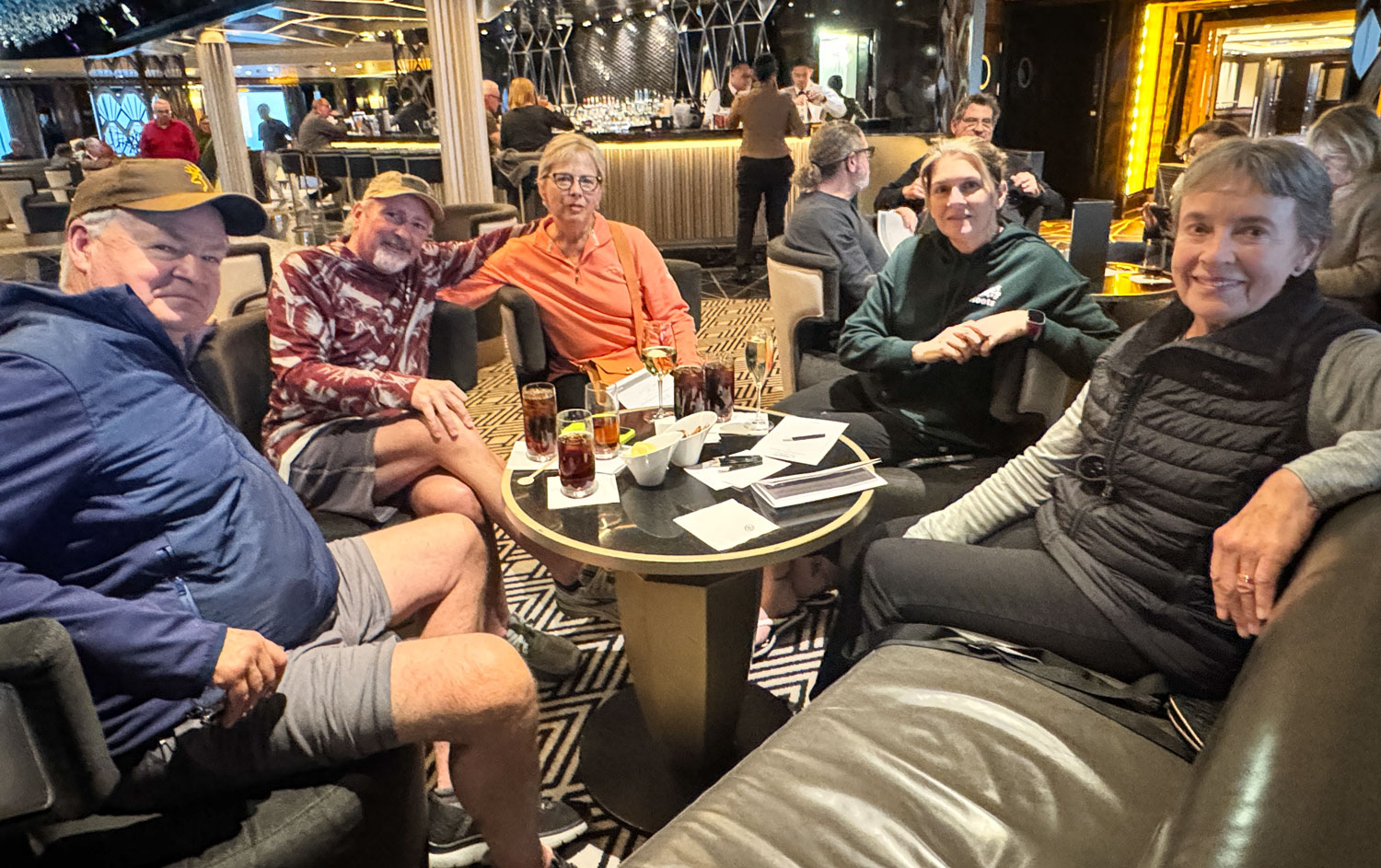
Our four partners in the game are traveling together and are sharing the Regent Suite. They invited us, and four other people, to come to their suite this evening for drinks, to be followed by a special dinner.
We arrived at 7pm. The Regent Suite is elegant, about 4,400 square feet - bigger than our house. I didn't take any pictures but you can do the 3-D view of the suite on the Regent site.
We went to the 10th deck and entered through the Prime 7 Restaurant in the aft of the ship. In the aft, there are two of the specialty restaurants on the ship - Prime 7 on the starboard side and Chartreuse on the port side. It turns out that there's a private dining room between the two restaurants, and that's what Michelle had arranged for us this evening. We had our choice of dishes from both Prime 7 and Chartreuse (we had both menus).
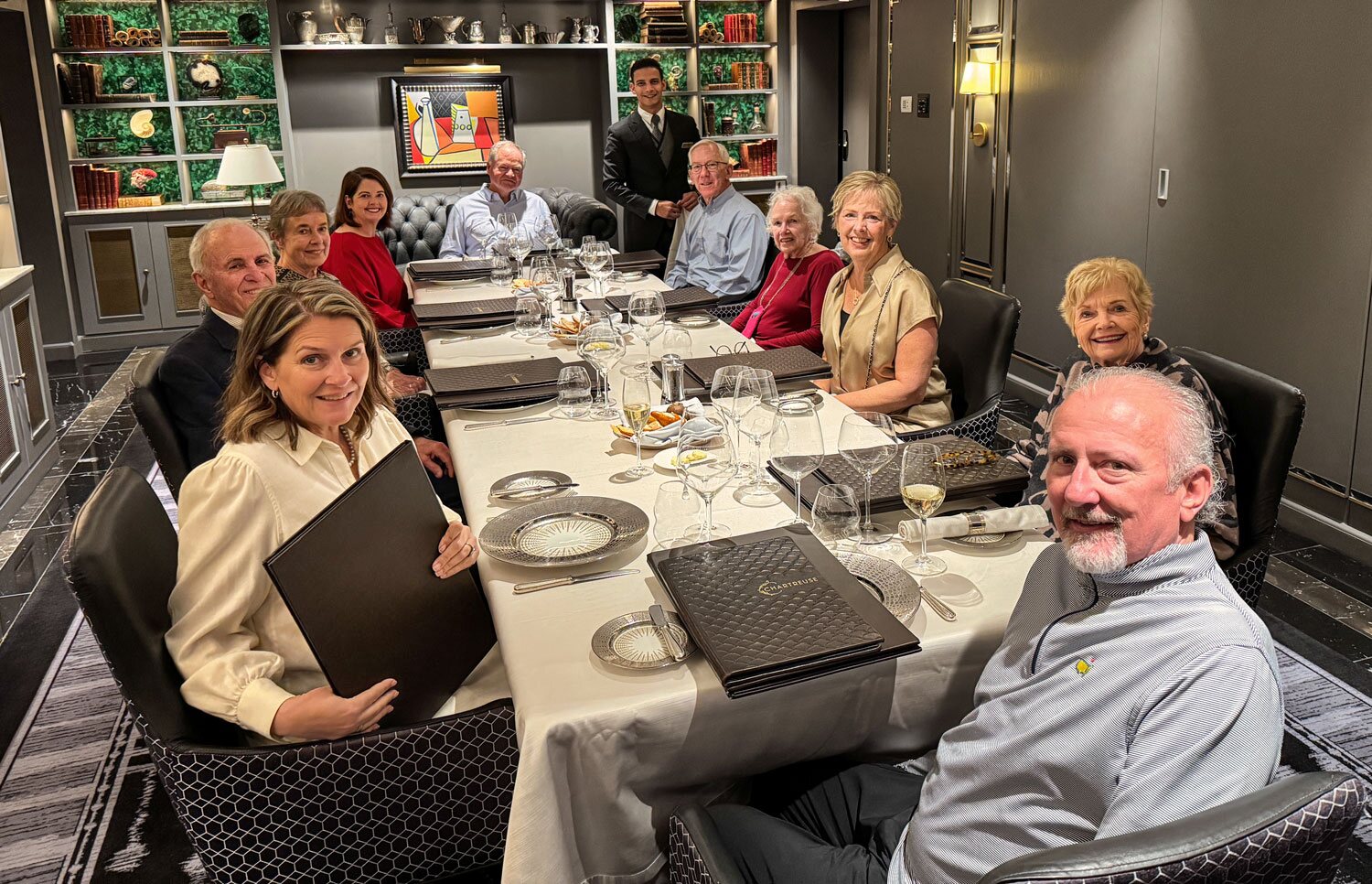
It was a lovely evening, and we were all surprised as we finished, seeing that it was 10 pm. After dinner, it was to bed. We're heading to Nagasaki tomorrow.
+++++++++++++++++++++++++++++++++++++++++++++++++++++
2/28/2025 (Friday) The ship entered Nagasaki via the Urakami River and we docked about 8am. After breakfast, we went to the theater to get our bus assignments and headed out. It took some time to clear immigration at the port, but we started the tour about 9:30am.
+++++++++++++++++++++++++++++++++++++++++++++++
When you hear the city name Nagasaki, an American will almost always think of the atomic bombing of Japan: August 6, 1945 for Hiroshima and August 9th for Nagasaki. So before I begin describing the tours, let me talk about what led up to the bombing.
It more or less begins with the 1853 arrival of the Black Ships, commanded by Commodore Perry. The Japanese recognized that the rest of the world was much further advanced, technologically, than they were and that they needed to advance or they would become a colony of one of the western powers.
This led to the overthrow of the Shogunate and the Meiji Restoration - the return of Imperial power to the emperor.
The country embarked on a modernization program and by 1900, less than 50 years after Perry's arrival in Japan, it had created a modern army and navy that could rival any western nation.
But Japan had some serious problems. Japan's population was only about 44 million people in 1900, and Japan did not have much in the way of natural resources. For example, there are essentially no oil resources in Japan.
[Contrast this to the modern situation with China. China has about 1.4 billion people and very significant natural resources.]
This led Japan to begin extending its power over its neighboring countries to obtain and control the resources they needed. After about 1900 Japan's foreign policy became increasingly expansionist and imperialistic. In 1904 they fought the Russo-Japan War and defeated Russia. By 1910 Japan had annexed Korea and began moves in northern China.
In 1931, they attacked China and continued to expand the area they occupied until the end of World War II.
Japan's attack on the United States resulted from the United States cutting off oil exports to Japan.
As the Pacific War developed, the United States gradually closed the noose around Japan, cutting off their imports and conquering lands closer and closer to Japan. The conquest of Okinawa demonstrated how fanatical the Japanese soldiers and civilians could be. About 94,000 Japanese soldiers died in that battle (only about 7,500 were captured, most too wounded to resist) and 100,000 to 150,000 civilians died, some committing suicide by jumping off a cliff. From one-quarter to one-half of the local civilian population died.
The atomic bomb was known to very few people, and the US military began planning for the invasion of Japan, starting with the island of Kyushu. It was obvious to the Japanese military that Kyushu would be the site of the invasion and they moved troops and equipment to the island. Japanese civilians were trained to attack with whatever they had, including farm implements.
The Japanese military leaders' plan was to make the invasion so costly to the Allies that better surrender terms would be offered (the Allies demanded "unconditional surrender". Japan wanted retention of the emperor, no foreign troops in Japan, and any trials of Japanese for war crimes to be handled by Japanese courts). To achieve this the military leaders were willing to sacrifice a significant number of Japanese soldiers and civilians.
The invasion was code named Operation Downfall. The estimates were that about one million Allied soldiers would be casualties, with about half being killed (500,000 KIA). Note that the total number of US soldiers killed in WWII was slightly over 400,000, with about 250,000 of those death in the European theater. 500,000 killed in occupying Japan would have caused significant blowback from families in the US.
The estimates for casualties to Japan were that the majority of the 2.3 million Japanese soldiers expected to oppose the invasion would be killed, along with more than a million Japanese civilians, maybe much more. The Japanese military estimated that as many as 20 million Japanese soldiers and civilians could die.
In the face of this, the United States decided to use the Atomic bombs, bombing Hiroshima on August 6 and Nagasaki on August 9th.
Russia had not declared war on Japan because it was focused on defeating the Germans on the eastern front, but with the defeat of Germany on May 8th, they declared war on Japan. Some people claim that it was Russia's entry into the war that convinced Emperor Hirohito to accept the Potsdam declaration (to surrender) but the Imperial Rescript of August 14th only mentions that "the enemy has begun to employ a new and cruel bomb, causing immense and indiscriminate destruction, the extent of which is beyond all estimation" as a reason for surrendering. It makes no reference to Russia.
Most modern historians agree that the use of the atomic bombs saved the lives of many more people, American and Japanese, than were killed by the bombs. [Added note: About 140,000 people were killed by the atomic bomb in Hiroshima, and about 74,000 were killed in Nagasaki. That includes deaths over the first year from radiation exposure. By comparison, at least 100,000 people were killed in the firebombing of Tokyo on March 9, 1945.]
[A good book that covers the final year of the Pacific war is "Retribution: The Battle for Japan, 1944-1945", by Max Hastings.]
+++++++++++++++++++++++++++++++++++++++++++++++
The tour took us first to the Nagasaki Peace Park. The 10 meter tall Peace Statue was created by sculptor Seibo Kitamura.
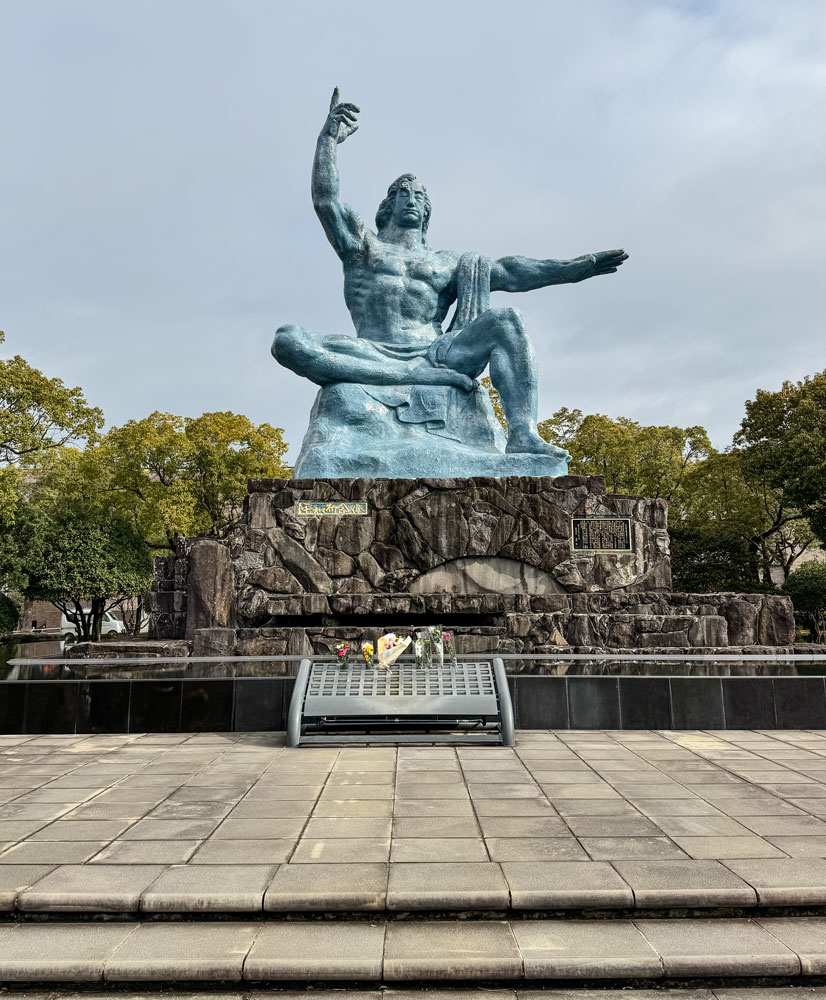
A wider view of the area of the Peace Statue.
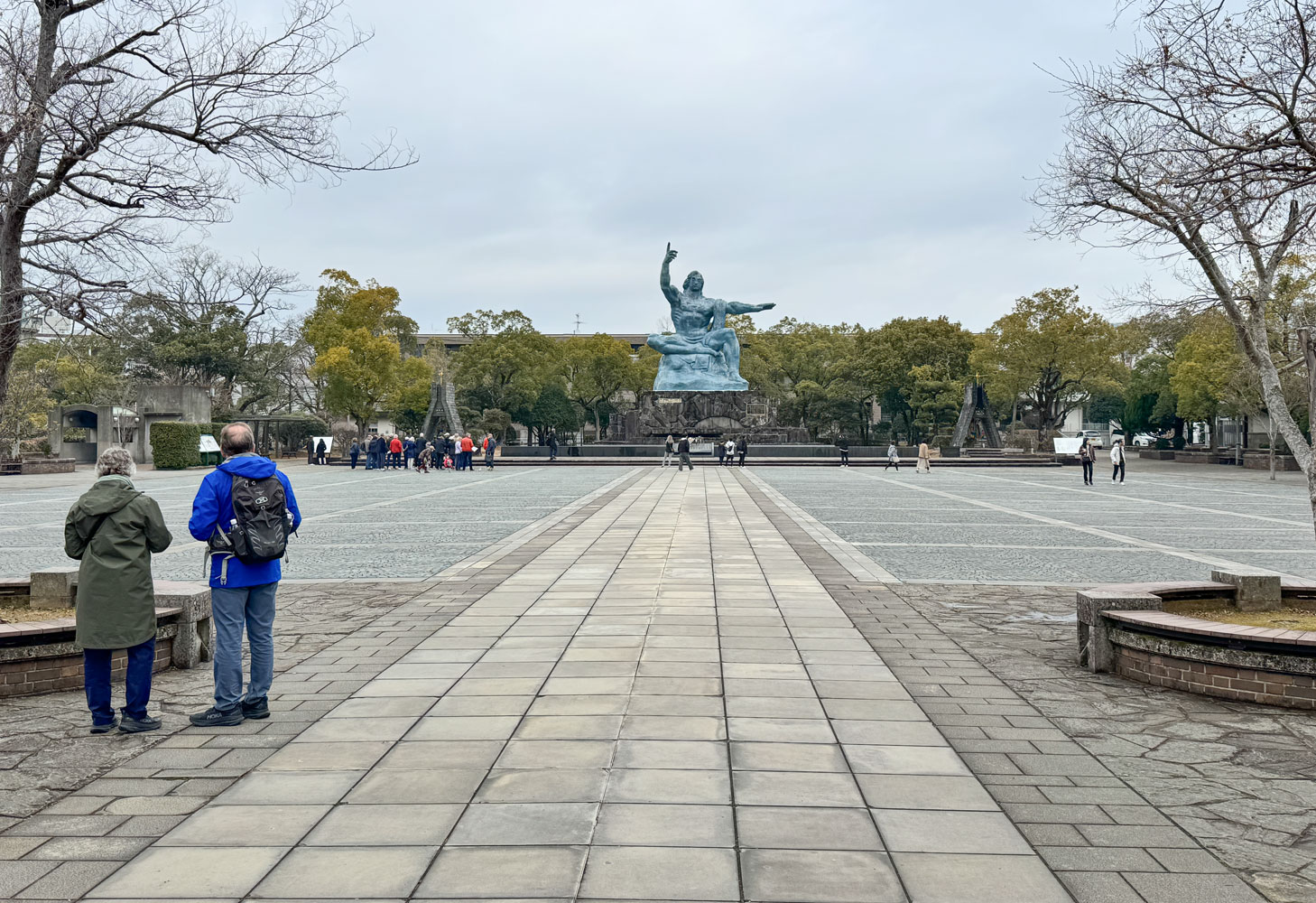
Some other statuary in the park.

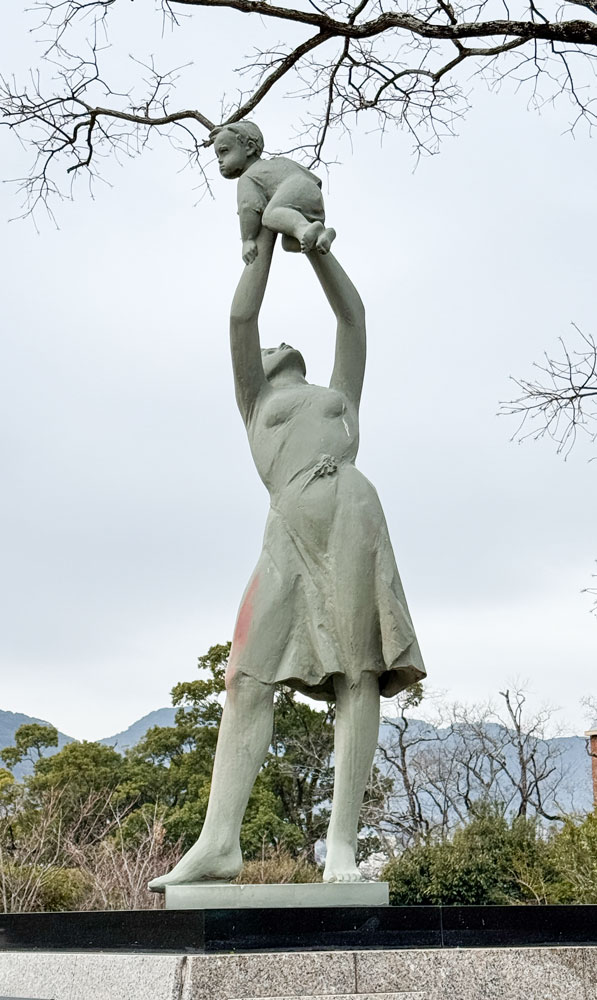
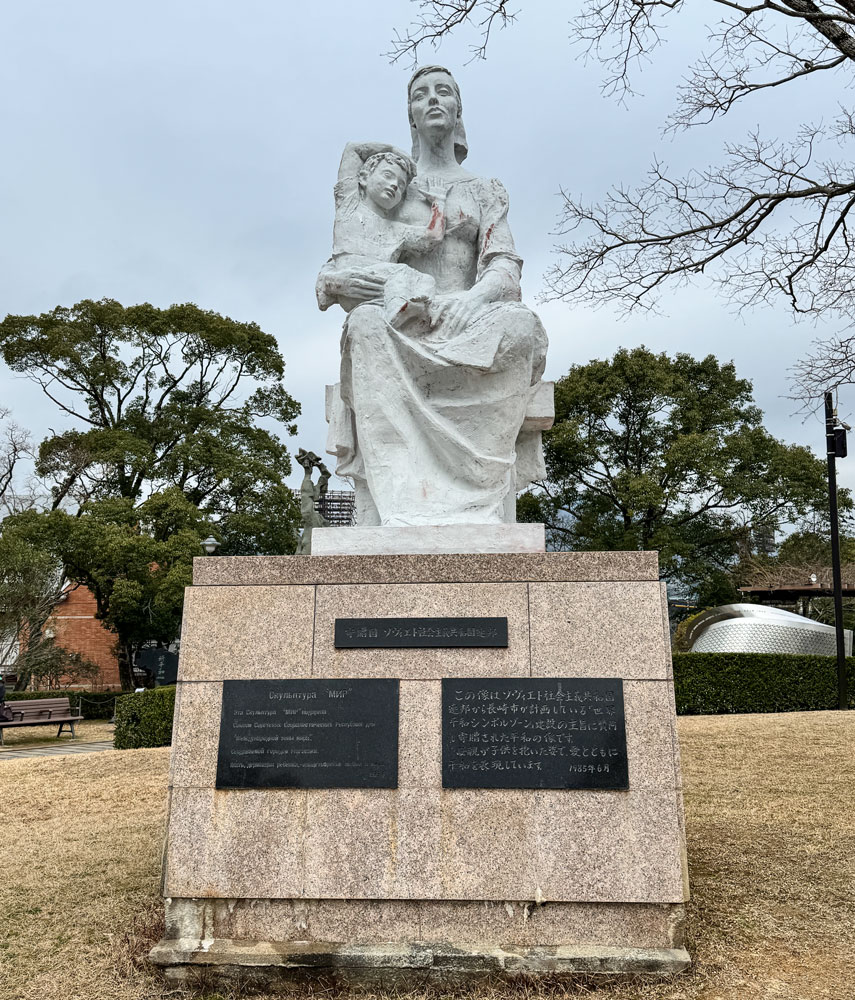
A fountain in the park.

After leaving the park we went to another smaller park which was located at the hypocenter of the explosion. The bomb, Fat Man, was dropped by the B29, "Bockscar". A parachute was used to slow the descent to give time for the aircraft to get clear of the explosion. The bomb was triggered at 500 meters above the ground, and that's why this location is called the hypocenter - it's directly below where the bomb was when it exploded. Note that Nagasaki was not the primary target. The primary target was Kokura, but it was obscured by clouds. Incidentally, the target cities for the atomic bombs were chosen based on several criteria, but one criterion was that the city was generally undamaged by previous bombing, so that the destruction caused by the atomic blast could be better evaluated.
I believe this monument is supposed to represent the hypocenter of the explosion.
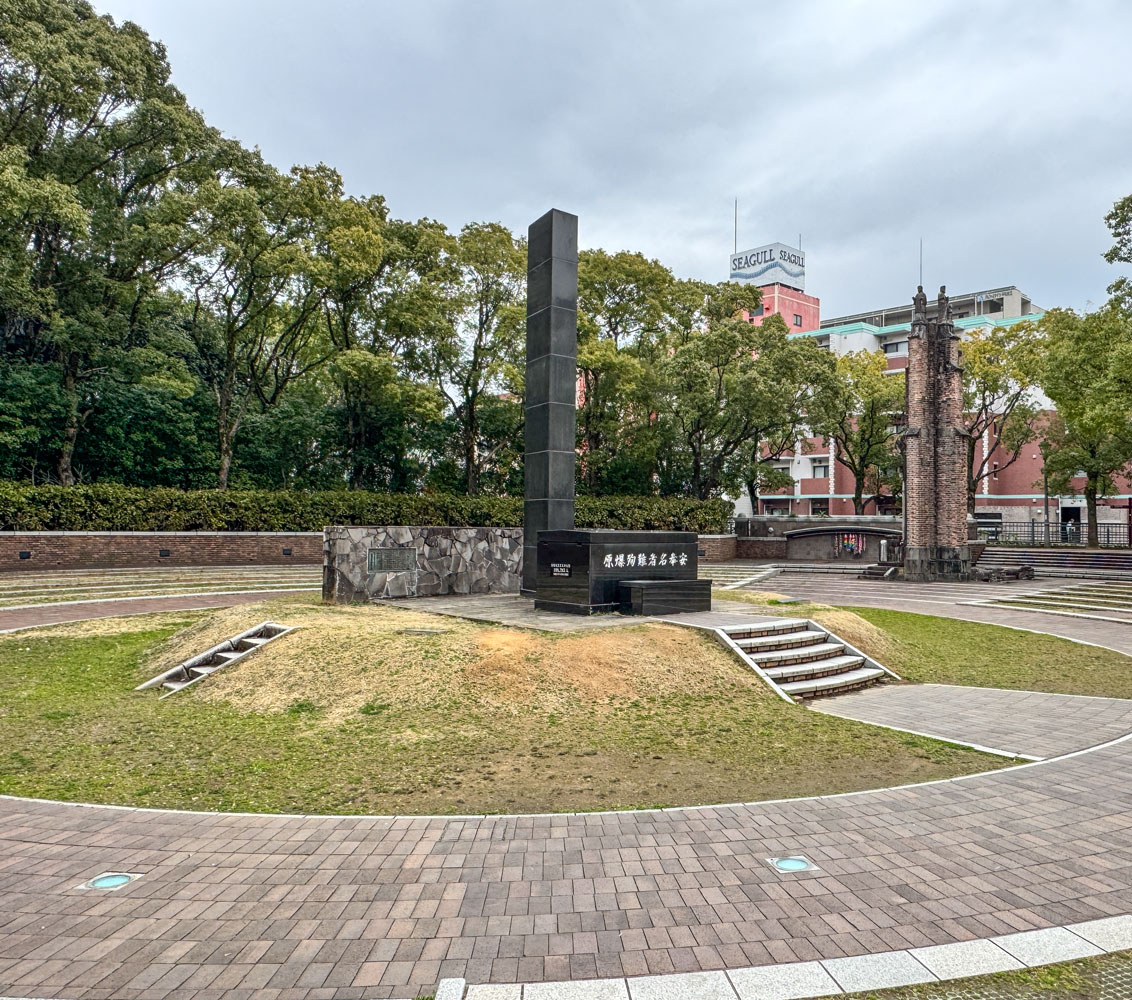
A statue at this site. Note that the plaque gives the date and time of the explosion: 11:02am on August 9, 1945.
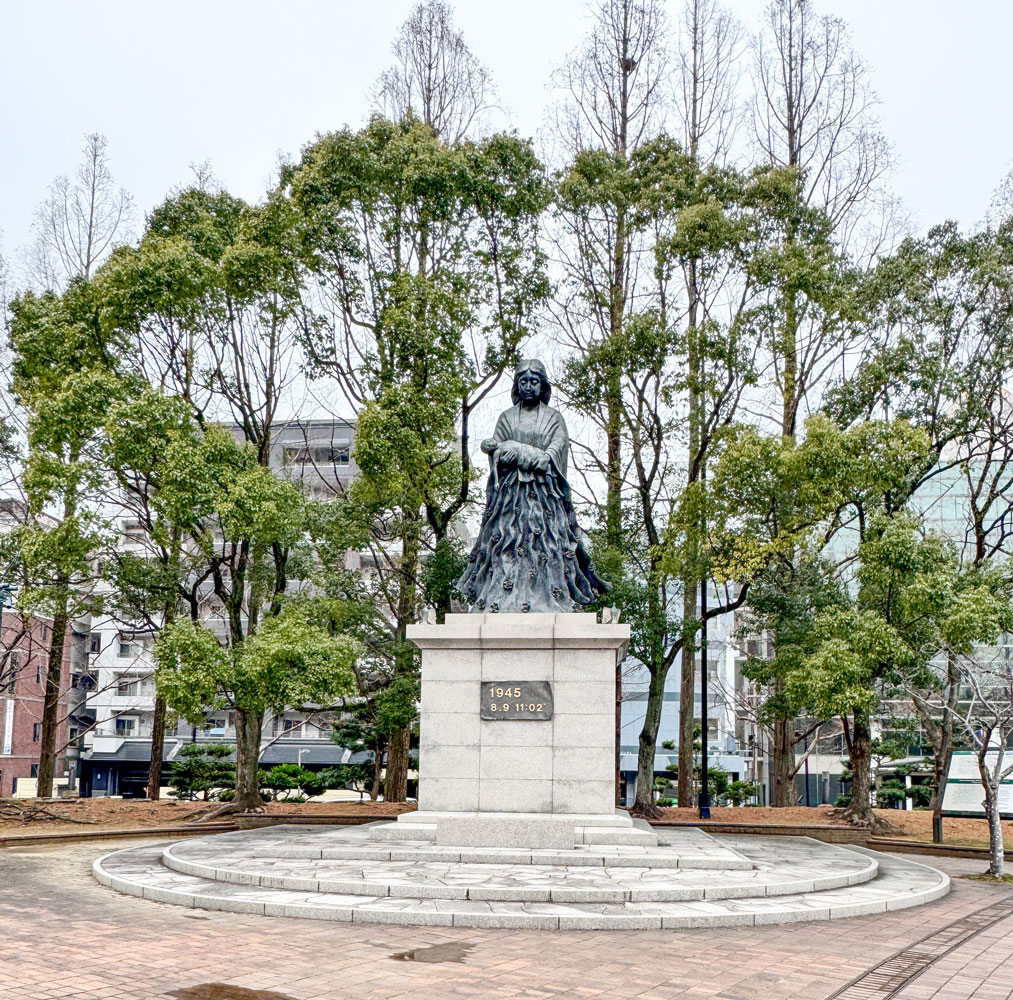
Next, they took us to the Immaculate Conception Cathedral (Urakami Cathedral). The original church was destroyed in the atomic bombing and it was rebuilt in 1959.
I'm not sure why they took us here. There wasn't much to see and they didn't allow photography in the church.

We then went to the Nagasaki Ropeway to go to the top of Mount Inasa. While it's called a "ropeway," it is actually a standard cable car system with steel cables.
Here's one of the cable cars arriving at the lower station.
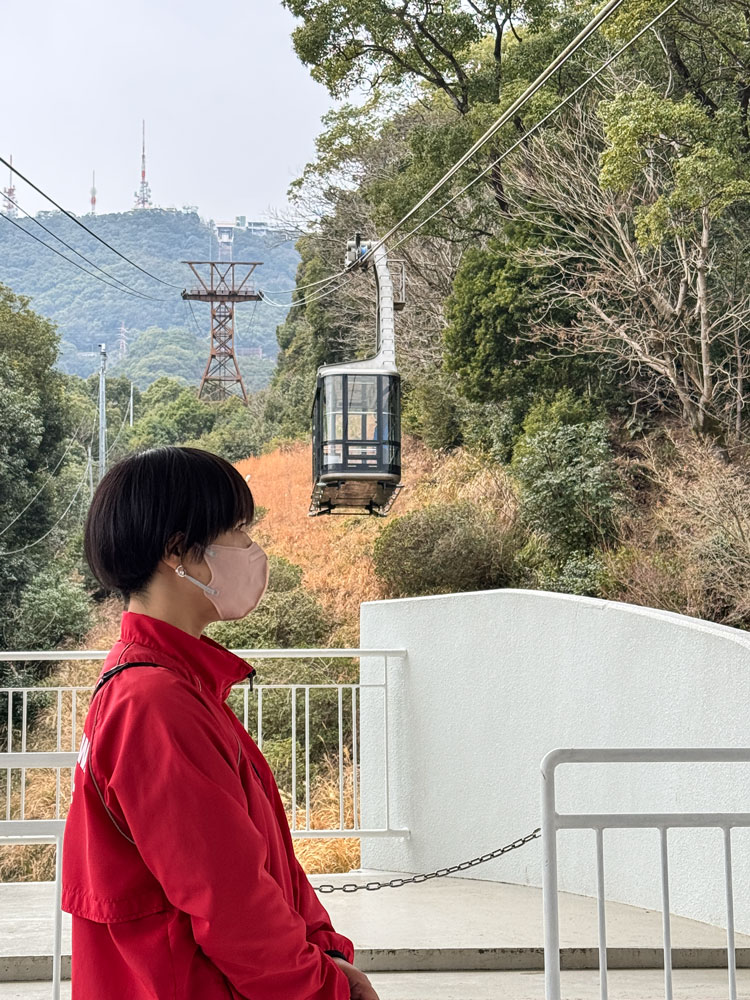
I was in the front of the car and took a few pictures as we went up.

A small part of the city below us.
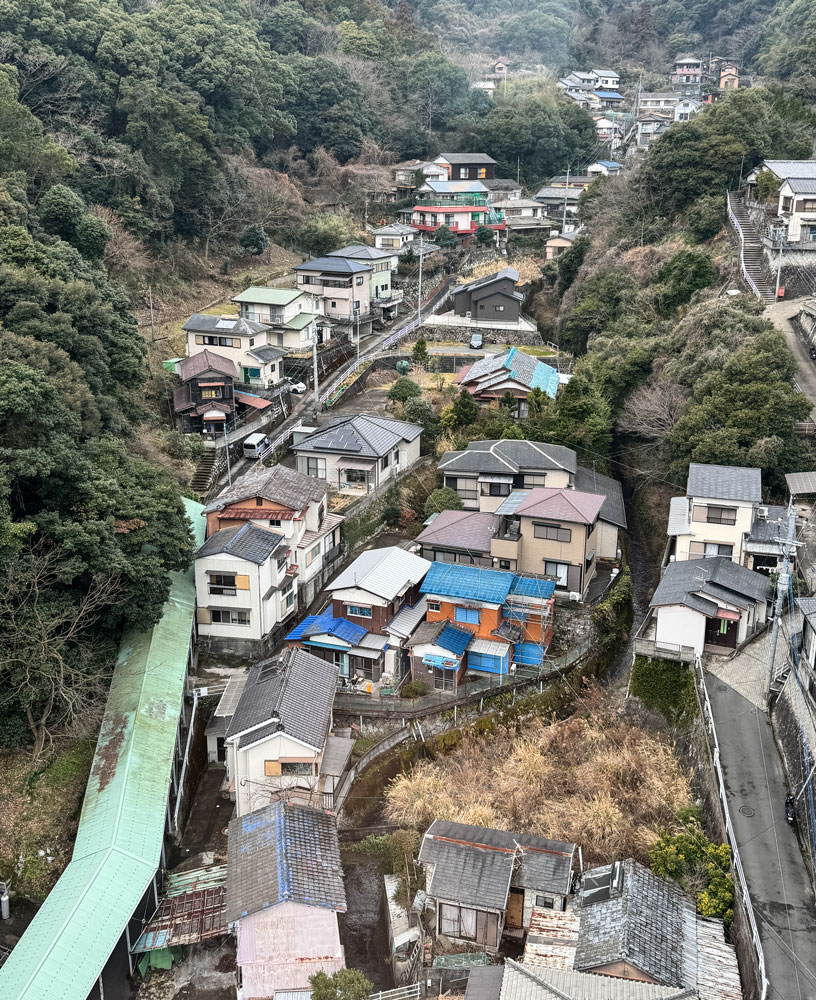
Approaching the upper station.
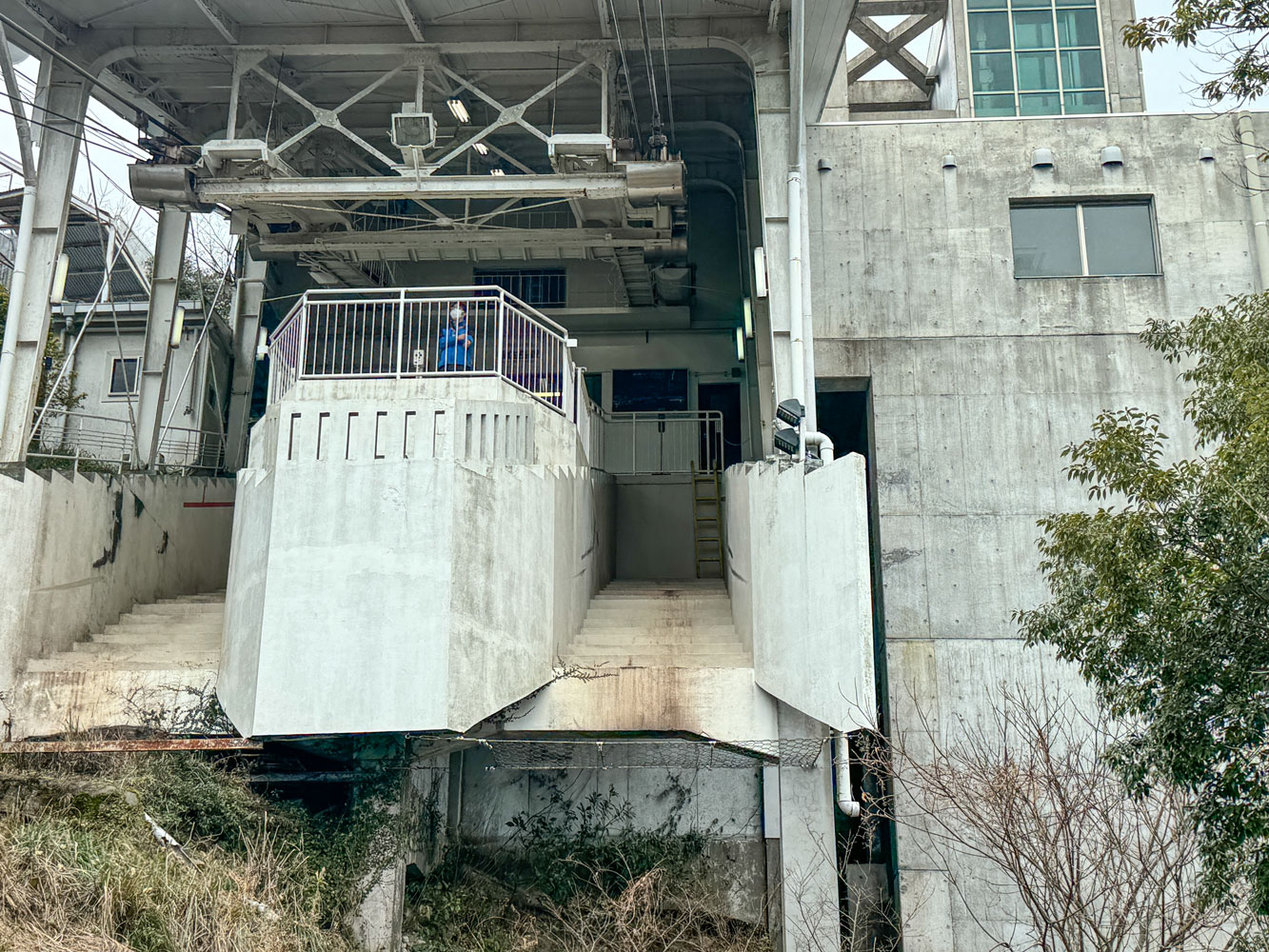
A building at the top of the mountain. We reached the roof of this building by elevator.
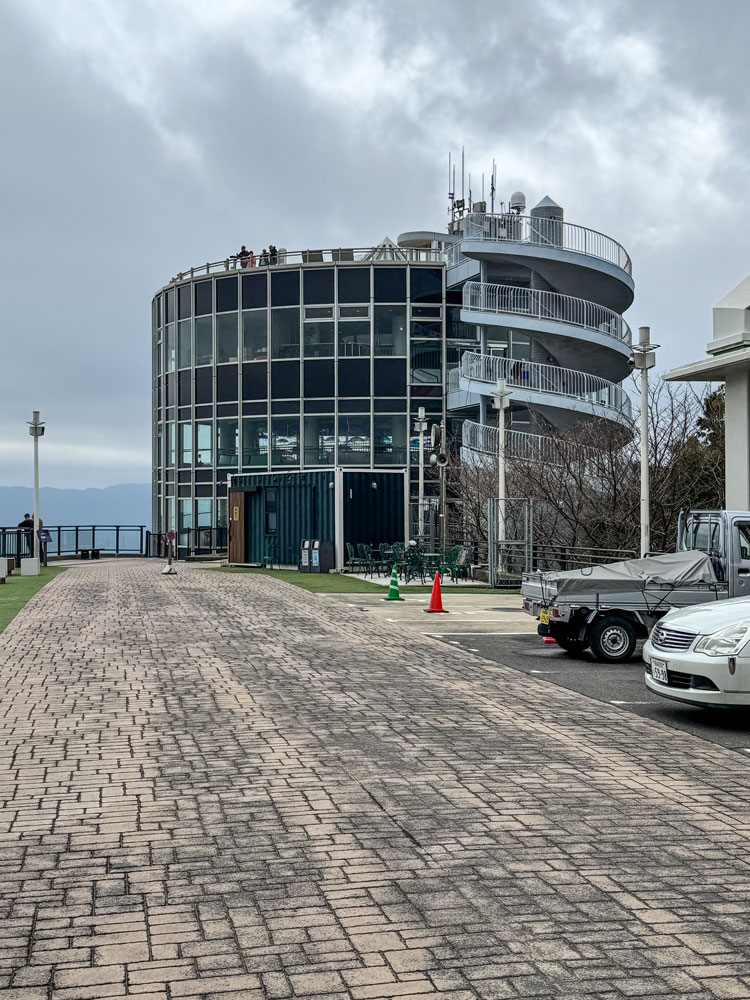
A panoramic shot from the top of the mountain.
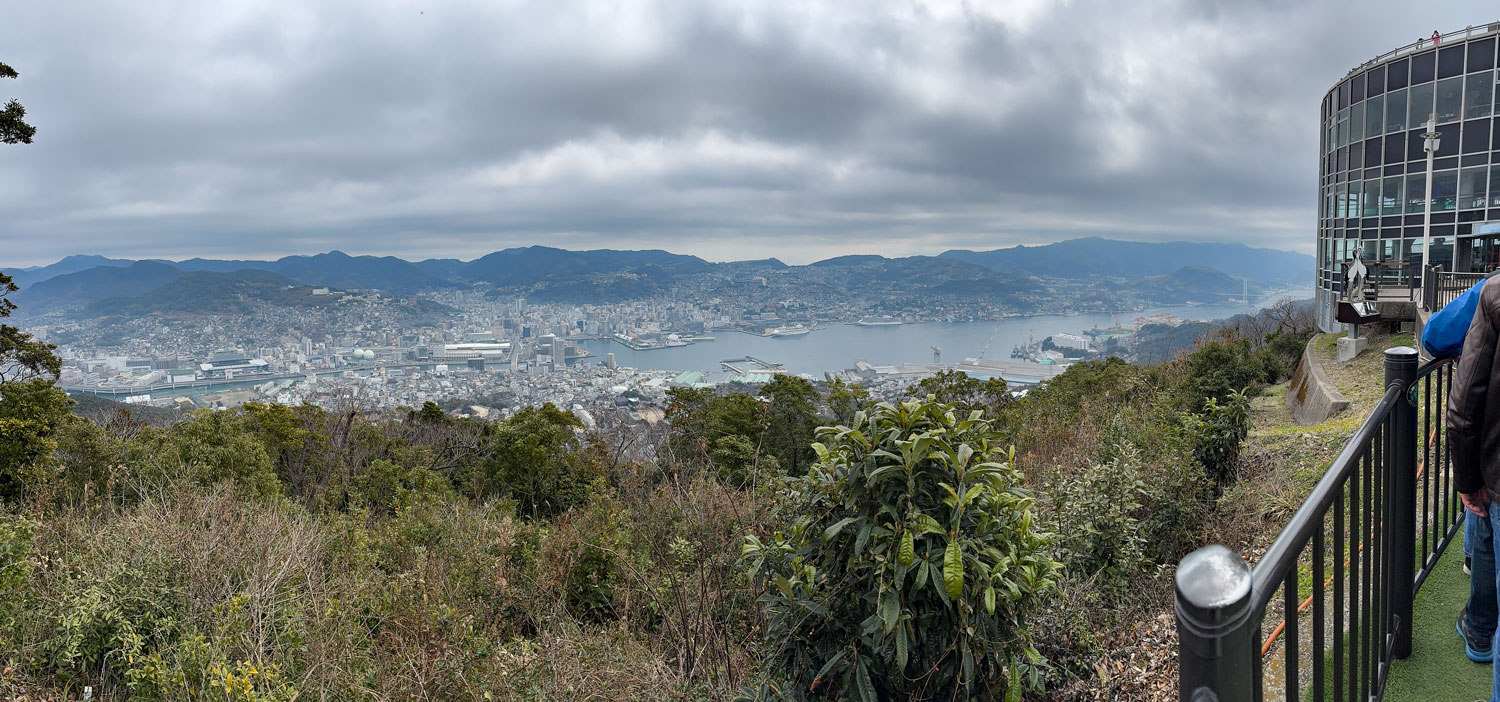
Another one.

We could see the Explorer at dock from here.
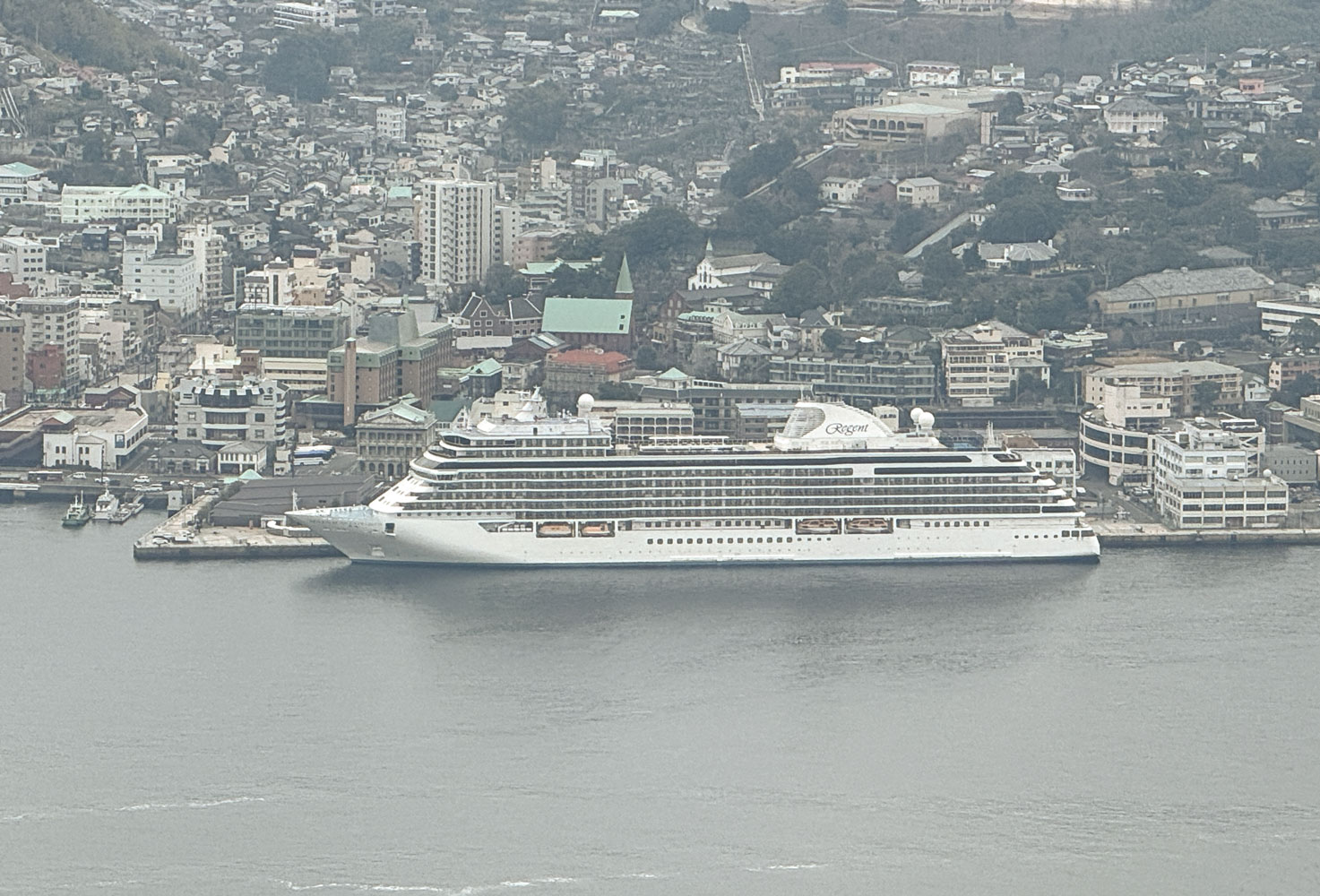
Being an engineer, I took a picture of the radio and TV towers on the top of the mountain.
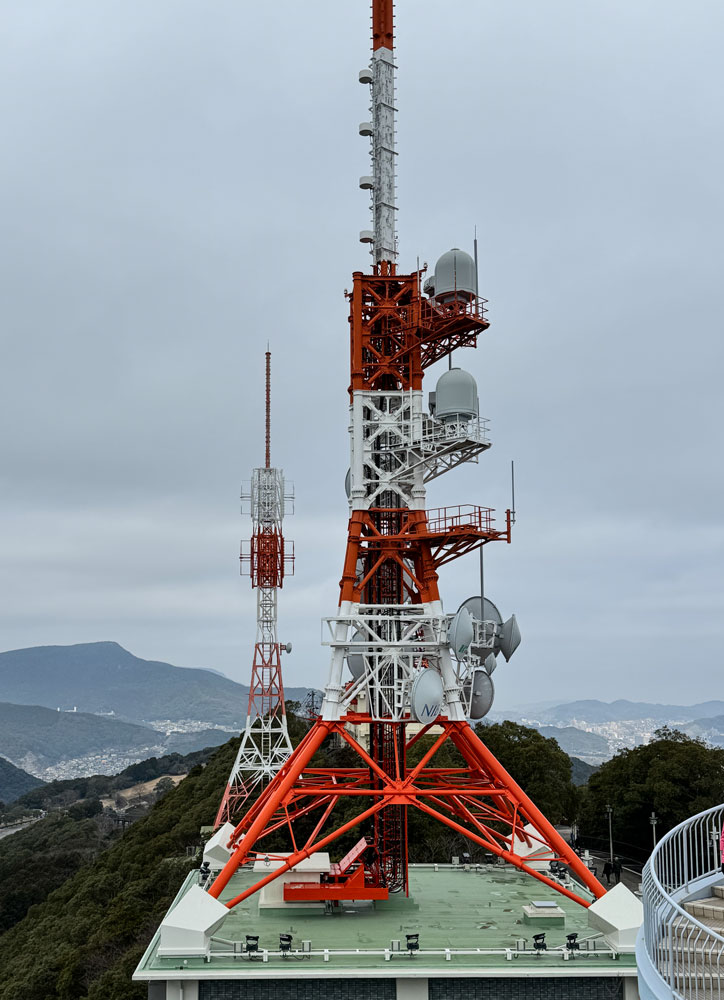
On the way down I took a few more pictures. Here's a little pocket of the city.
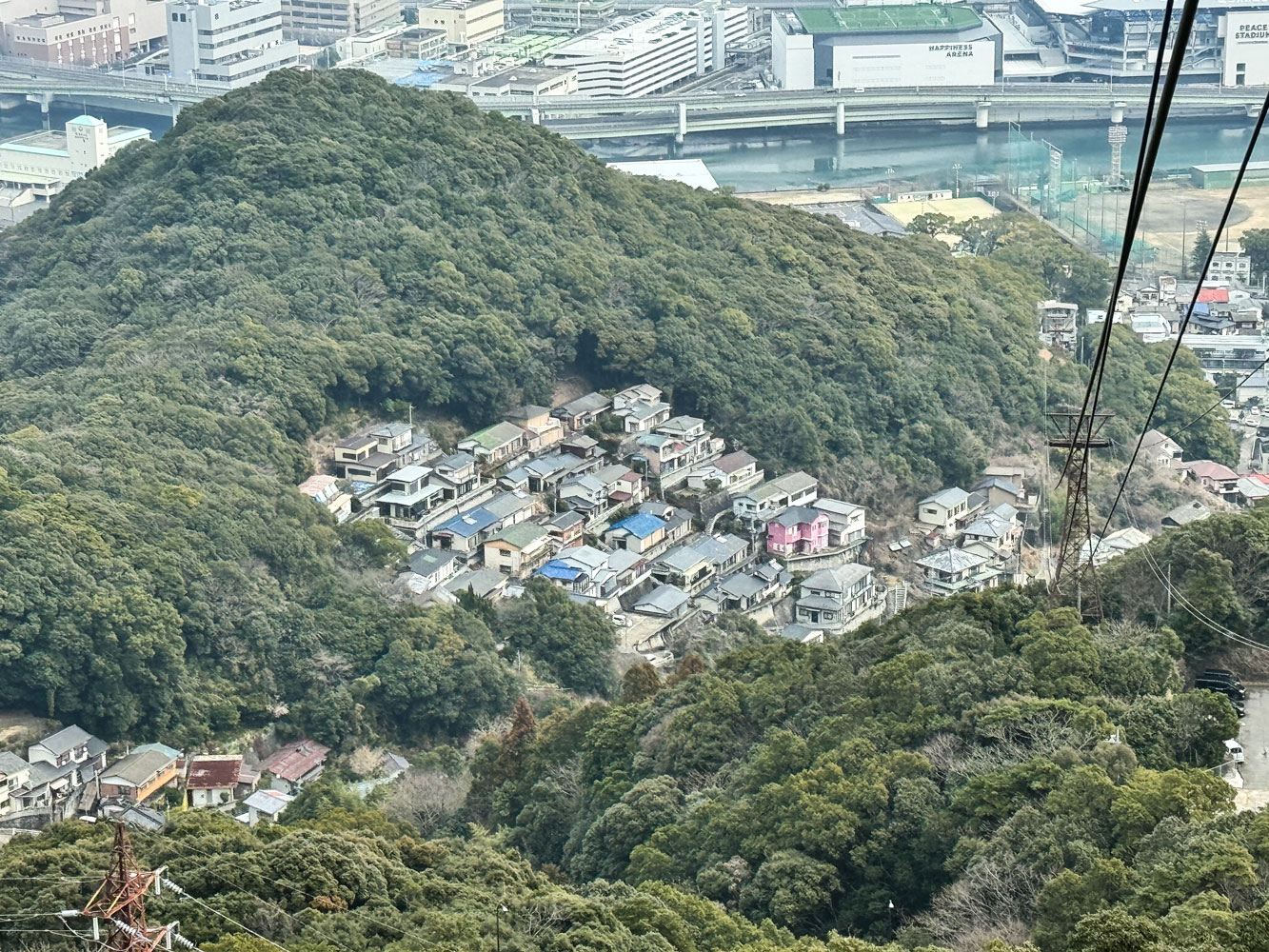
Look at those steps to get to the higher level houses. No way to drive there.
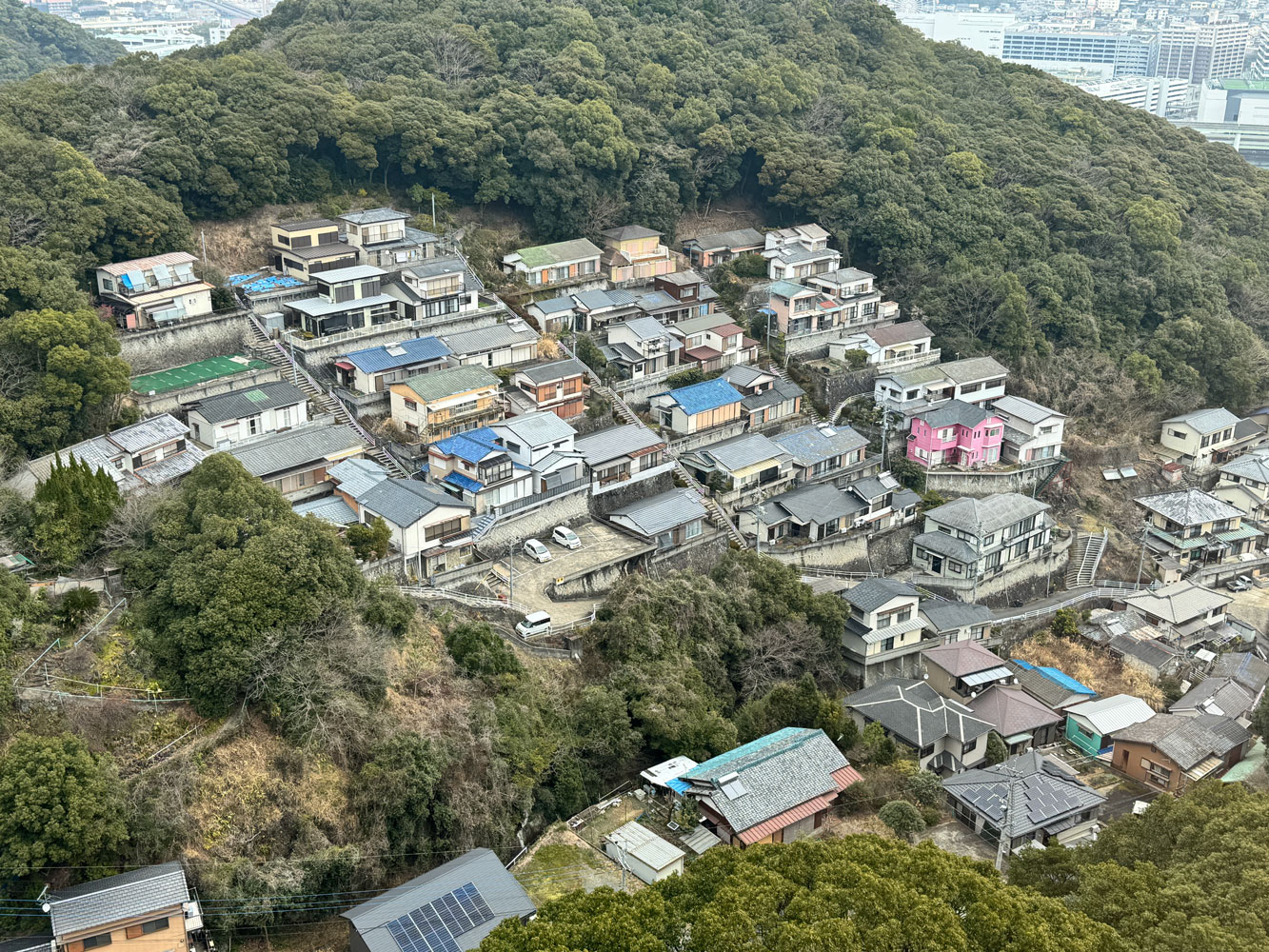
Next to the lower cable car station there is a shrine.
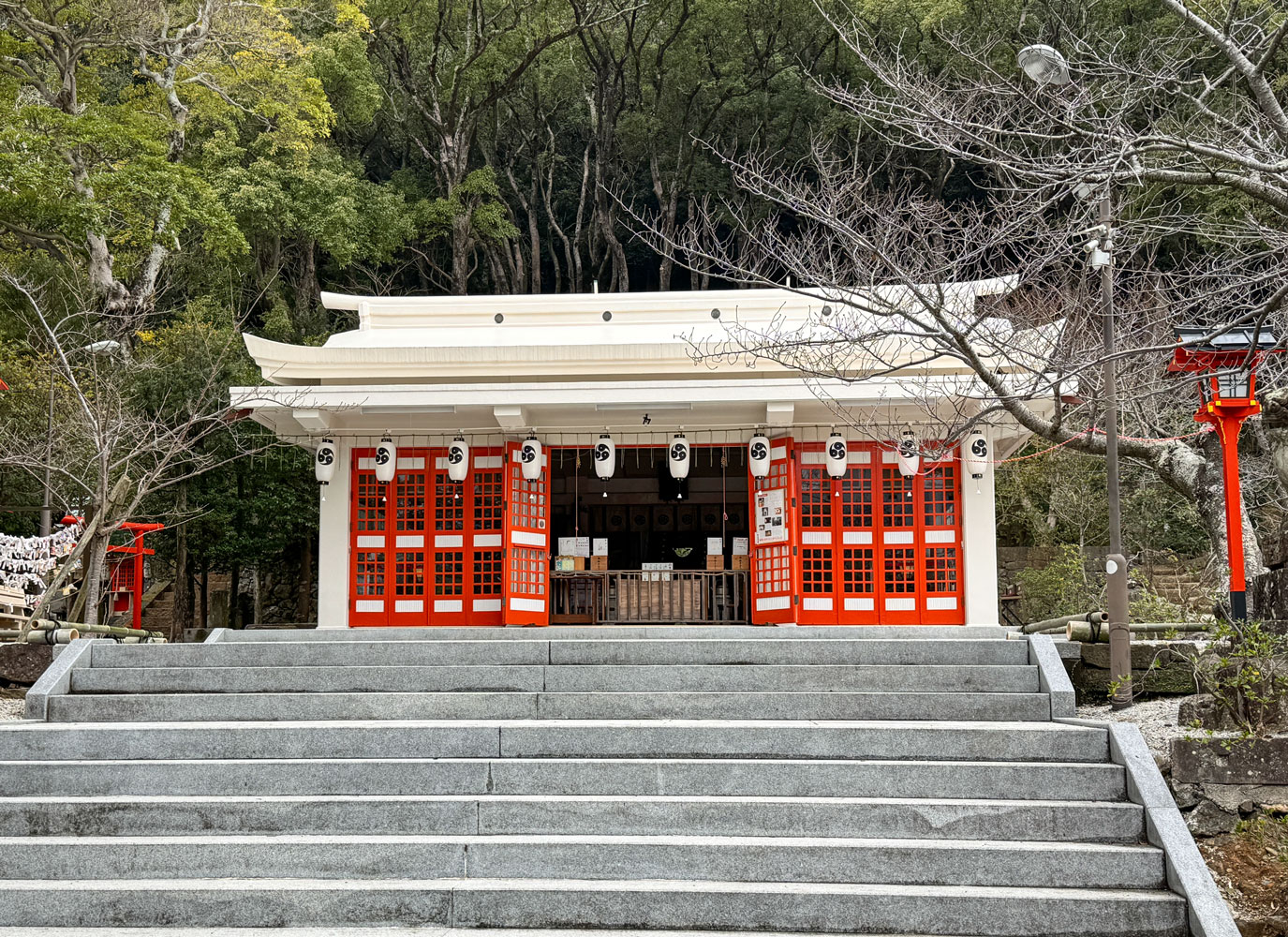
A view into the shrine.
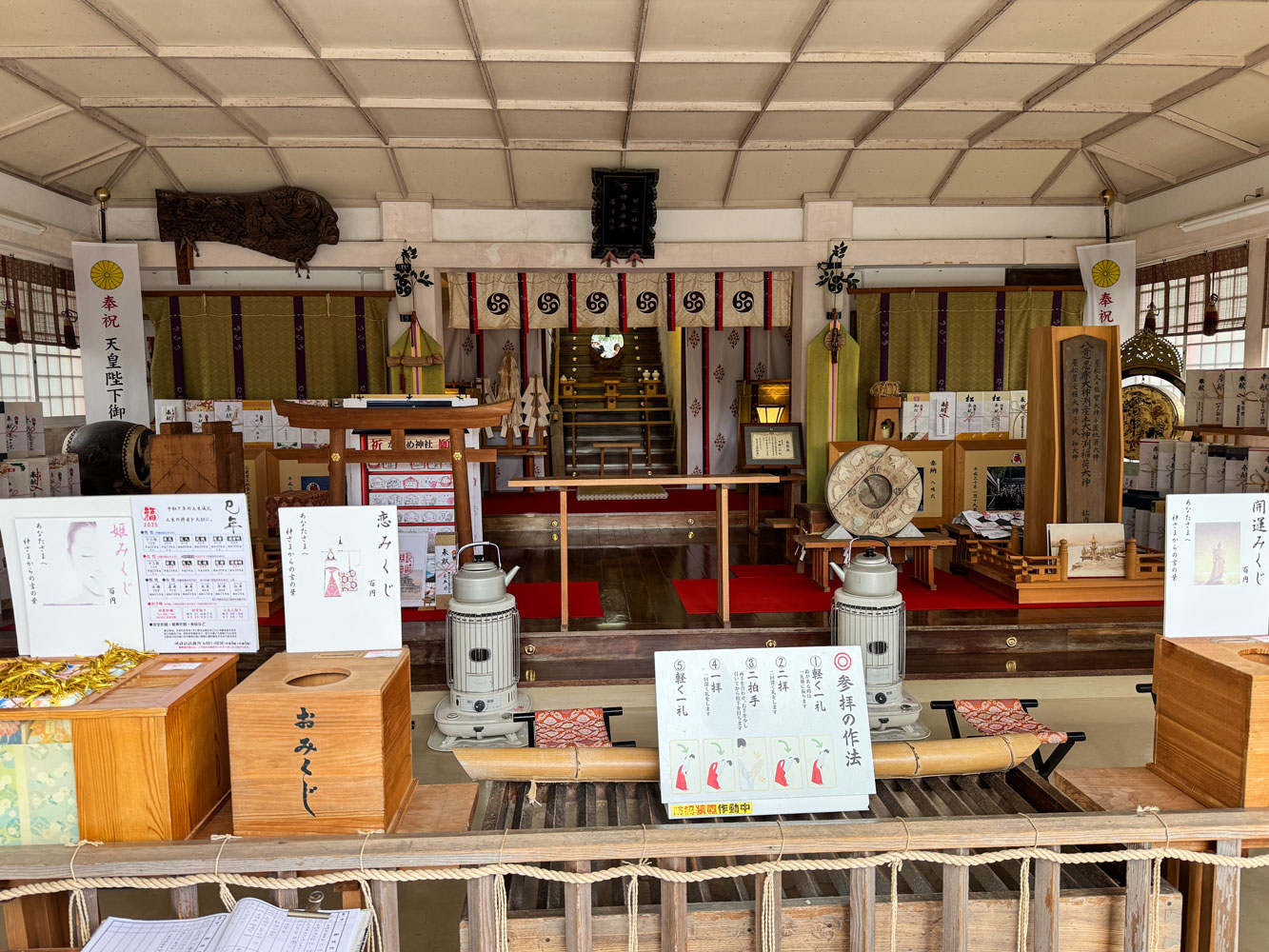
Finally, they took us to a reproduction of a Dutch trading village.

One of the actors at the entrance.
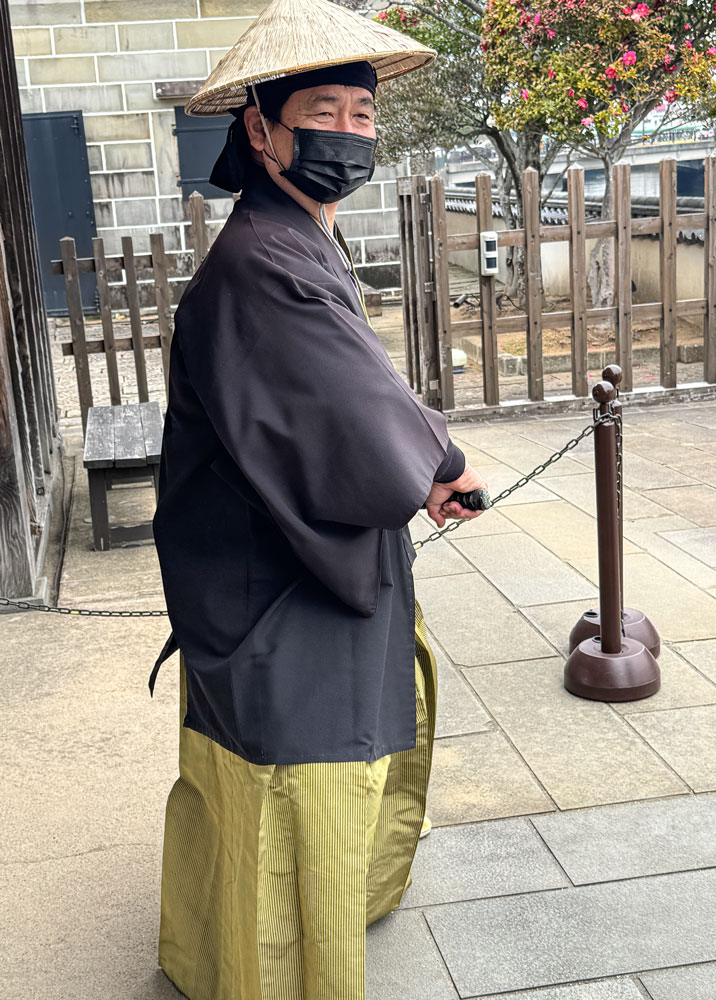
It was not very interesting so I didn't take any pictures worth putting here. We headed back to the ship, had lunch and then played Trivia in the afternoon.
We departed about 5pm and sailed out the Urakami River, and under the Megami cable-stayed bridge.
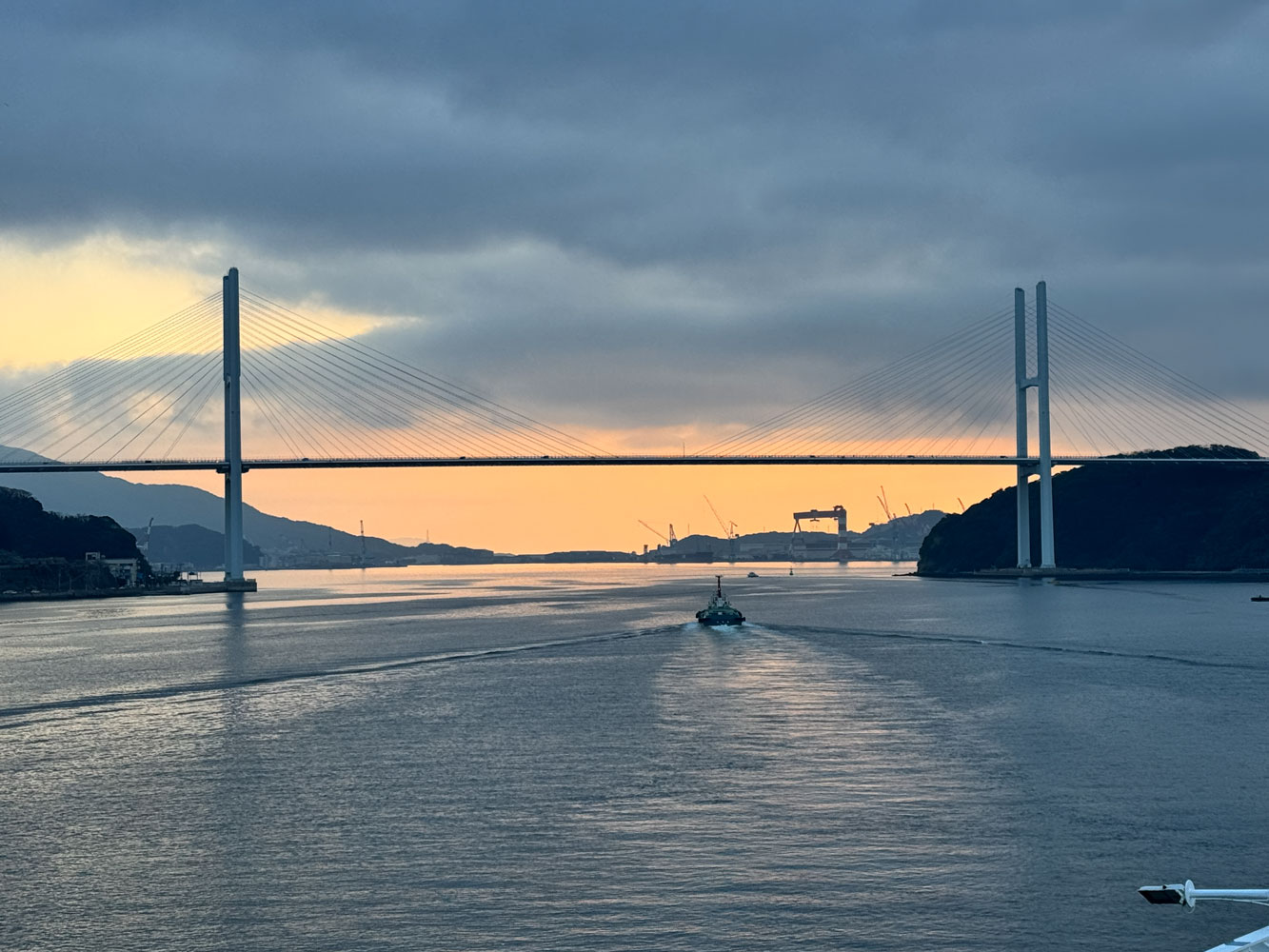
Judy took this picture after we had passed under the bridge and were heading into the open sea.
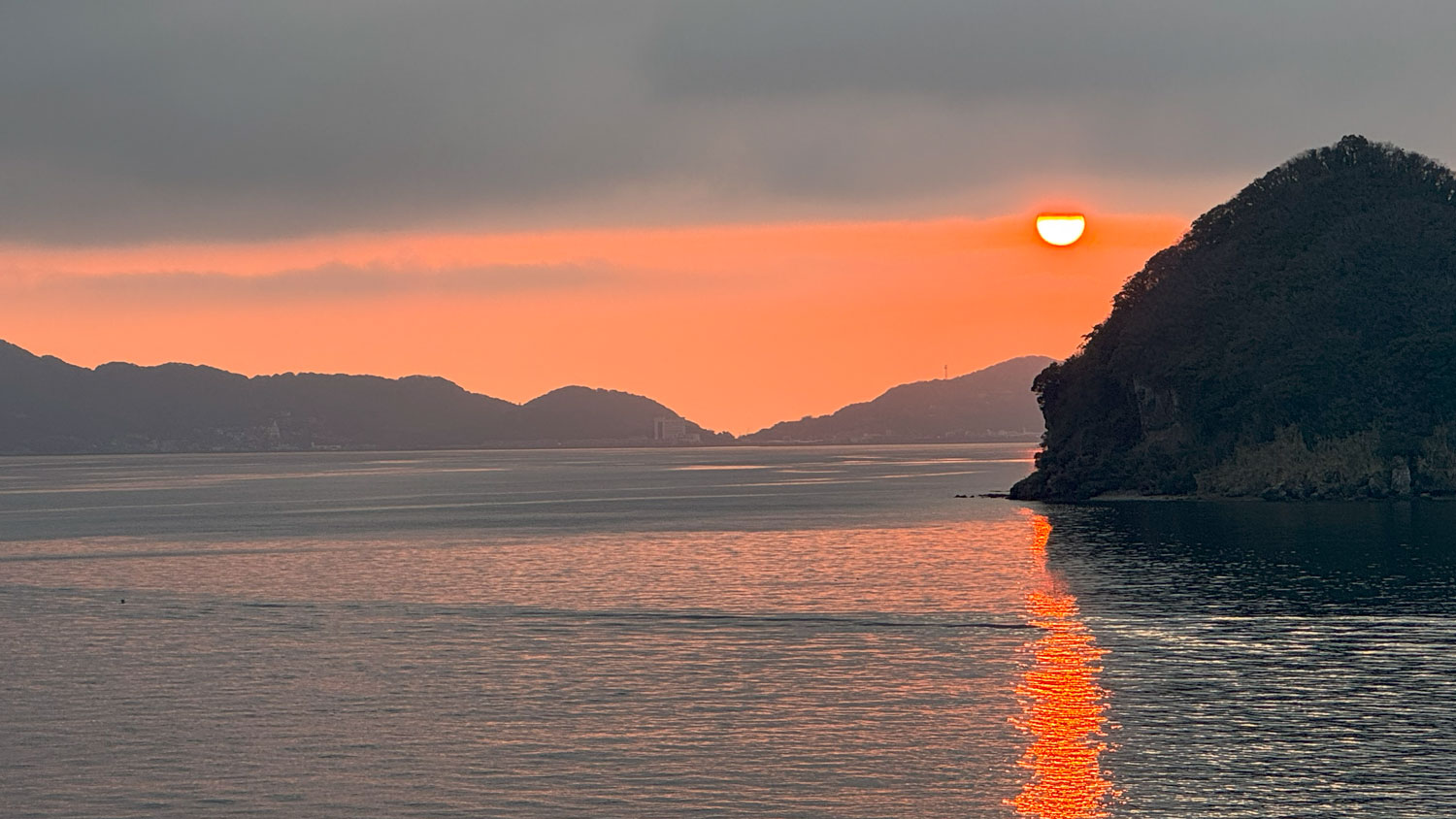
We went to dinner and then bed. Tomorrow is a sea day.
+++++++++++++++++++++++++++++++++++++++++++++++++++++
3/1/2025 (Saturday) We slept late this morning, being that it's a sea day. I worked on this blog and we took it easy. Played Trivia in the afternoon, but didn't do very well.
That was our day.
+++++++++++++++++++++++++++++++++++++++++++++++++++++
3/2/2025 (Sunday) We entered Osaka via the Aji River and docked about 7:30am, in a light rain, close to the Tempozan Ferris Wheel and the cable-stayed Tempozan Bridge. Here's a picture of the Tempozan Bridge.
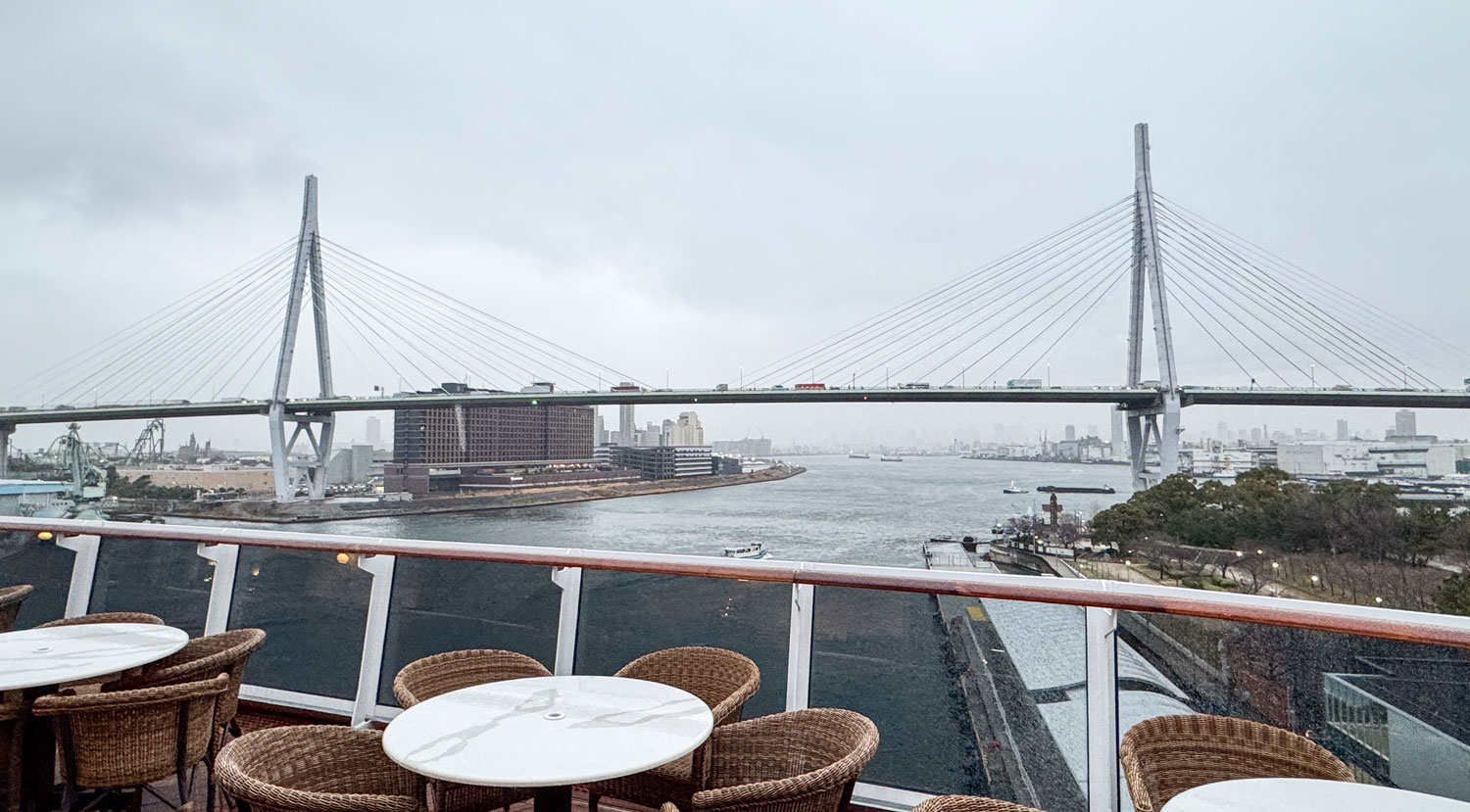
The Minato Bridge is also close by. It's an interesting structure - the third longest cantilevered bridge in the world.

It's a double-deck bridge. The unusual thing about this bridge is that the two decks carry traffic for two different roads, rather than alternate traffic for one road (e.g., east traffic on the top deck, and west traffic on the lower deck).

Here's a picture of the Tempozan Ferris Wheel, with the Tempozan Bridge in the background. The Ferris Wheel is huge - almost 370 feet high. When it opened in 1997 it was the tallest in the world.
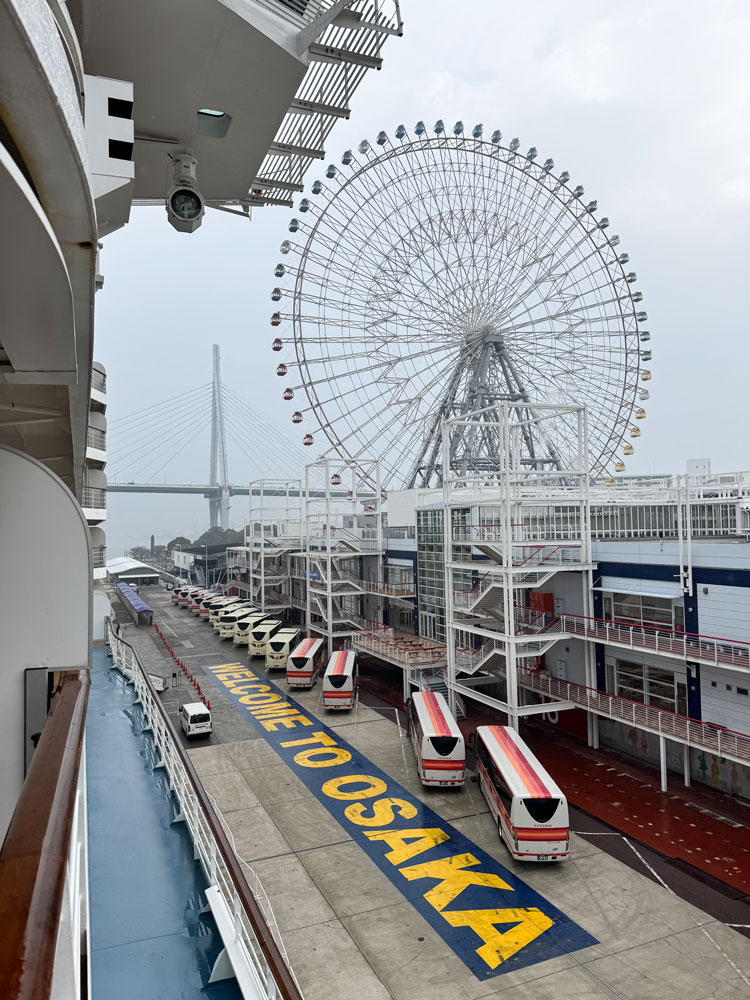
Ahead of us at the dock was this "sailing ship", the Santa Maria. It looks like it's used to take tourists around the bay.

After breakfast we went to the theater for our excursion bus tickets to Kyoto.
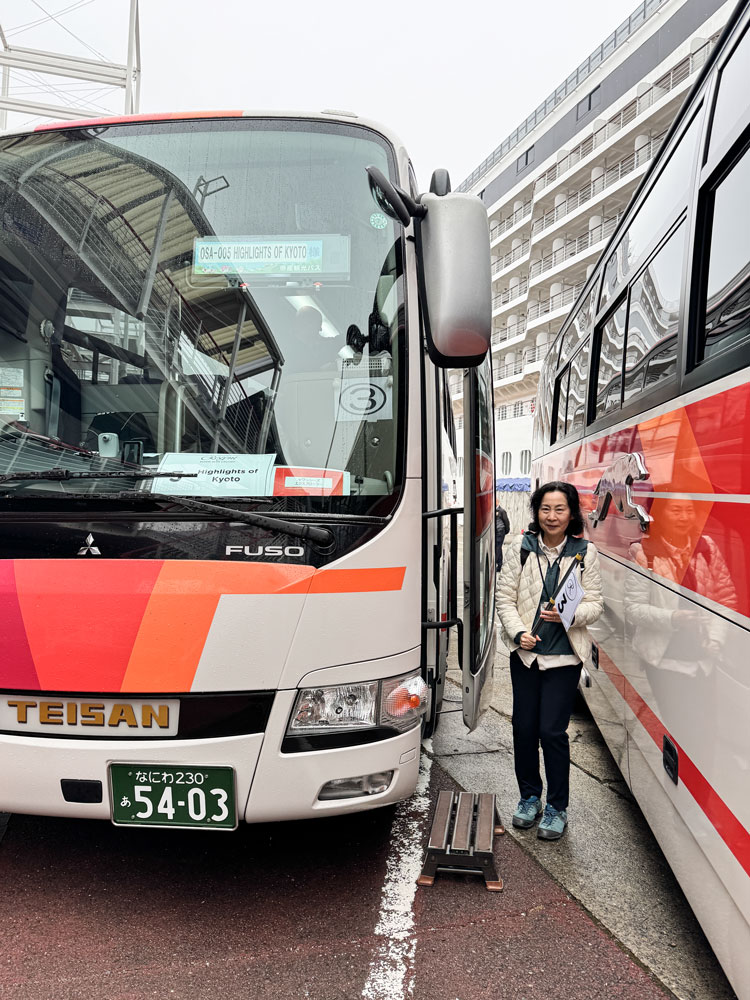
[Side note: Kyoto was at the top of the list for cities to be atomic bombed, but Secretary of War Henry Stimson fought successfully to remove Kyoto from the list. He felt that there were too many important cultural sites in Kyoto, and destroying them would cause the Japanese to resent the United States after the war.]
The drive to Kyoto was faster than expected. Today is Sunday and the traffic was light. We arrived at Nijo Castle in Kyoto about 9:40am, in a light rain. It did stop raining while we were there.
Nijo Castle was built by Ieyasu Tokugawa and his grandson, completed in 1626.
Here's the entrance gate.
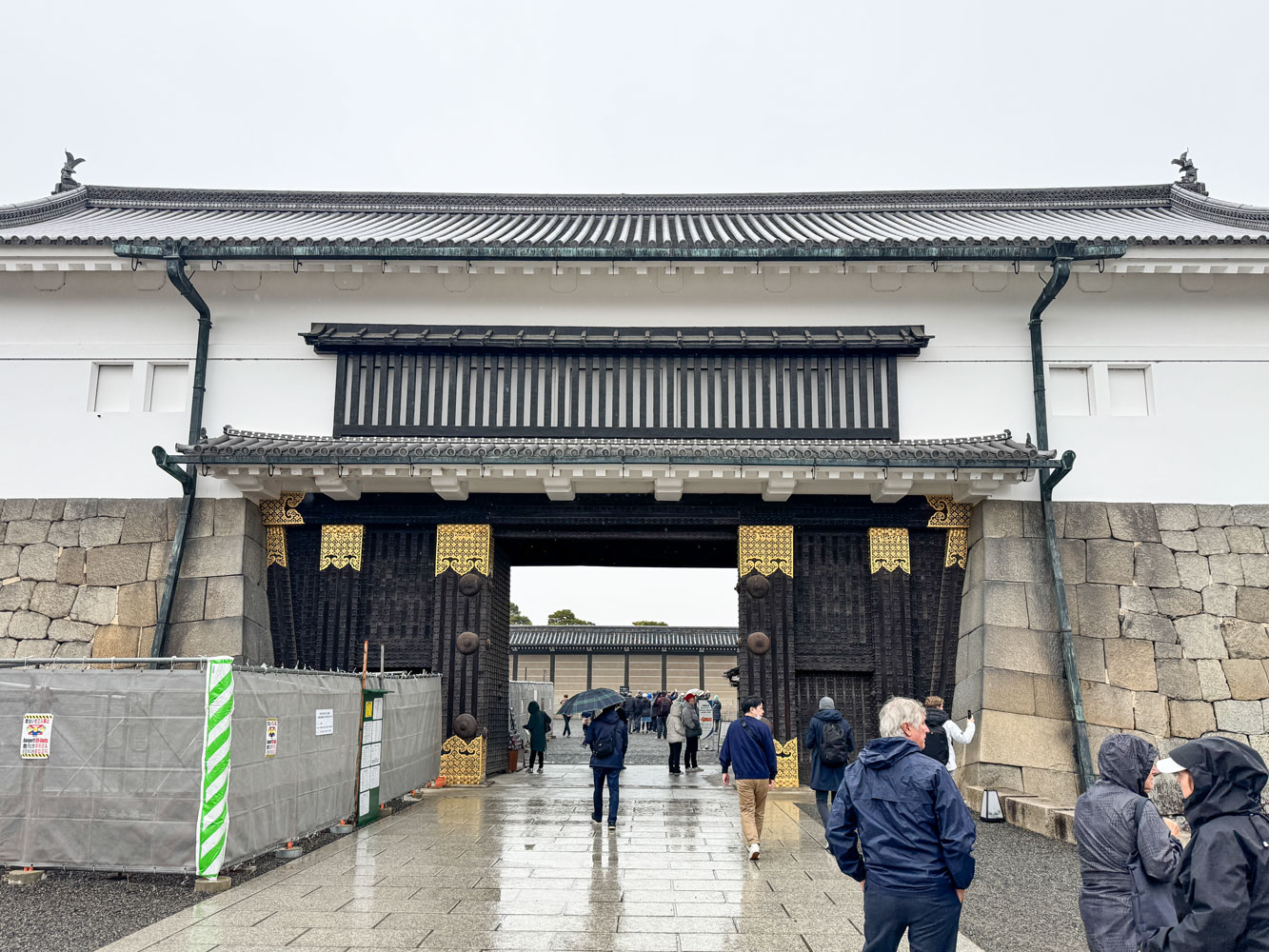
The gate to the inner keep. The entrance to the main part of the castle can be seen through the gate.
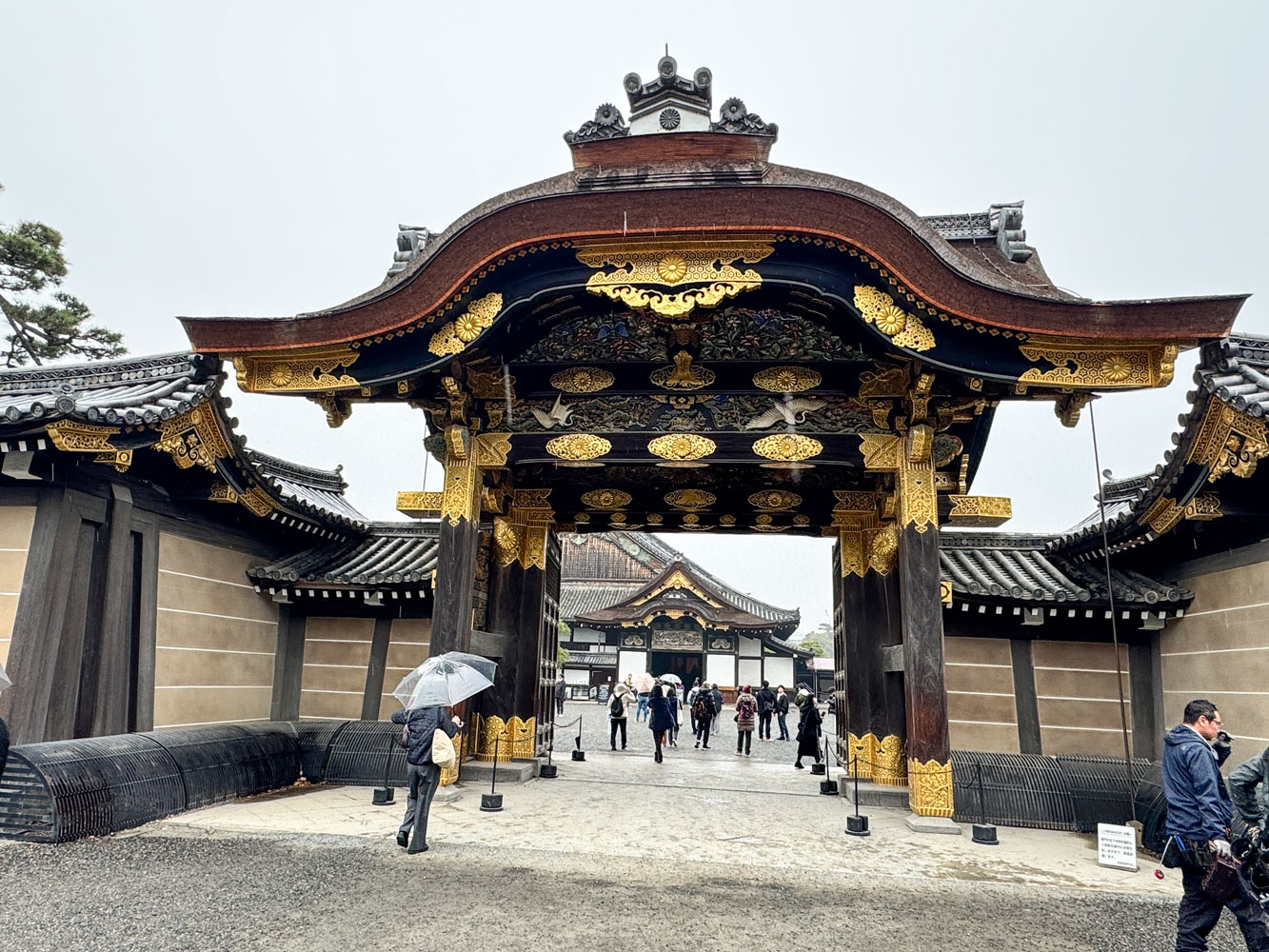
A closer view of the decorations on the gate.
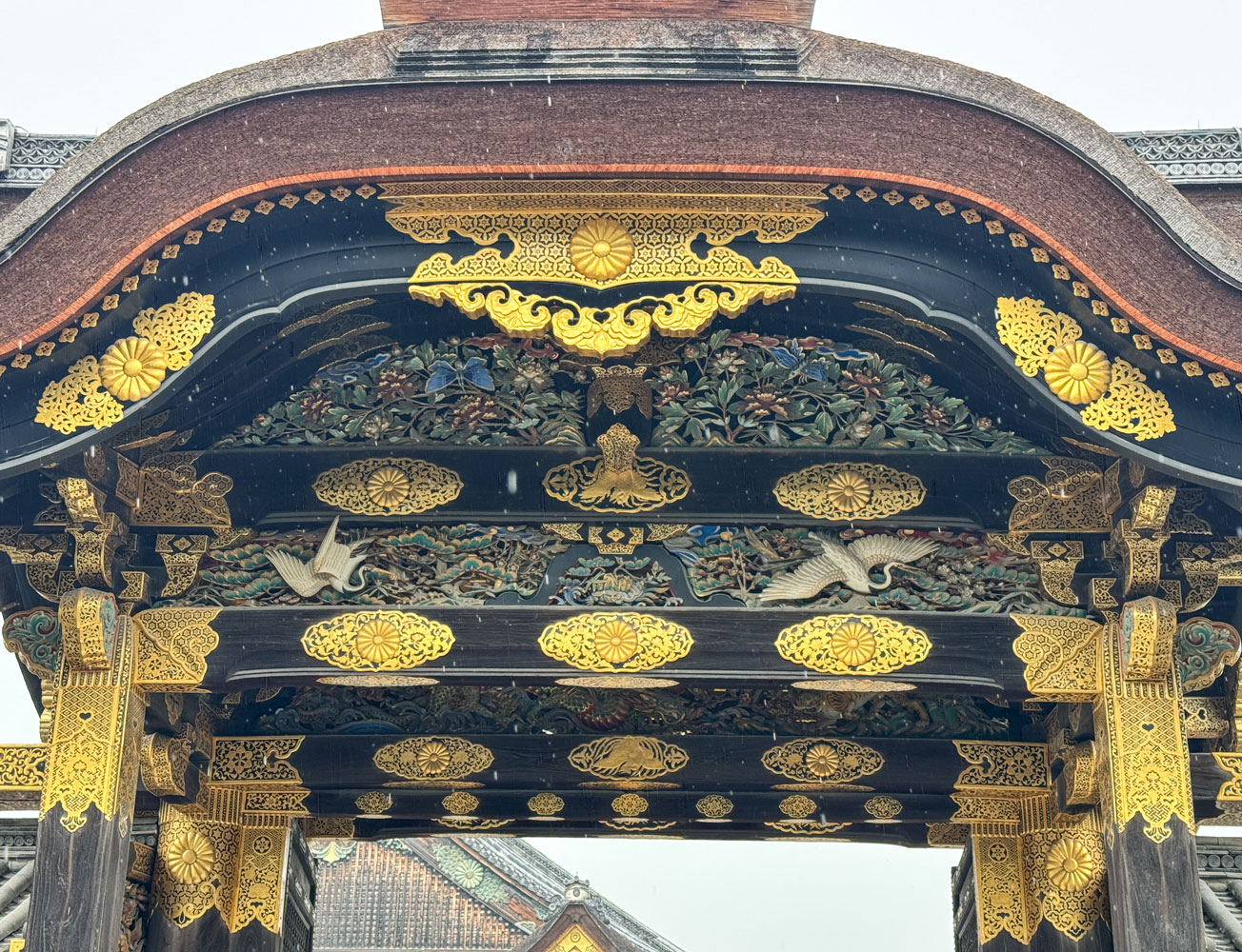
And part of the detail. The white streaks you see in this picture are raindrops.
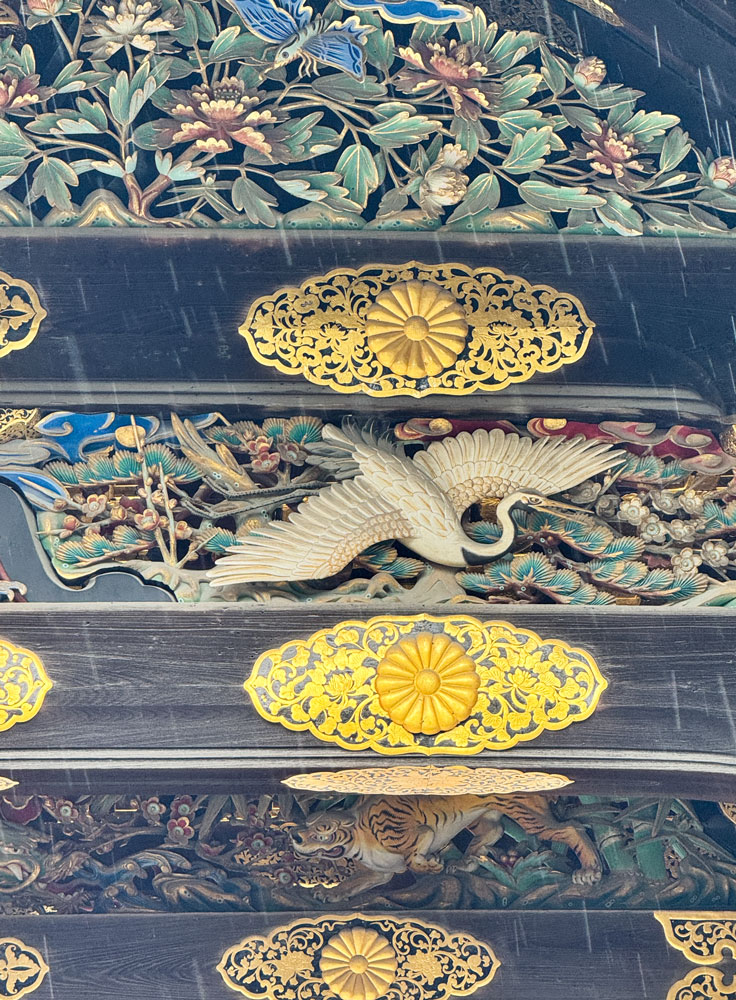
We began our tour by walking through the gardens.
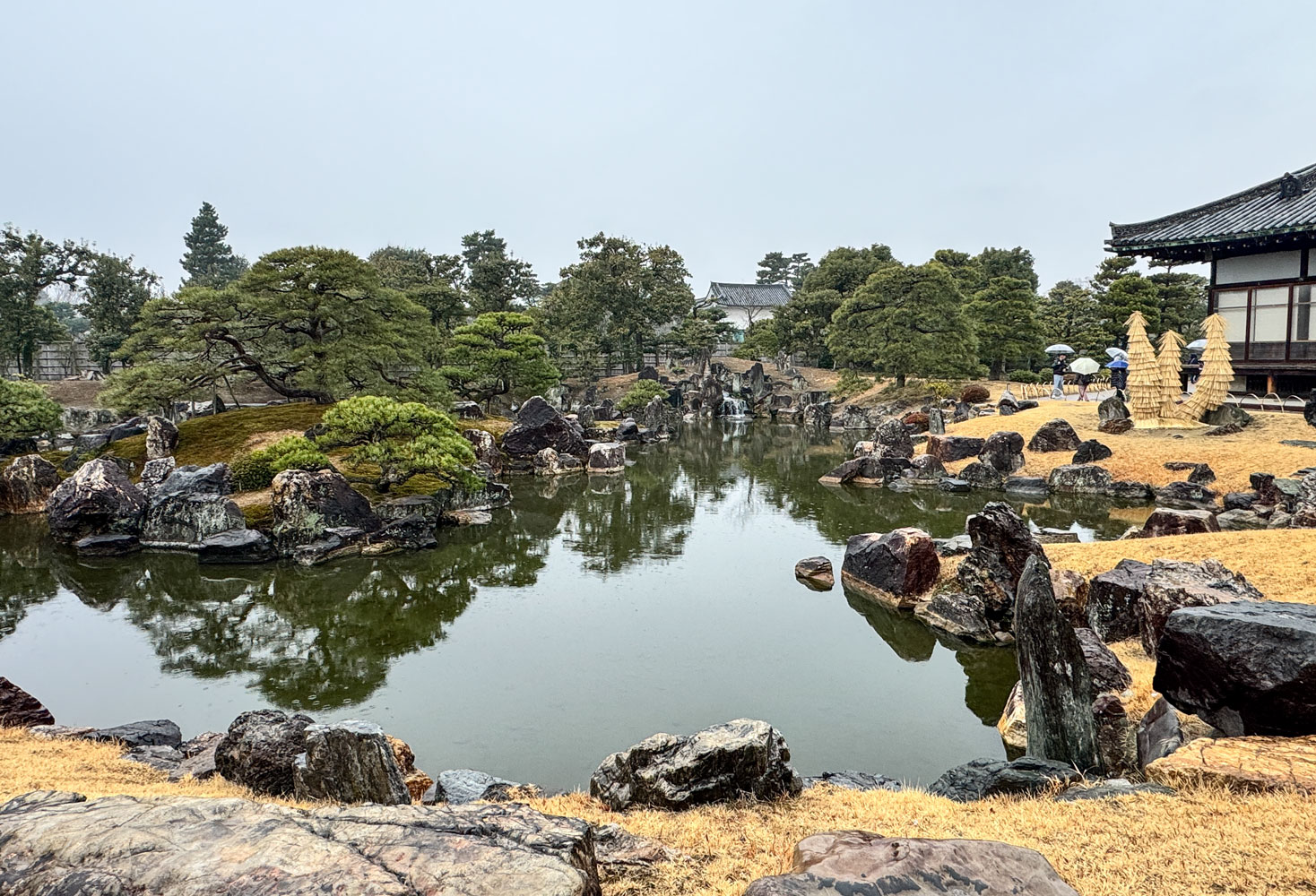
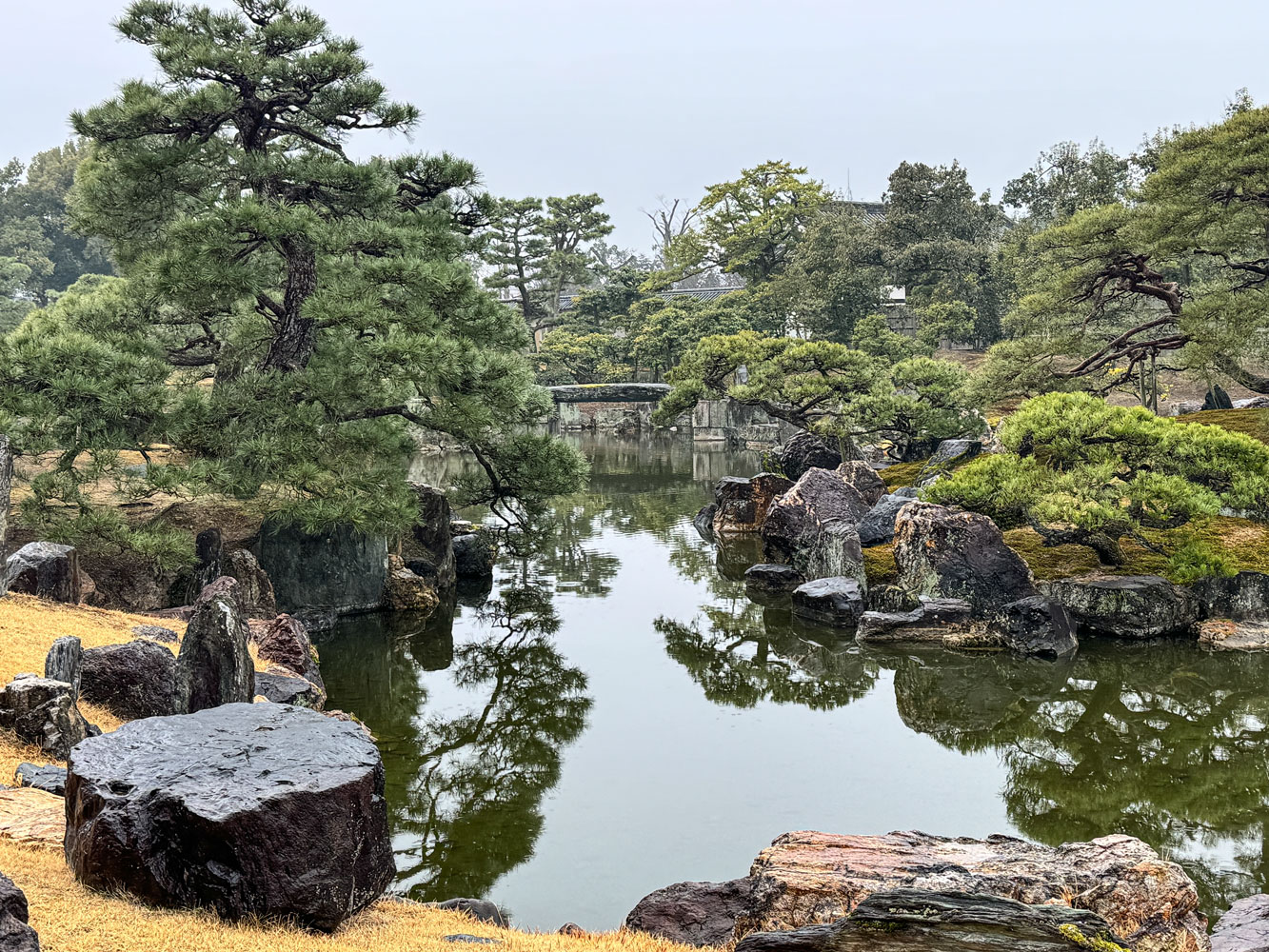
A stone bridge.
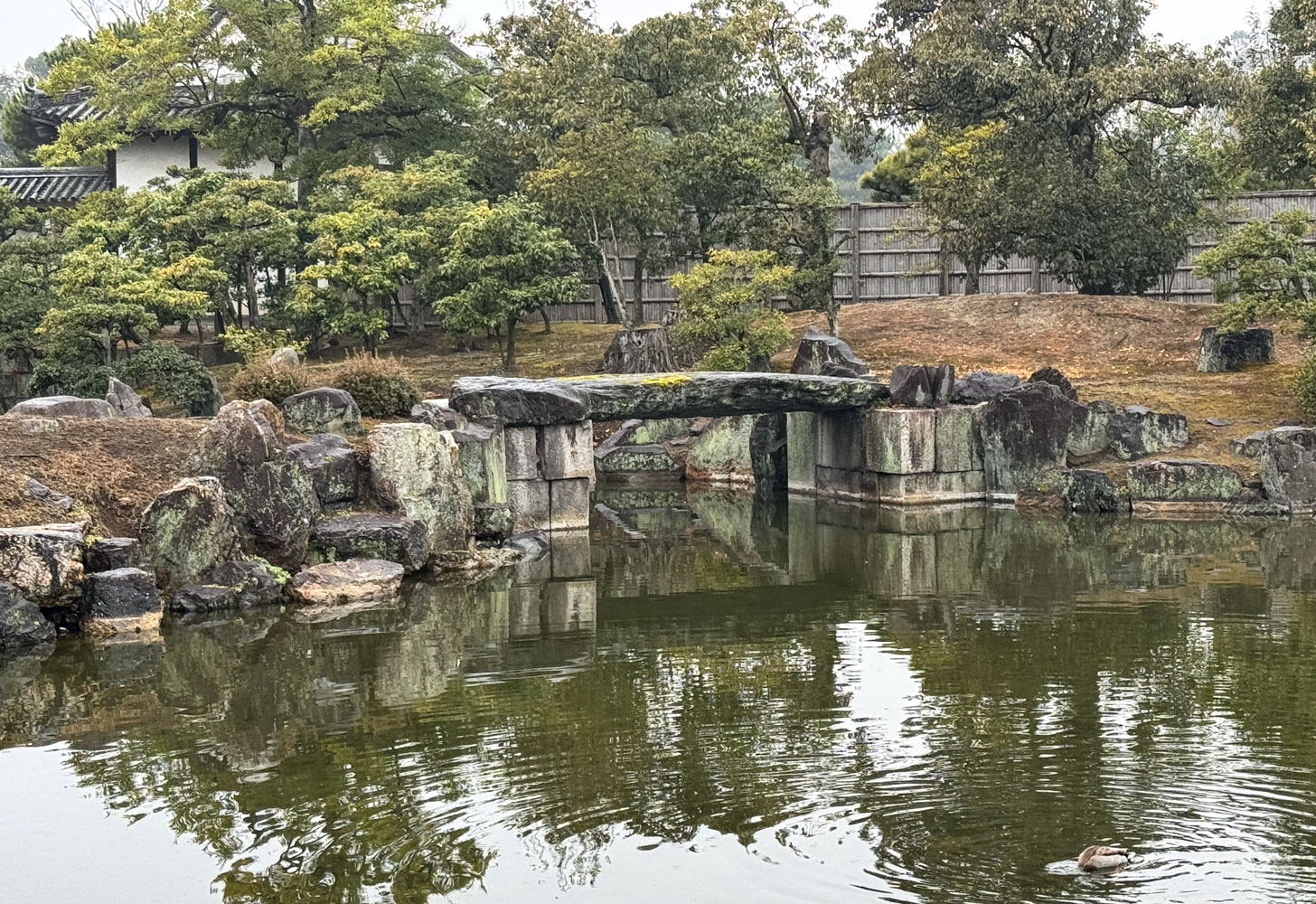
Then we went into the main part of the castle. There was an extra charge of 500¥ (about $3.35). Pictures were not allowed inside.

Here's an interior picture from the web.
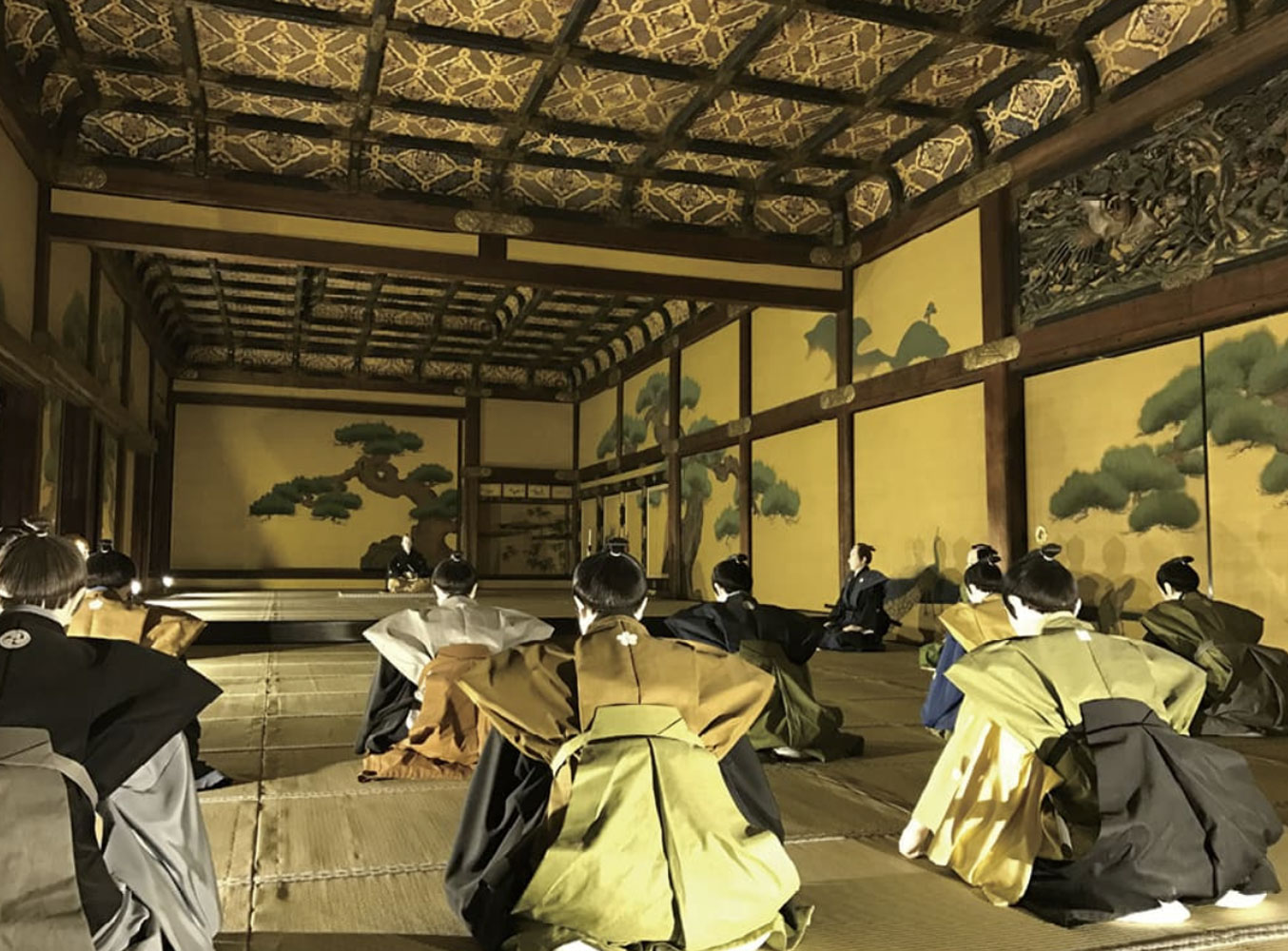
Another interior picture.
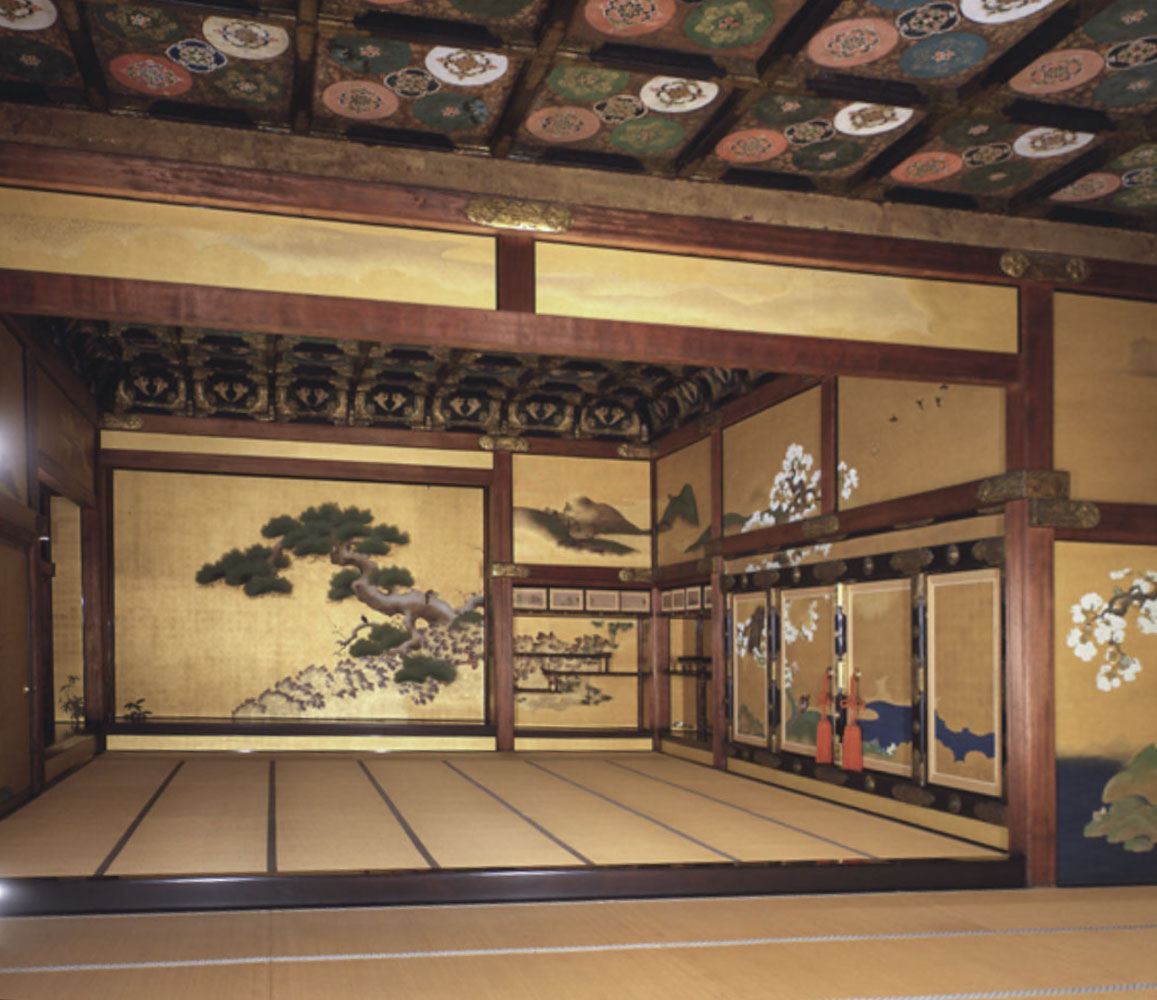
You can find more pictures of the interior here, and at other places on the web. Incidentally, there were no provisions to heat these castles and it got cold in this area. It had snowed here not very long ago.
We departed the castle a bit after 11am and headed to a restaurant for lunch. The tables were set with bento boxes.
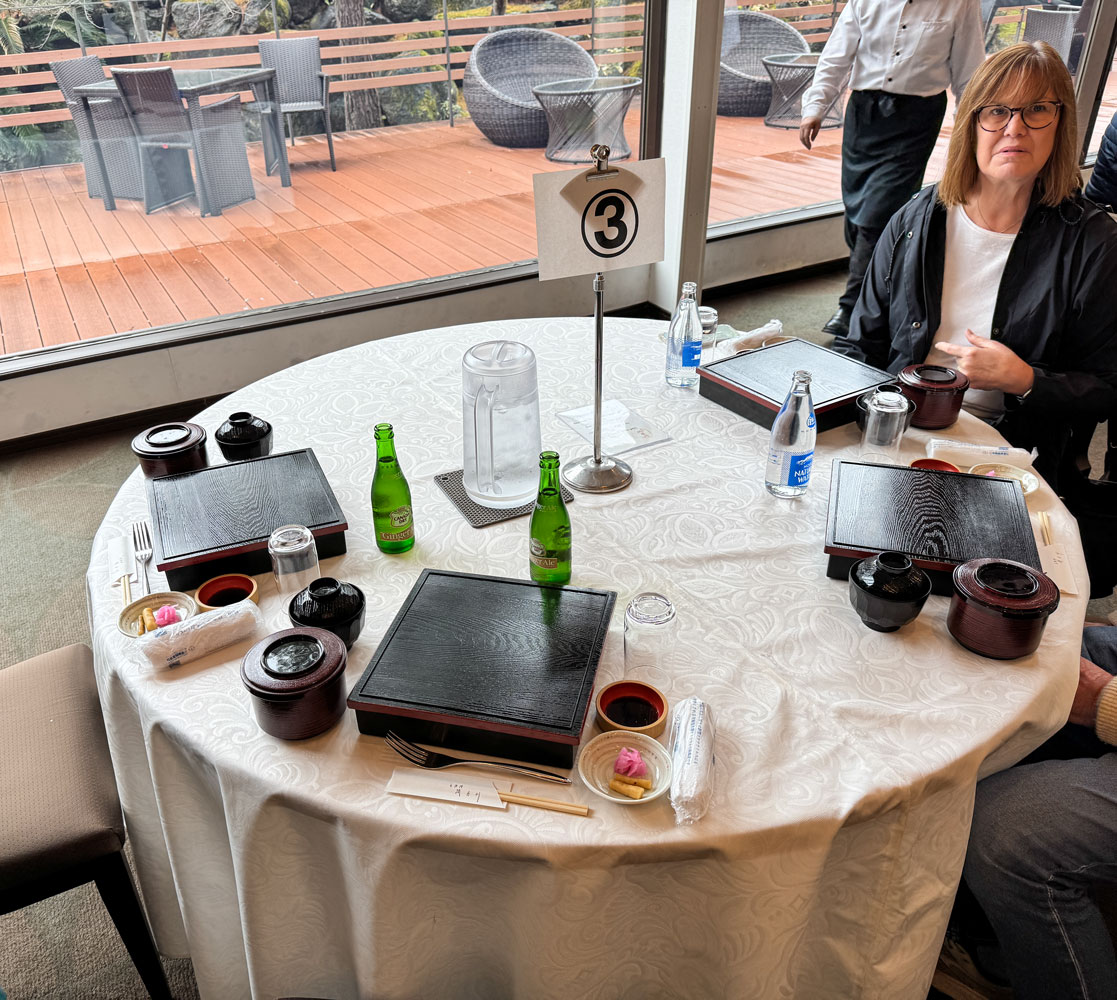
Here's what one looks like open. These are nice Bento boxes. Bento boxes are generally used for take-out meals and are not fine dining. They also would not have ceramic dishes inside the box. But I suppose they wanted to give us a flavor of Japanese dining.
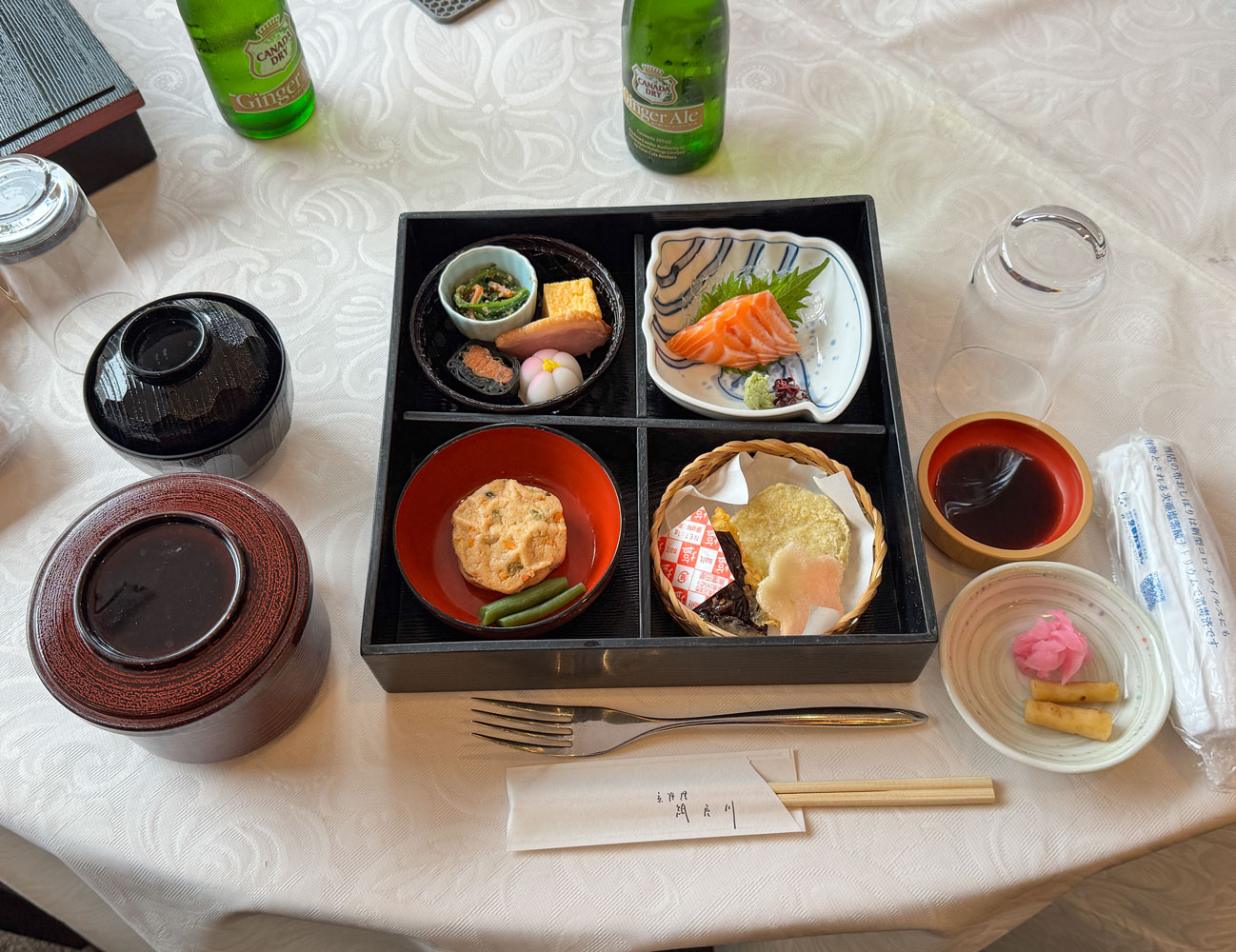
After lunch we went to the Kinkaku-ji Buddhist Temple (officially the Rokuon-ji Temple, "Deer Garden Temple").
There were two young women in lovely Kimonos entering at the same time as our group.
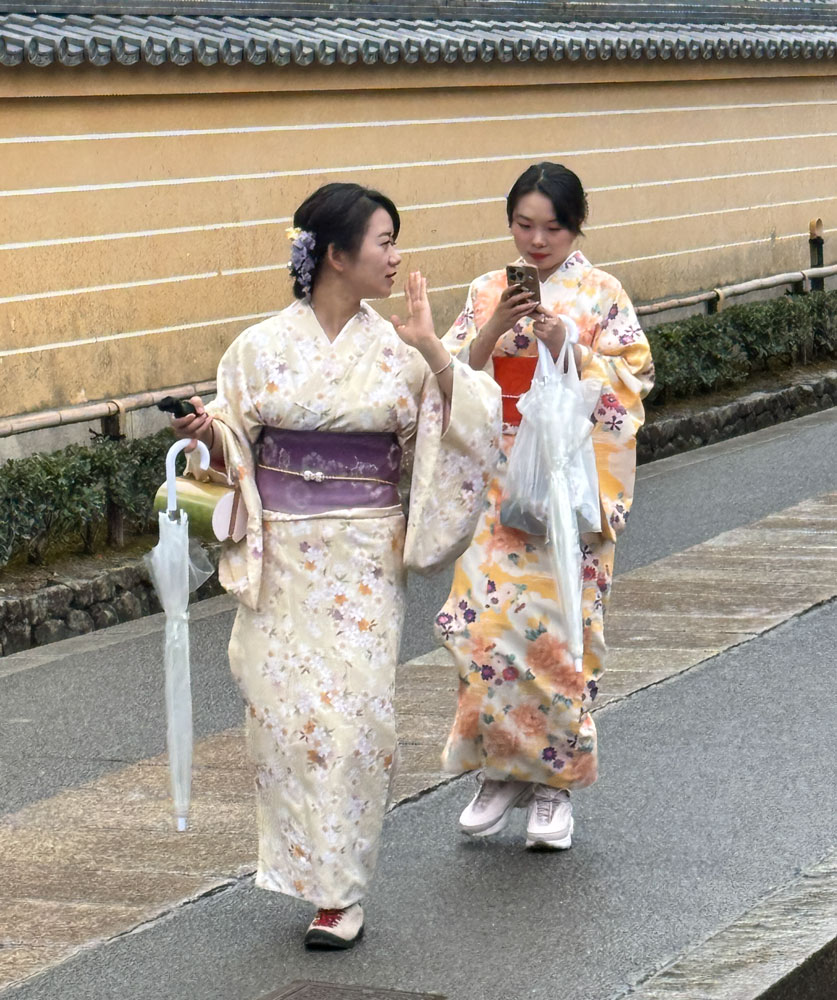
As we were walking in, there was a bell structure on our left. If you look closely, you can see a man with a face mask standing next to the bell. Shortly after I took this picture, he rang the bell with the wooden beam that is just over his head.
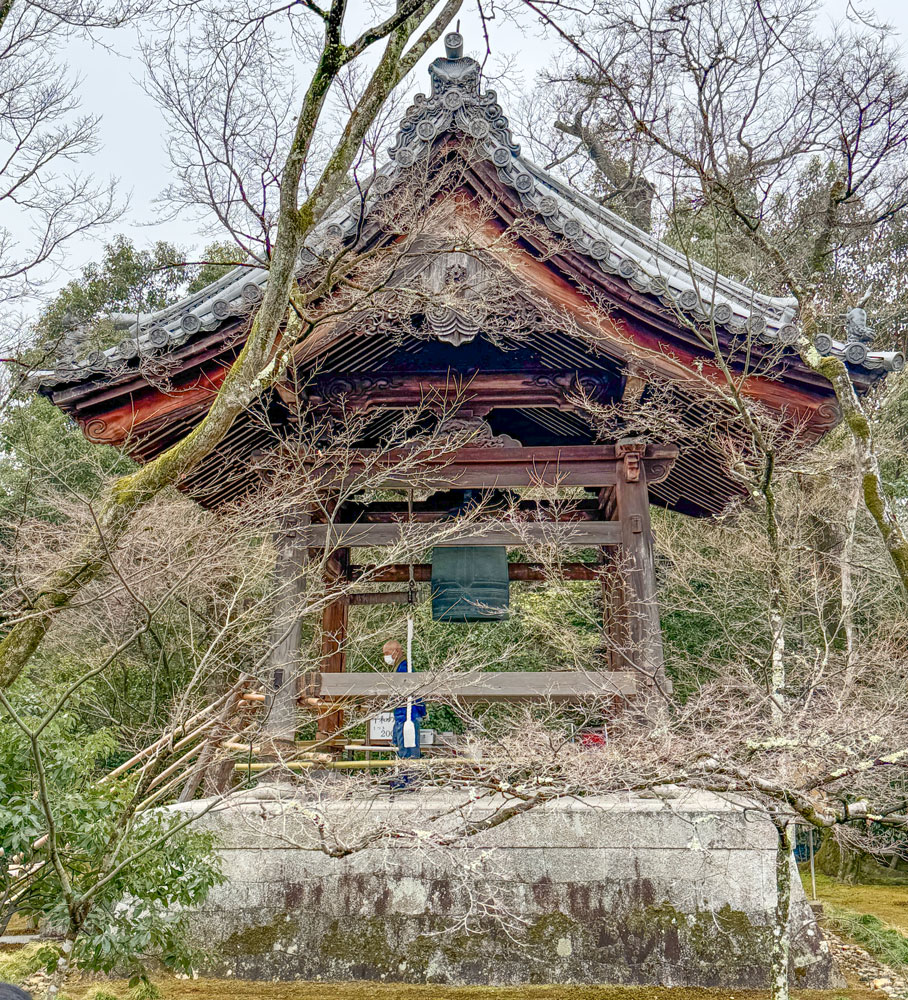
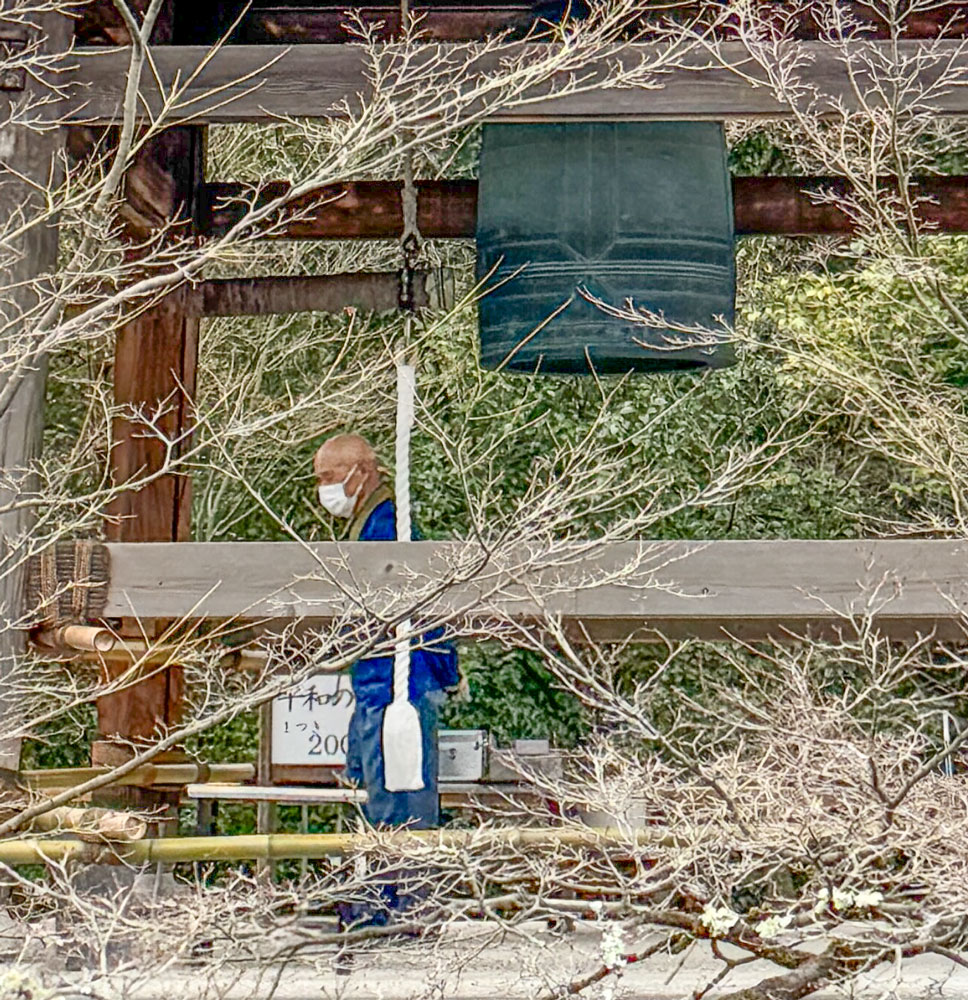
After we entered the grounds, we were able to see the Golden Pavilion located on the small lake.

A closer look at the Golden Pavilion.
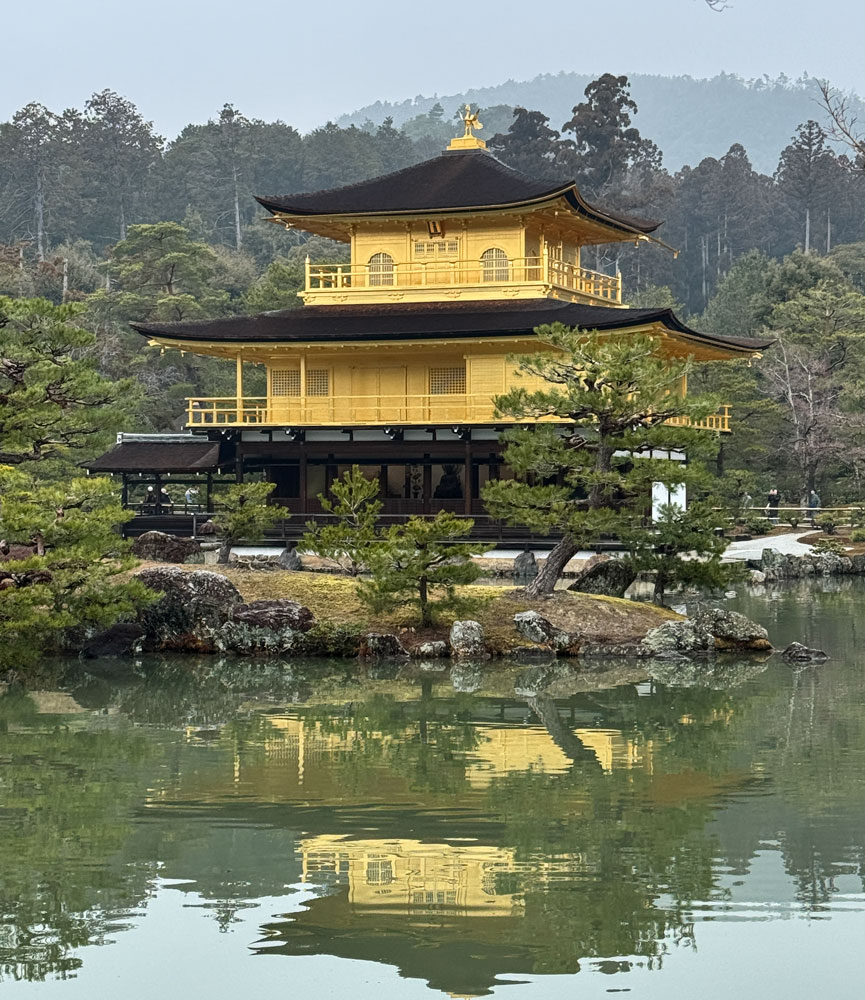
There were two other young women wearing kimonos. Look at the obi bow on back of the woman with the red kimono. A woman wearing a kimono like this cannot lean back when sitting in a chair - it would crush the bow of the obi.
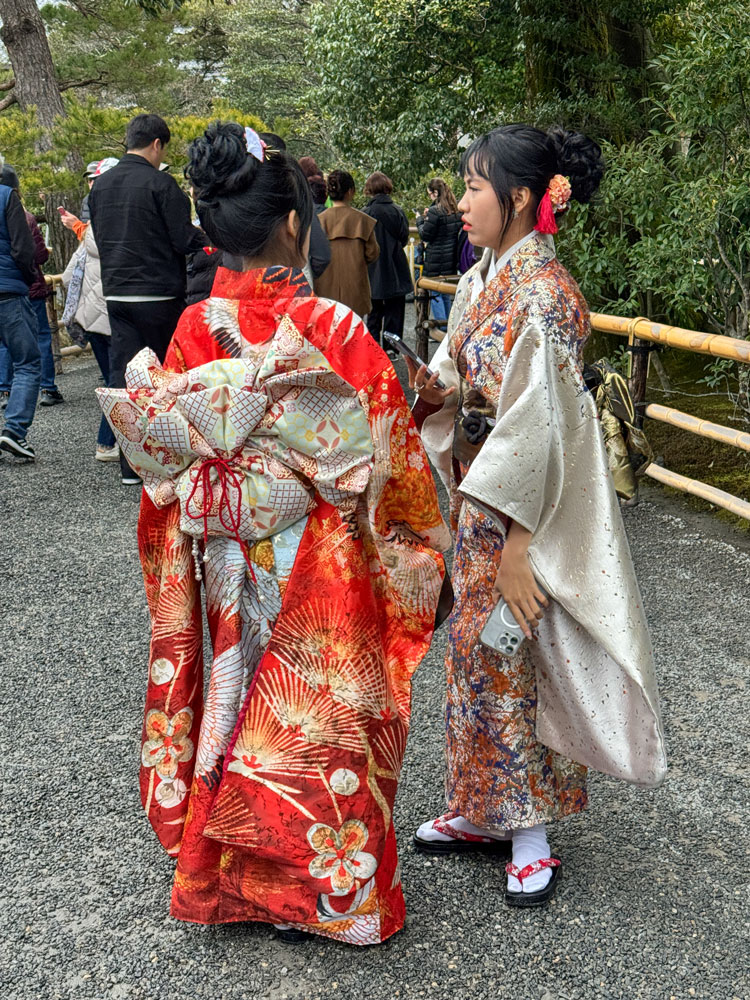
A wide view of the Golden Pavilion and the lake.
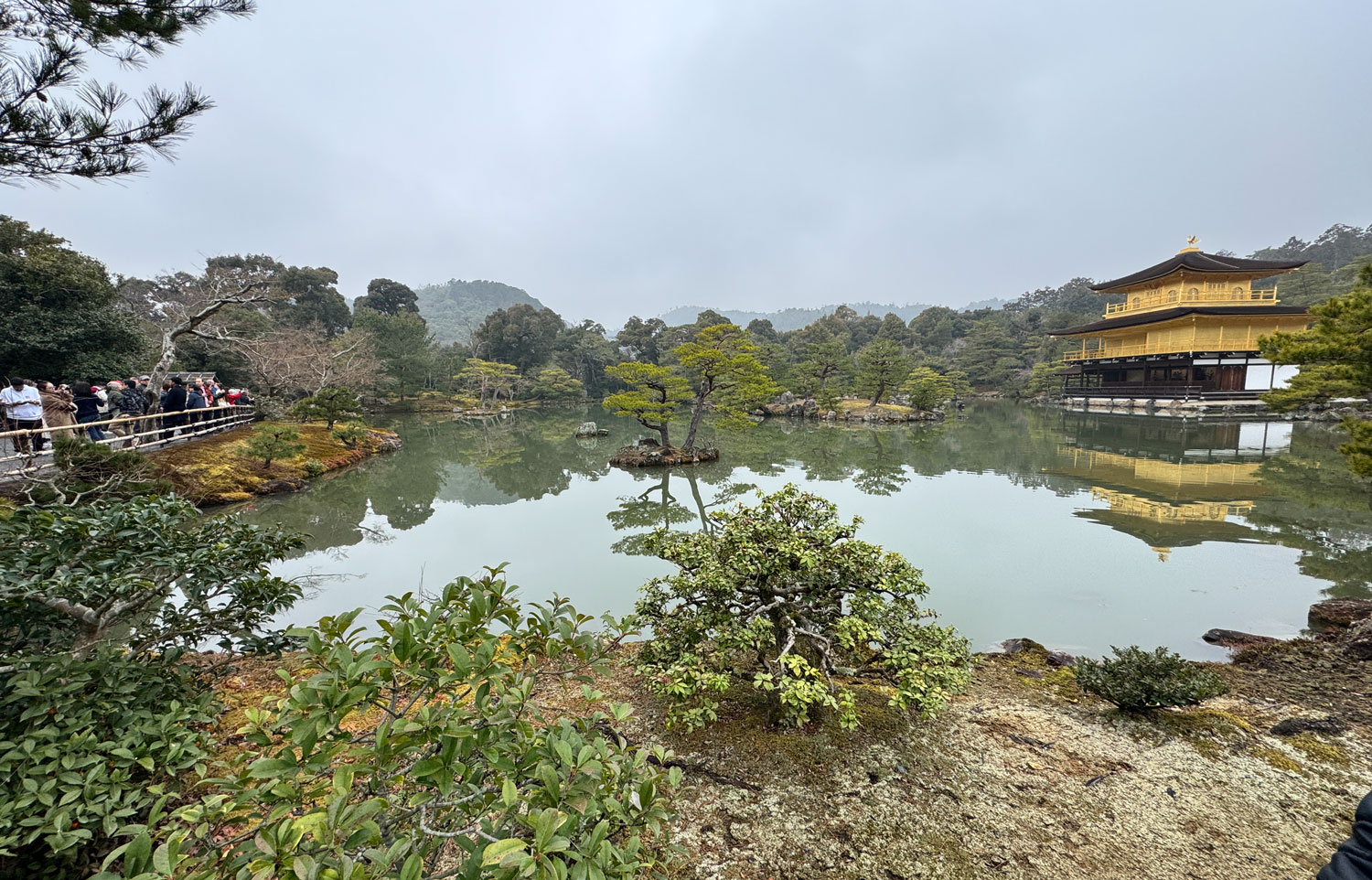
Along the walk was this set of carved stones. In front of the main stone was a hollowed-out stone, and people would throw a coin trying to land in the hollow. Apparently, not many of them are good coin throwers:-)
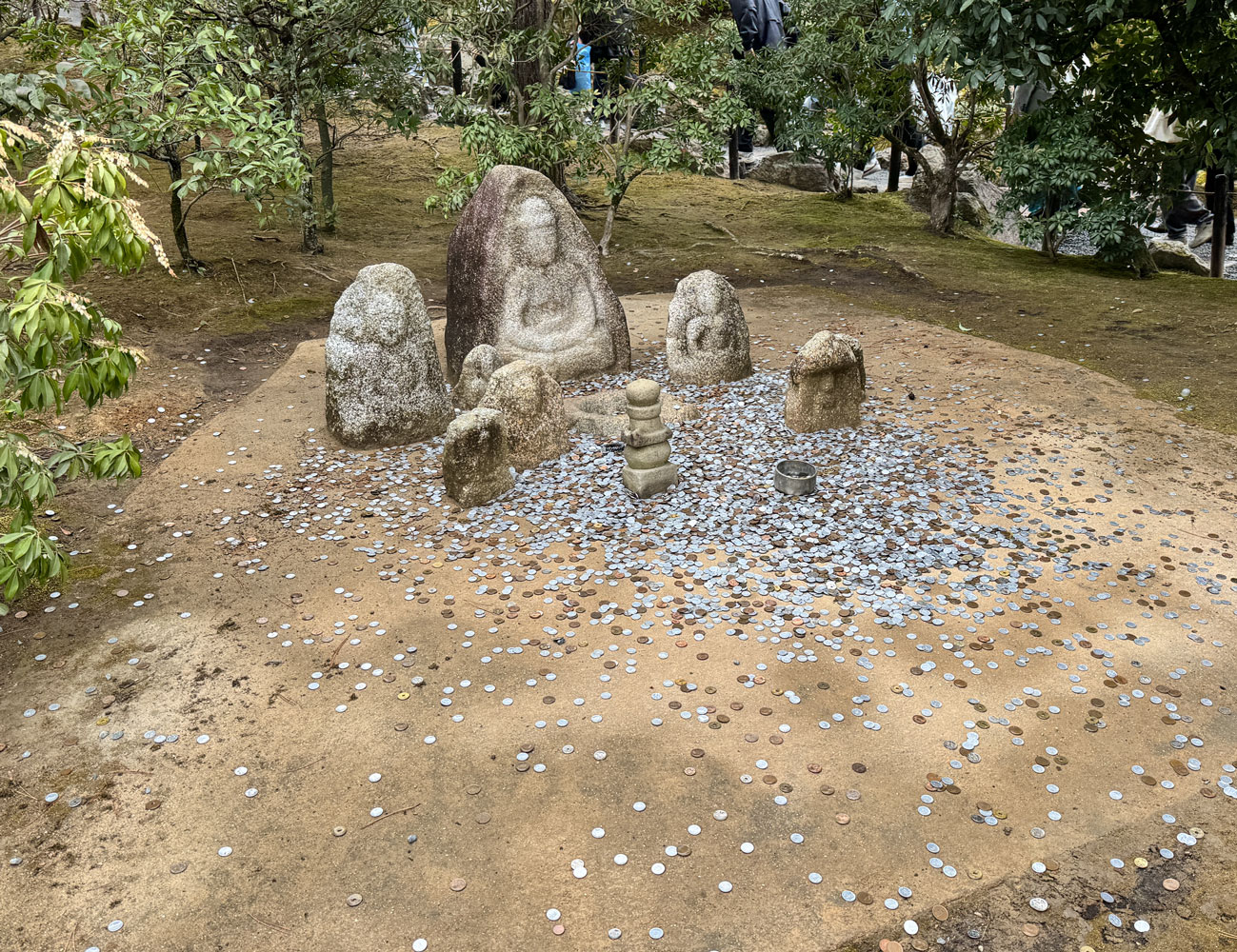
Here's another one. I tried to take the shot just as one guy was throwing a coin - you can see his hand on the right, but I can't make out his coin against the background.

We came upon a small temple where people were burning incense.
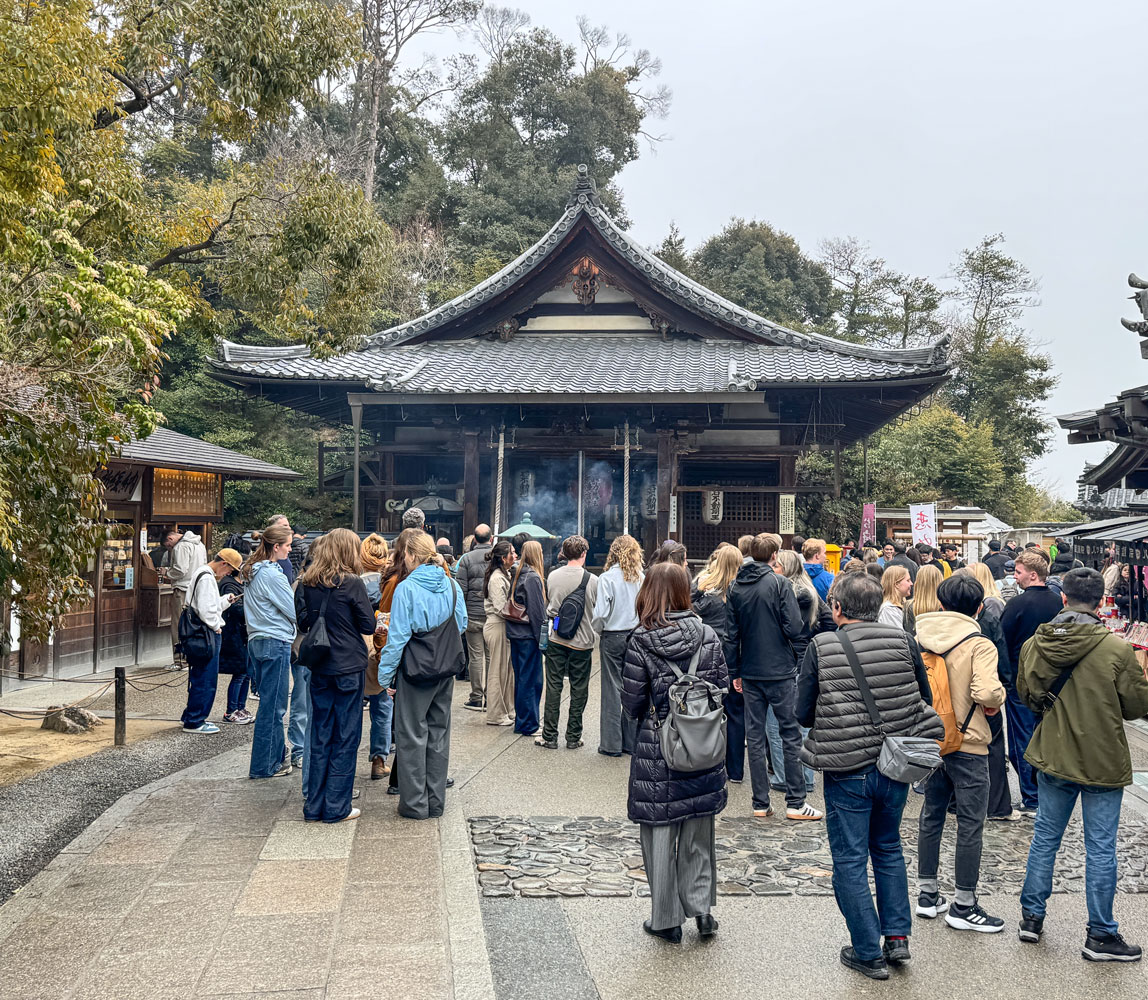
A closer look at the incense location.

After that, we left the temple and headed back to the ship. Traffic wasn't bad and we got back to the ship about 3:30pm, in time to play Trivia at 4:30.
We had dinner and then to bed. The ship will stay overnight in Osaka. The weather prediction for tomorrow is for rain and colder temperatures.
+++++++++++++++++++++++++++++++++++++++++++++++++++++
3/3/2025 (Monday) We woke up to rain this morning and a temperature of about 45 degrees. We have a tour of Osaka today and we're going even if it's raining.
After breakfast we went down to the theater to get our bus passes. By 8:35am we were at the bus.
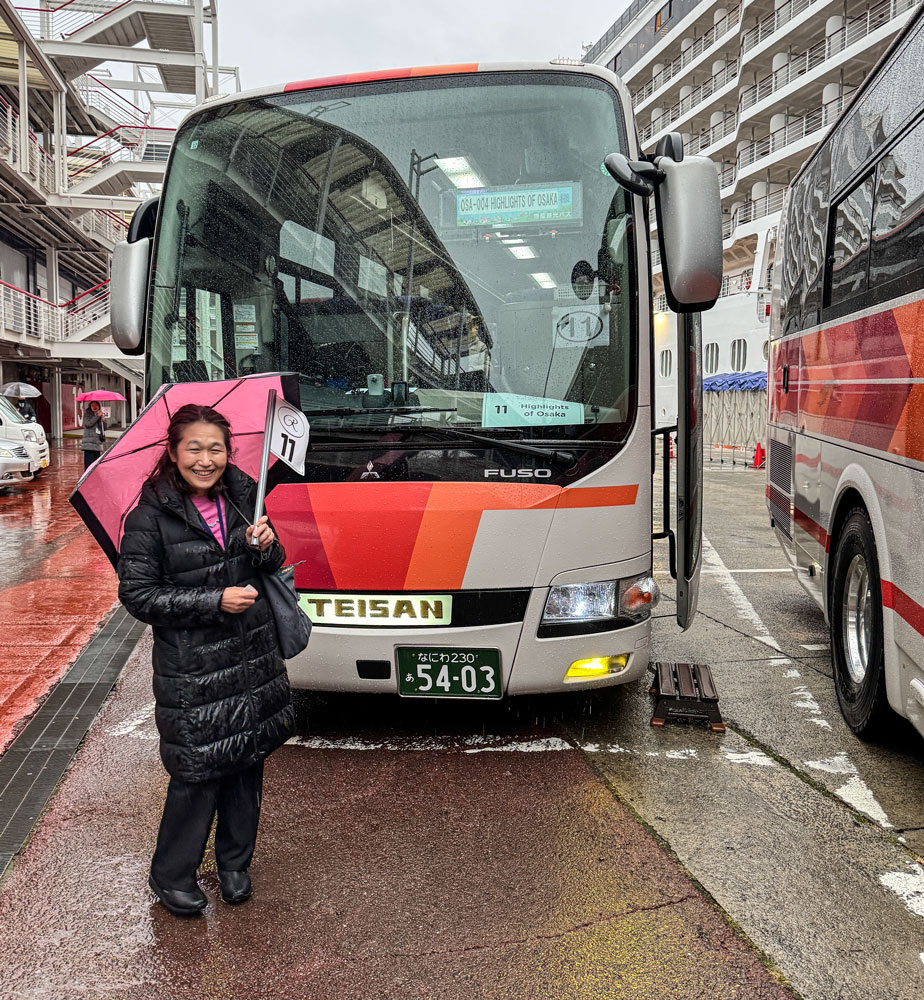
Our first stop will be at the Shitenno-ji Buddhist Temple. It was raining and the temperature was in the low 40's. It was not a comfortable day.
When we arrived at the temple, we walked to one of the buildings. There were two "guardian" figures on either side of the entrance.
You can see the raindrops in this next picture.
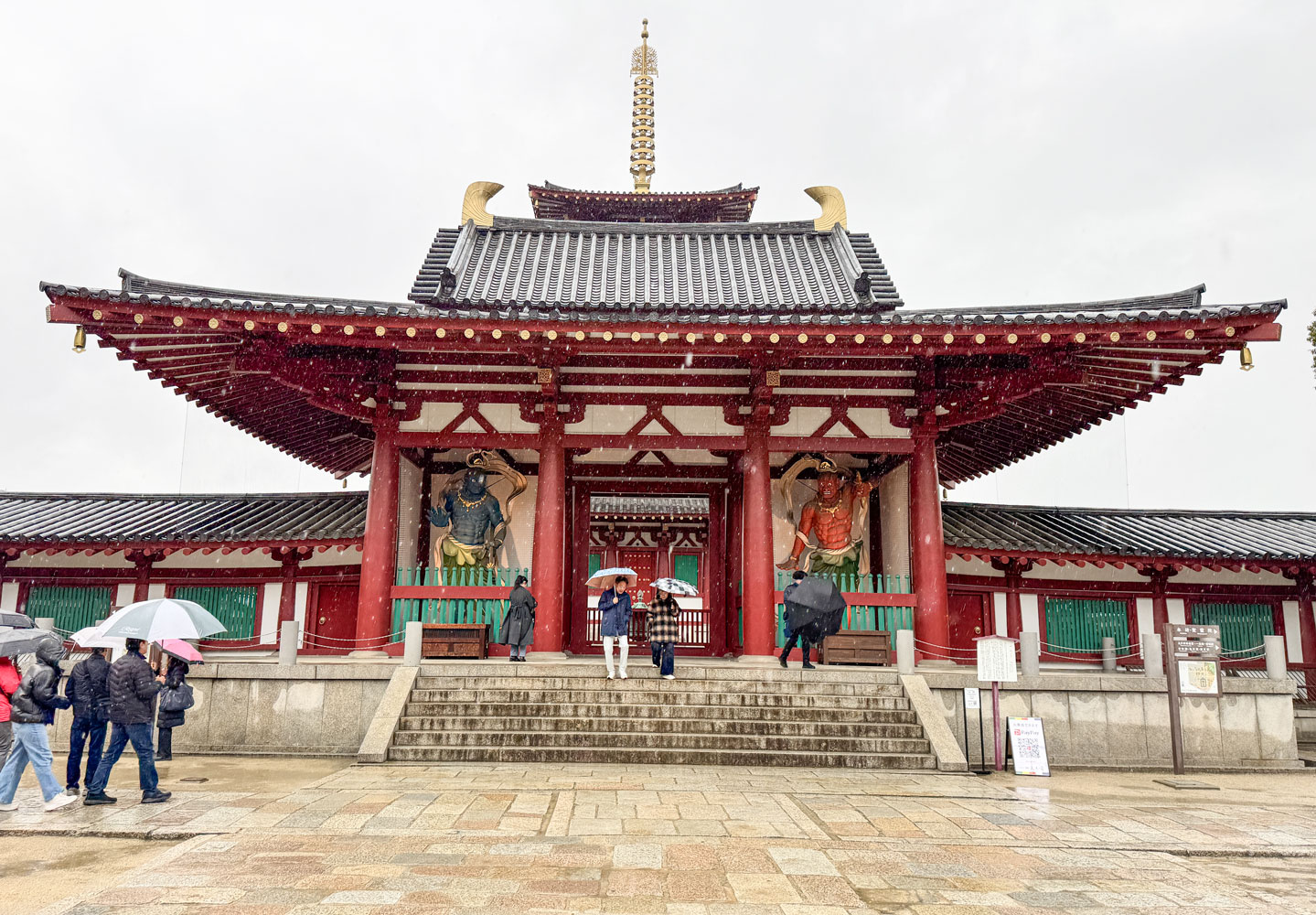
I call this one "blue-man".

Maybe this one should be called "red-man".
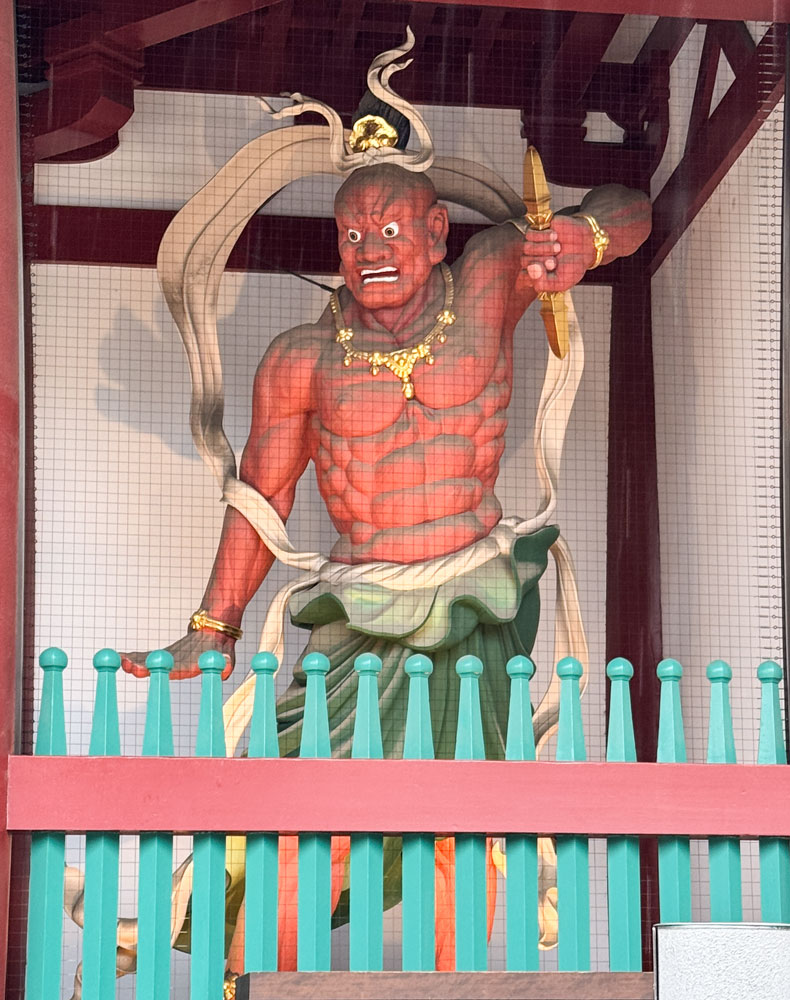
We walked to the main entrance and entered the main part of the temple. The temple is laid our in a rectangle. In the center is a pagoda and next to it is a temple of some type.
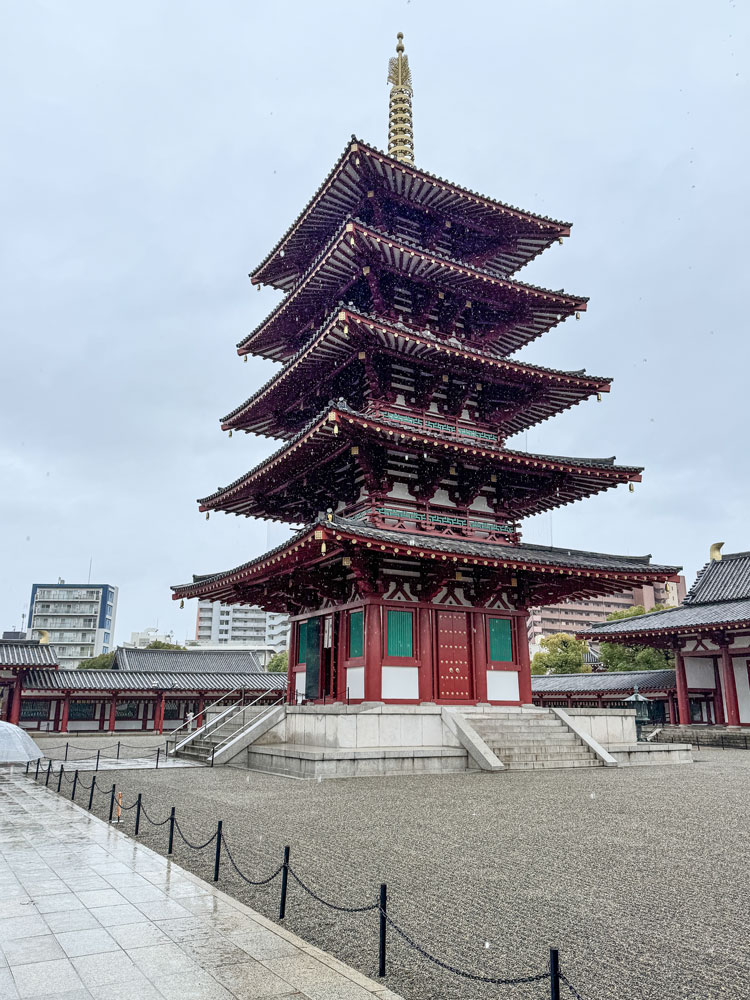
Here's the other building, a temple. You can see a bit of the pagoda on the right side of this photo.
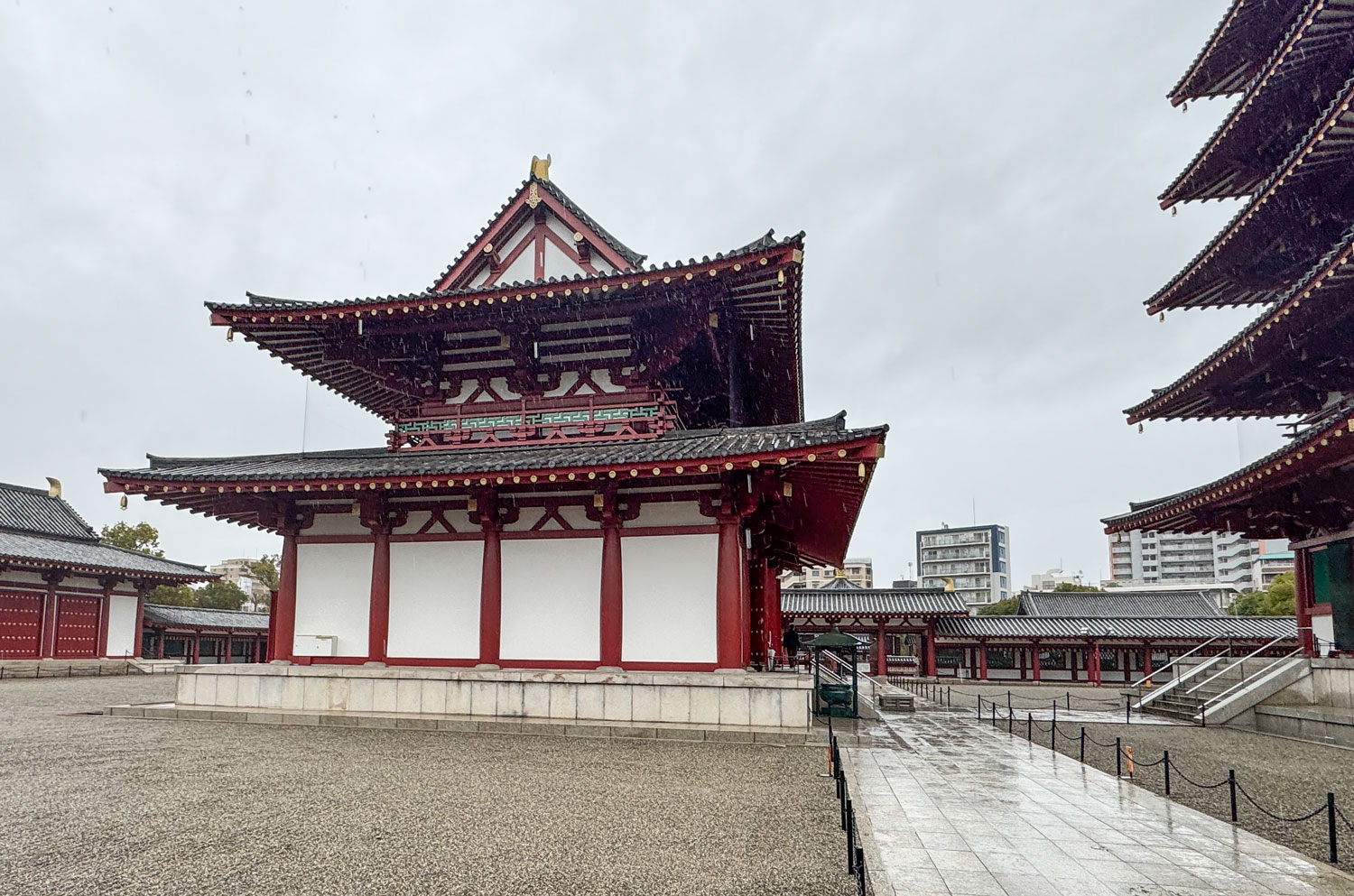
Here's the interior of the temple.
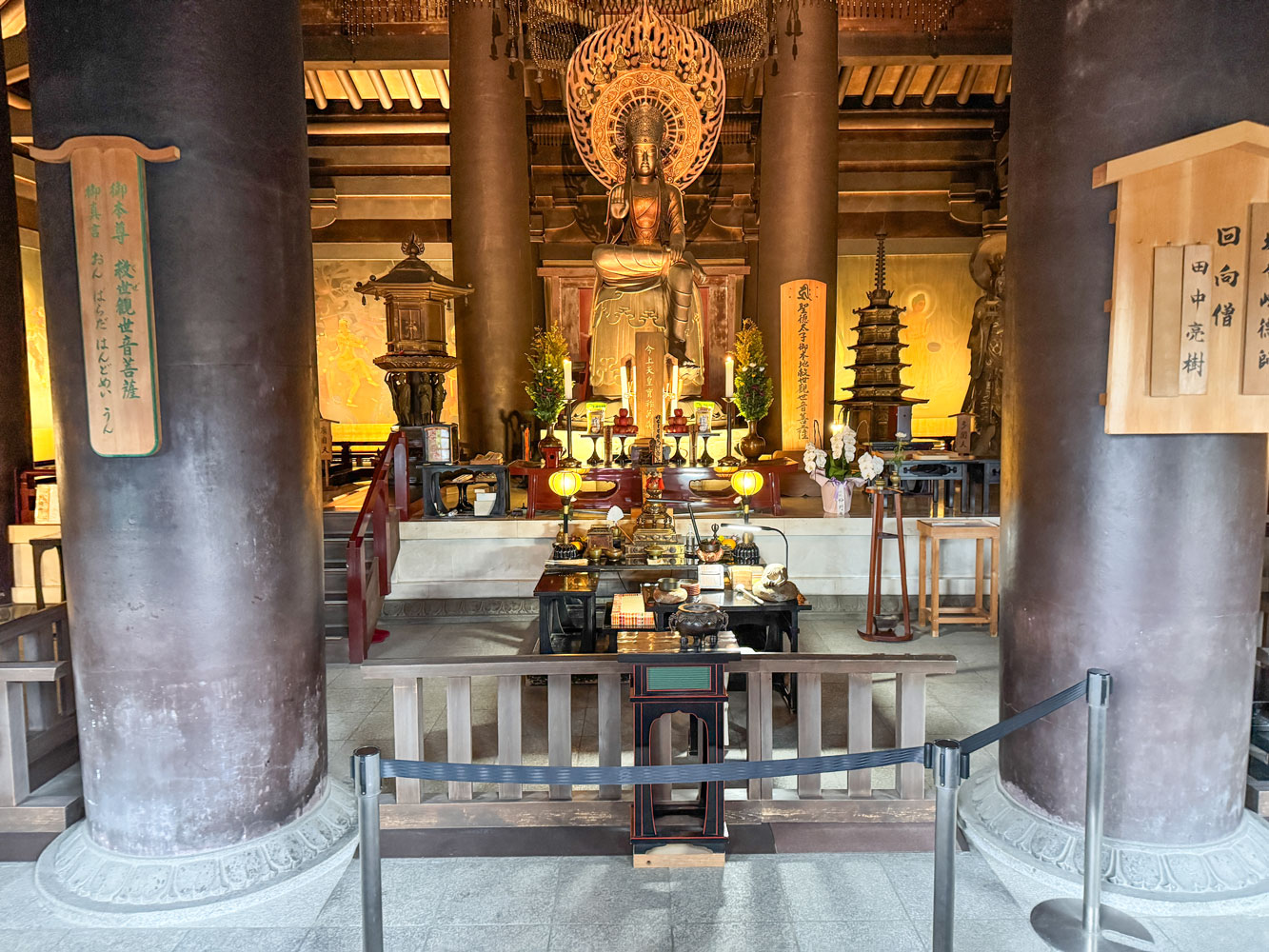
And the interior of the bottom of the pagoda. Looks like "blue-man" and a buddy.
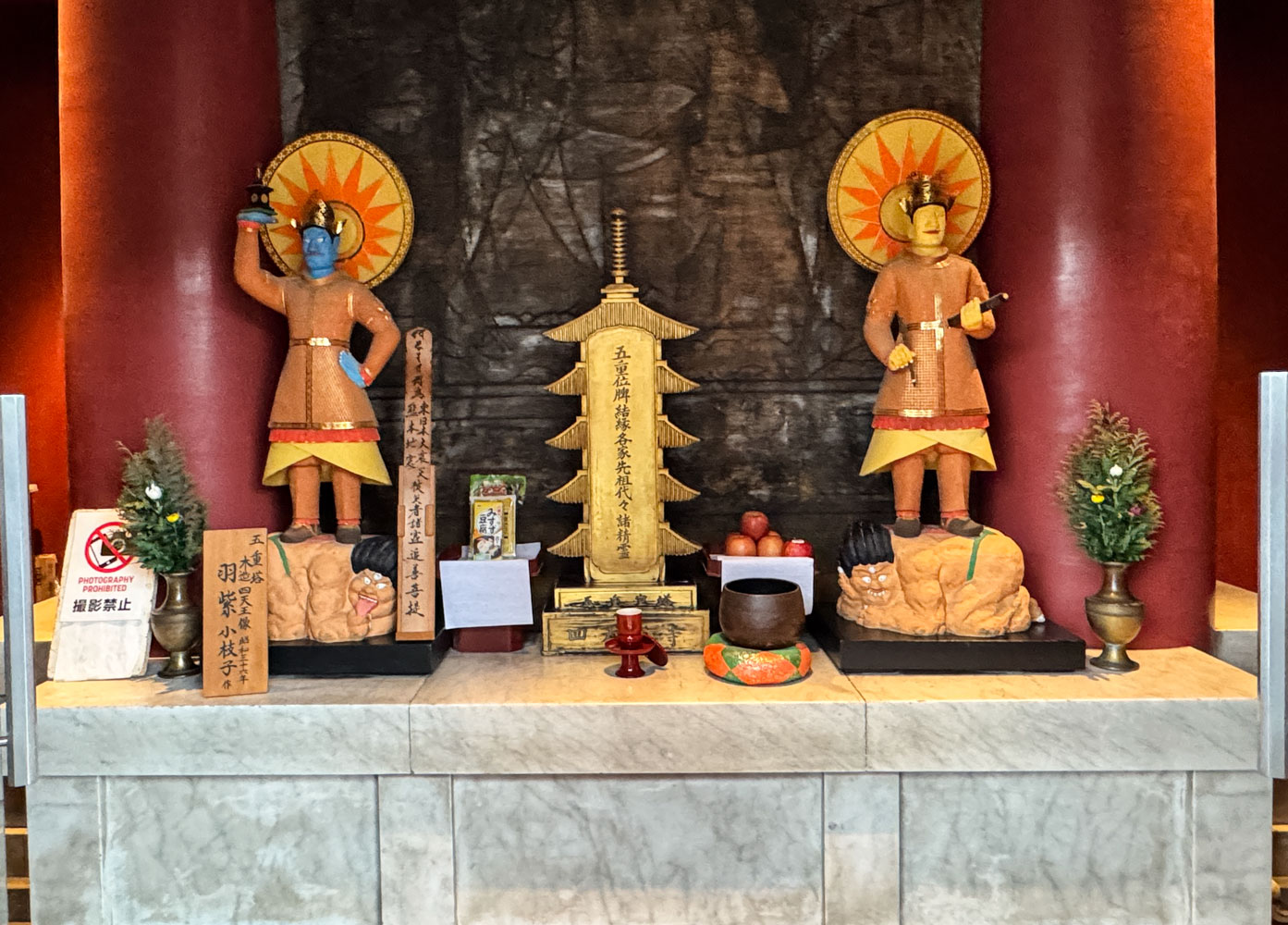
The rectangular temple area consisted of temples connected by a covered walkway. With the rain, Judy and I decided to just walk around the rectangle.
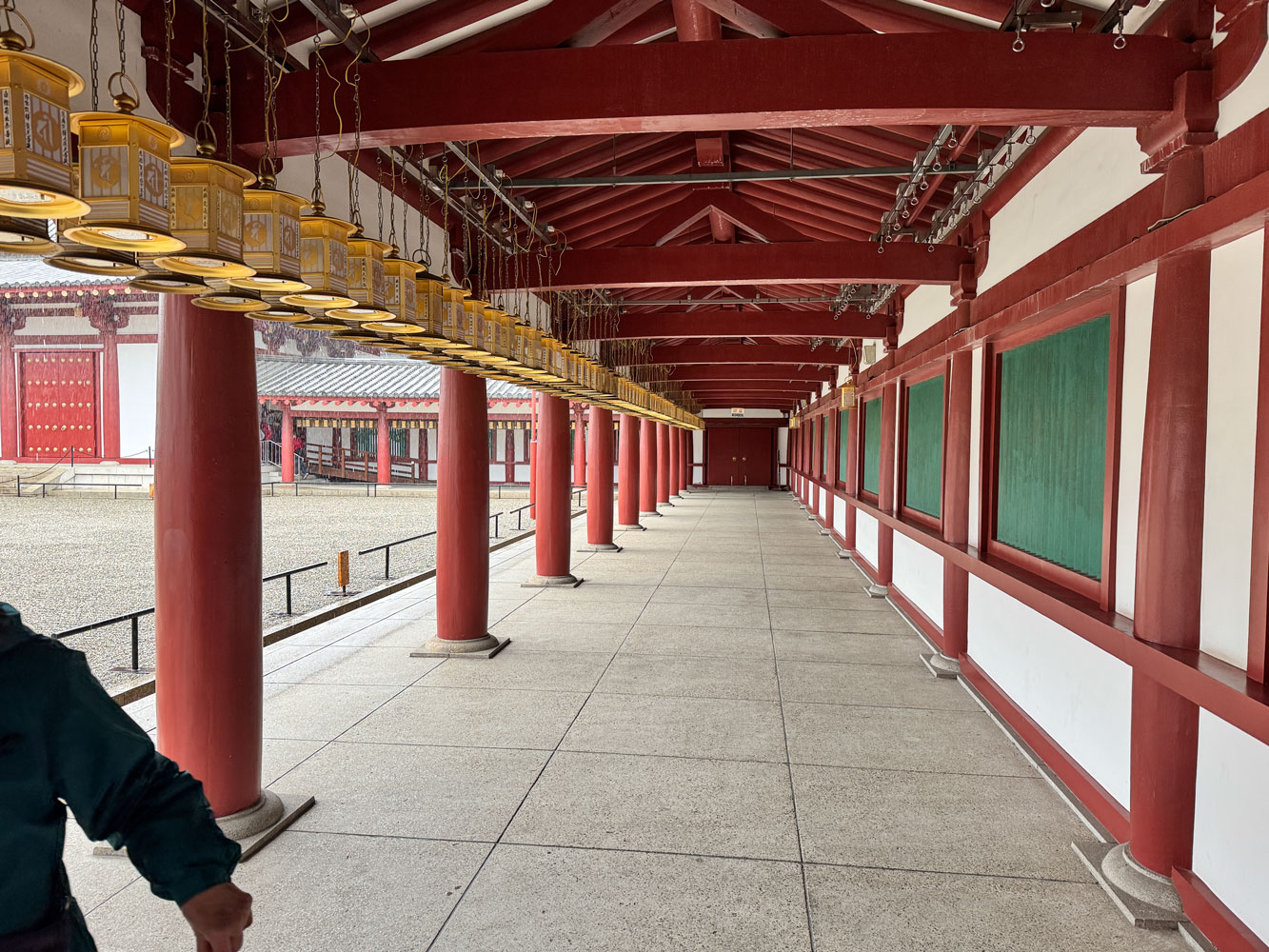
The walkway led us to a building where there were several Buddhist altars.
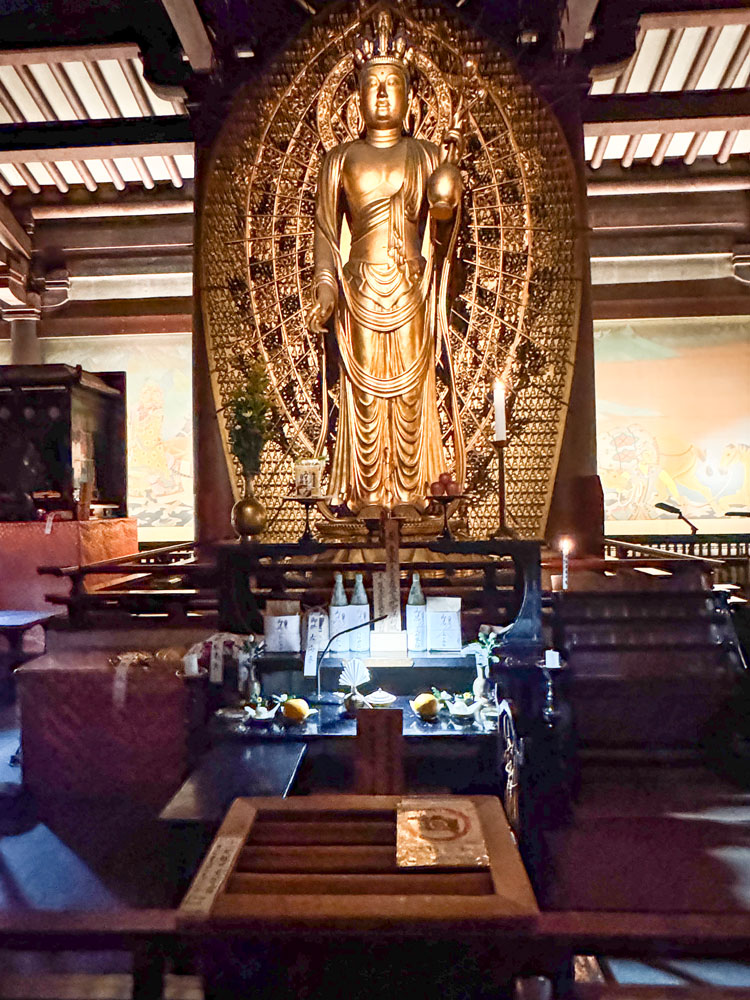
A closer view of the statue.
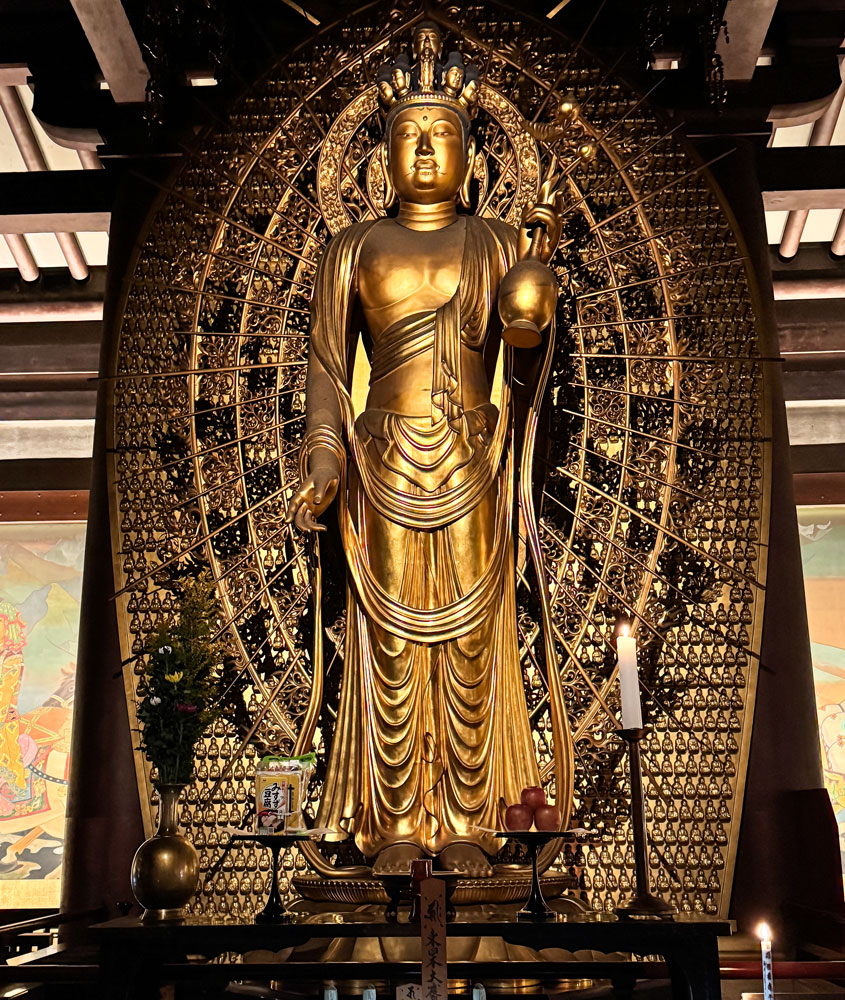
Below the statue is an "altar" where offerings of food and wine are placed.
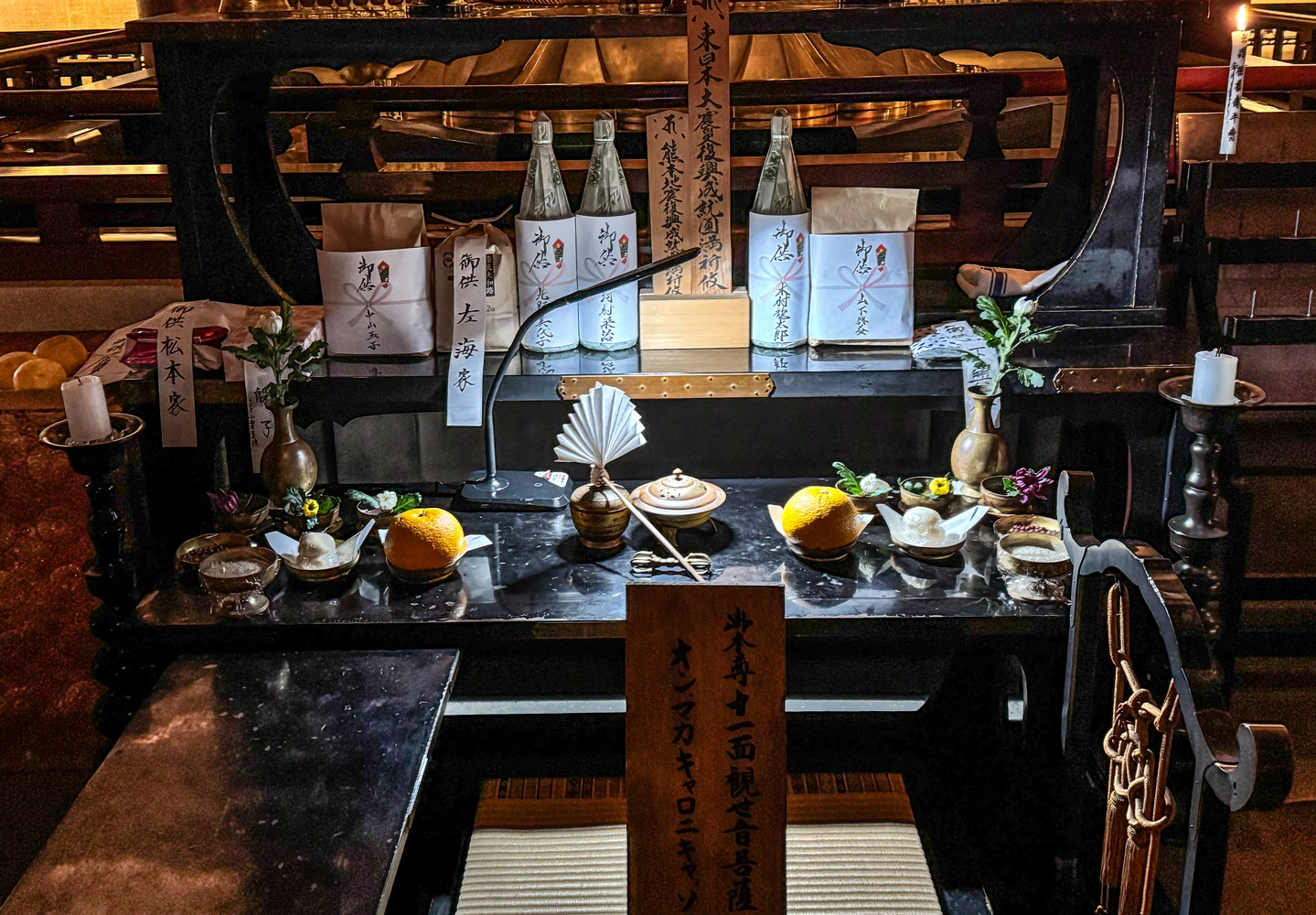
Another statue and offerings.
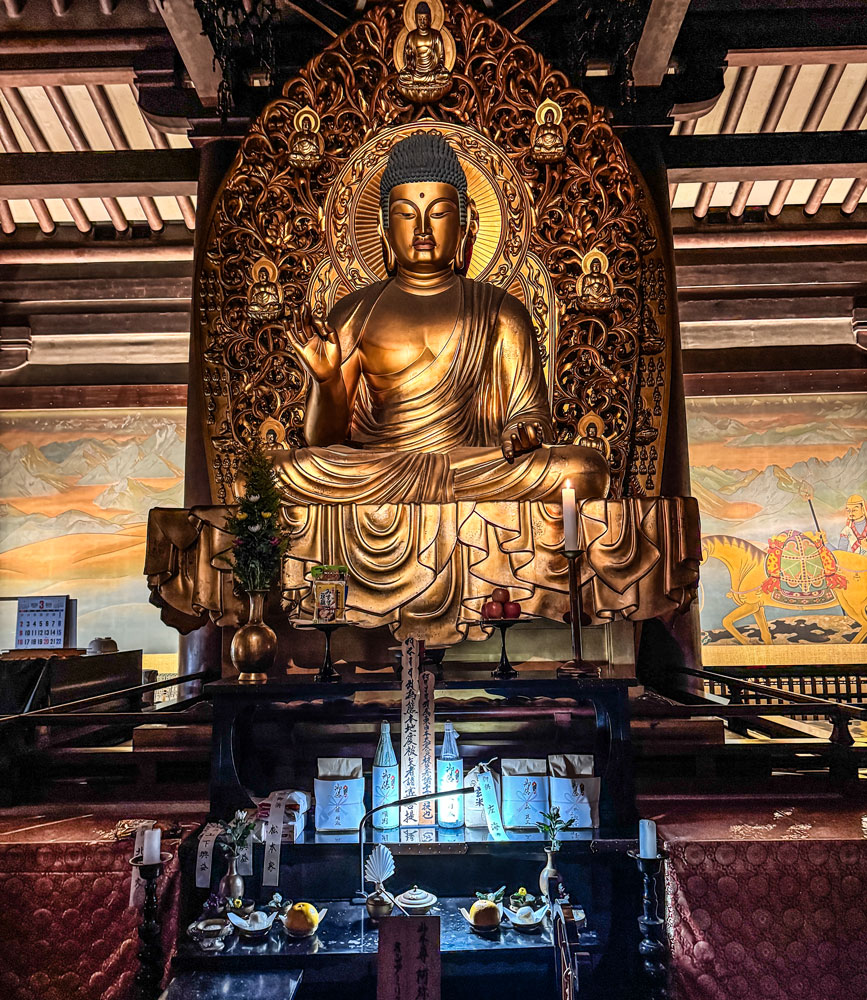
After a visit of about an hour, we left the temple and went to Osaka Castle. Construction on the site began in 1583, but many of the structures were lost to fire or warfare. The present main tower is modern, having been built in 1931 - it's a reinforced concrete structure, not wood, and was built as a museum, so it is nothing like any of the earlier castle structures, except from the outside . It sustained minor damage during the Pacific War but was repaired.
It was a long walk from the bus parking lot to the main tower. The rain and cold weather made the walk uncomfortable.
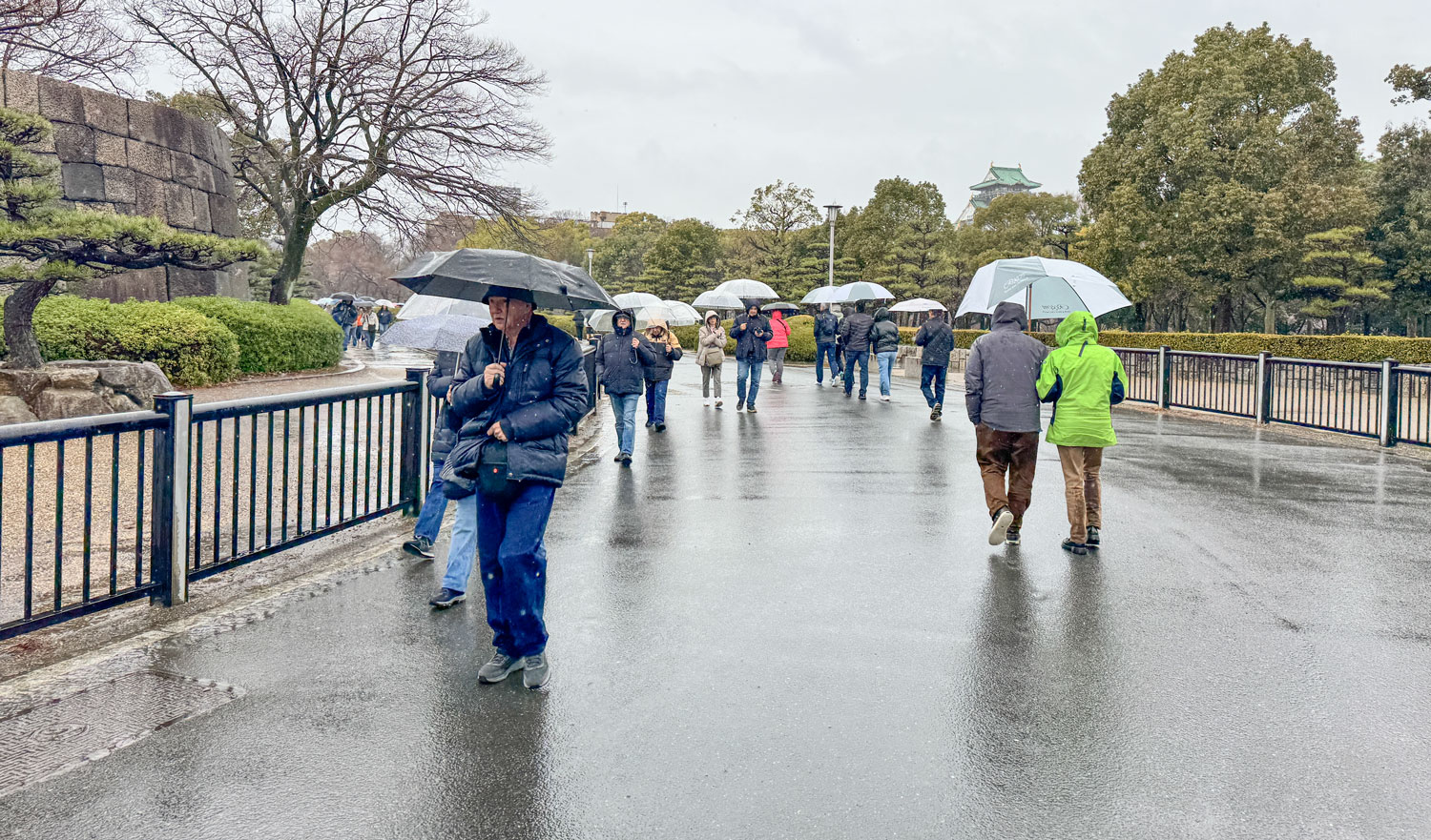
Our first view of the main pagoda-like structure. It has seven or eight floors (see discussion below) and they only use the elevators to the top for handicapped people.
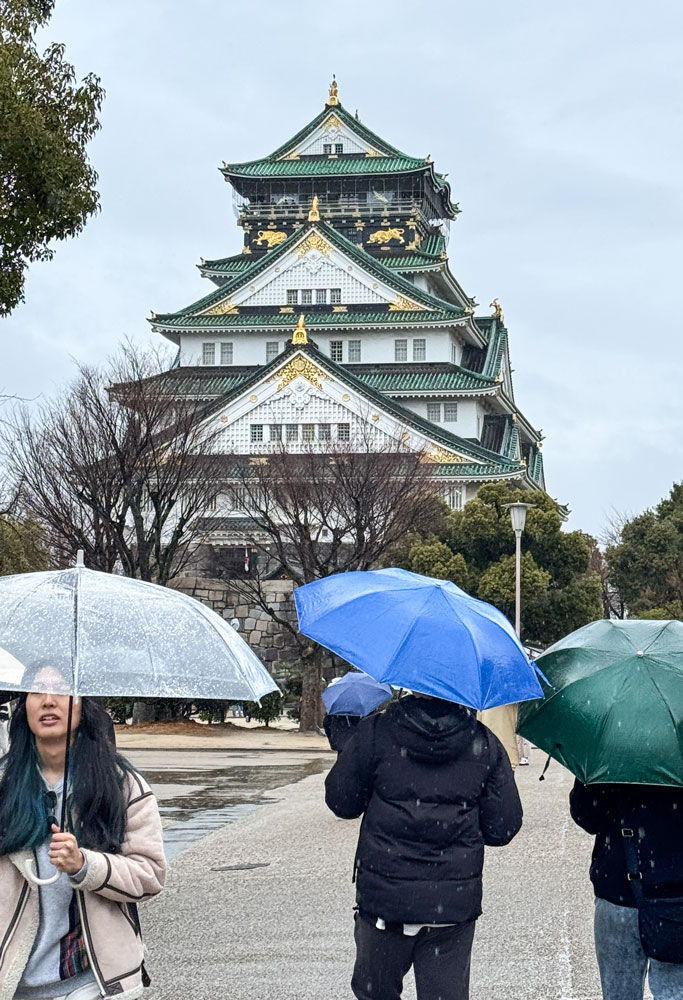
Judy asked for a dispensation because she's "stair averse" and they allowed her to use the elevator. We went up to the 8th floor and took some pictures from there.
One unusual thing I noticed was that there was no 6th floor indicated on the elevator. It went 1, 2, 3, 4, 5, 7, and 8. I don't know if it was just a skipped number, as hotels in the US skip the 13th floor, or if the 6th floor is there but used for something other than museum display (such as offices).
A few views from the top of the castle. That's the Hokoko Shrine on the right of the next picture.


The low structure with the rectangular domed roof is the Osaka-Jo Hall. It can seat 16,000 people.
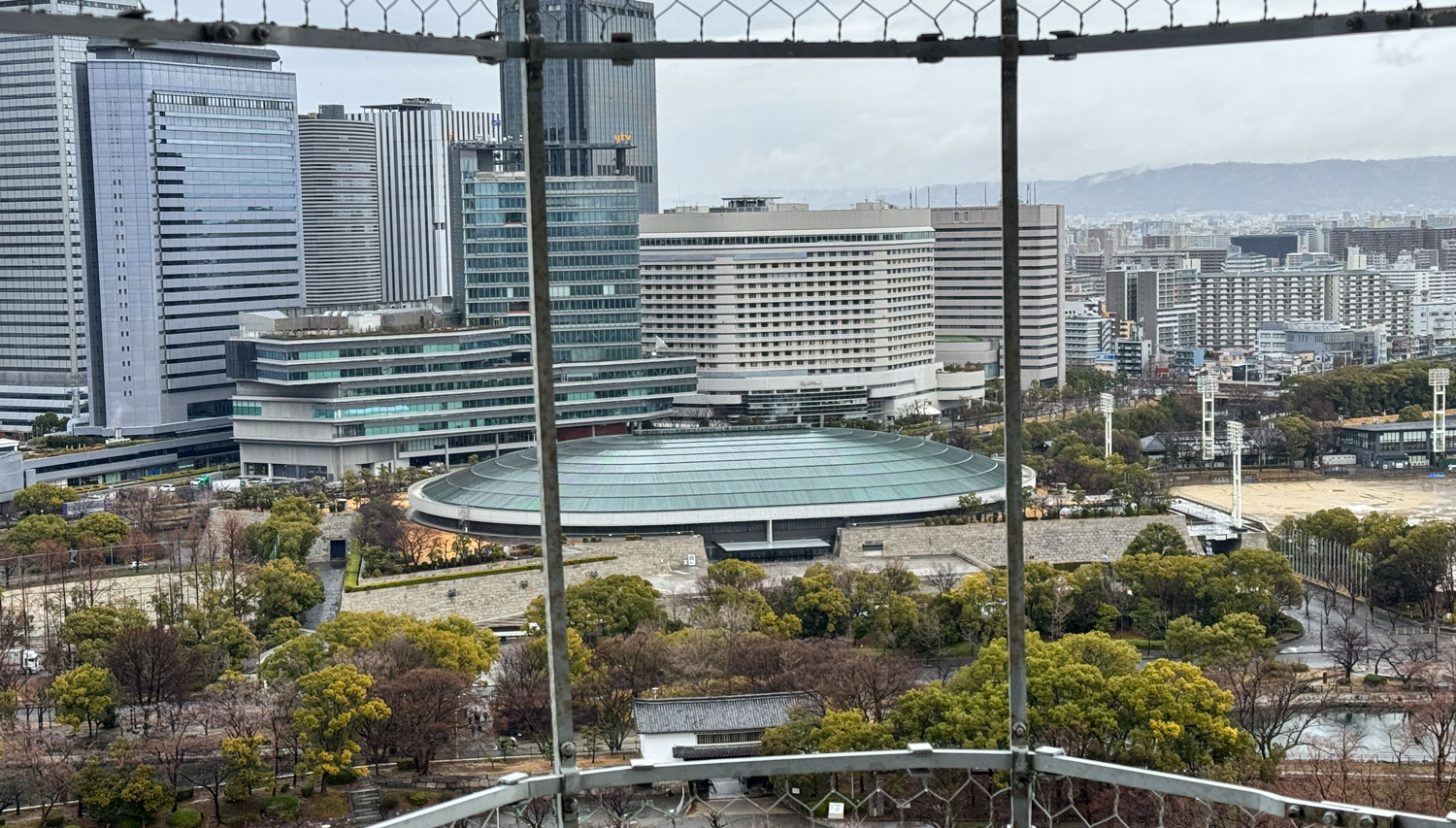
I have more pictures, but these are representative. We went down to the 5th floor to view some of the museum displays.
The museum is focused on the life of Toyotomi Hideyoshi who built the original castle in 1583. Here's part of a battle scene.
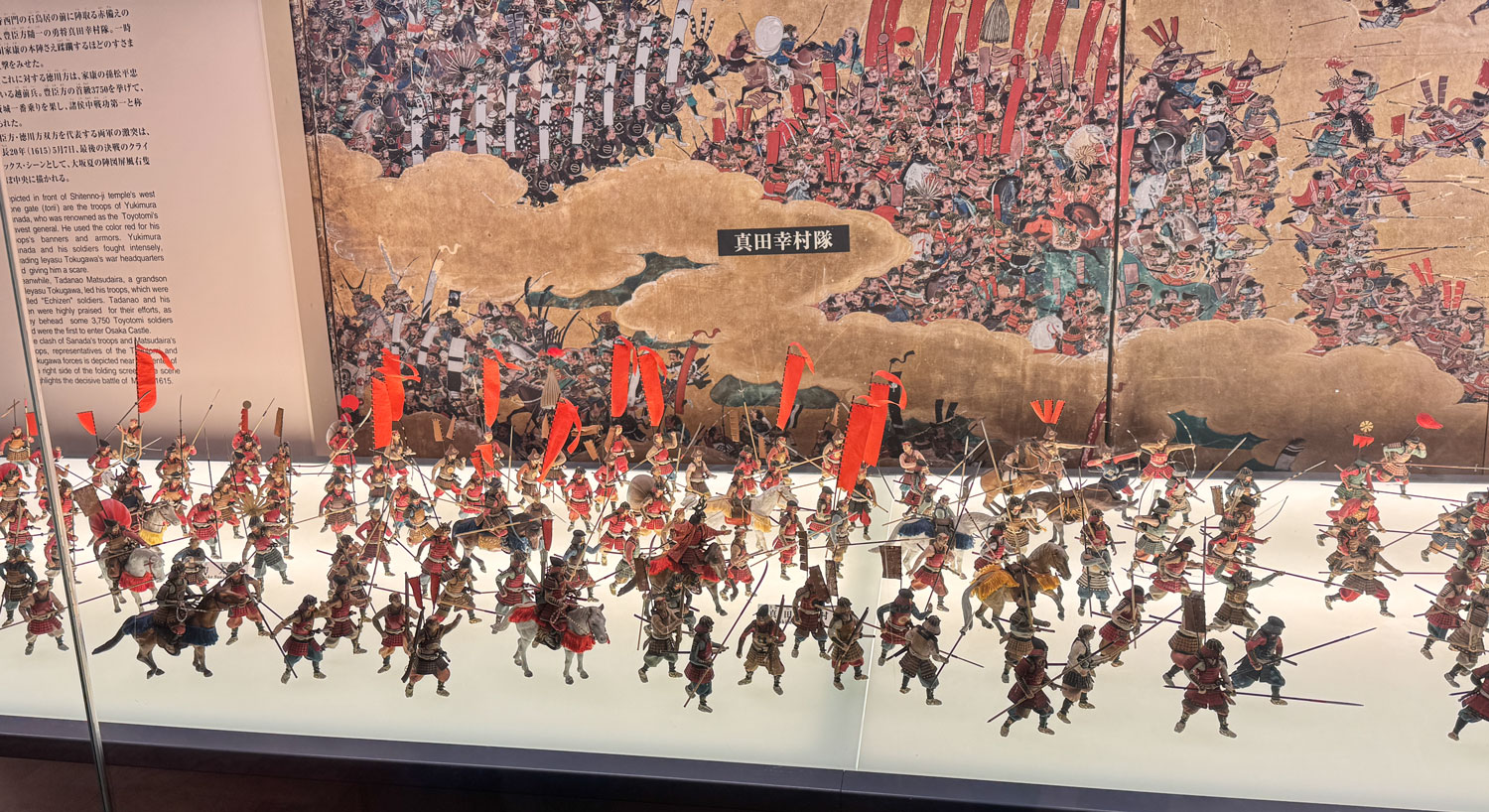
A lot of the exhibits were video displays illustrating the life of Toyotomi Hideyoshi, and I didn't take pictures of them. Here's a display I thought was interesting but I don't know what it all means. Tigers symbolize ferocity, though.
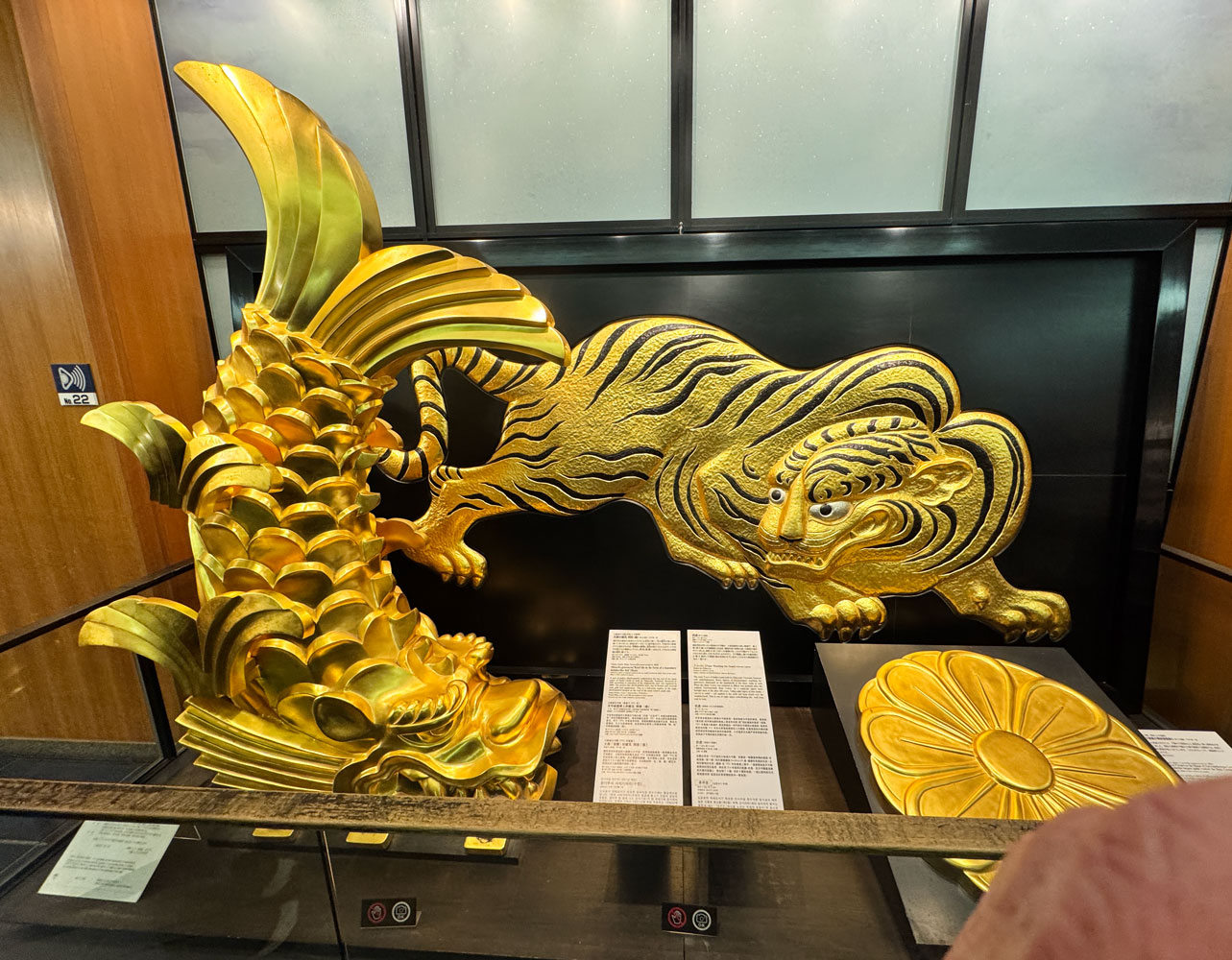
Pictures were not allowed on the 3rd and 4th floors, so I don't have anything to show you.
After we exited the castle, I took a better picture of it.
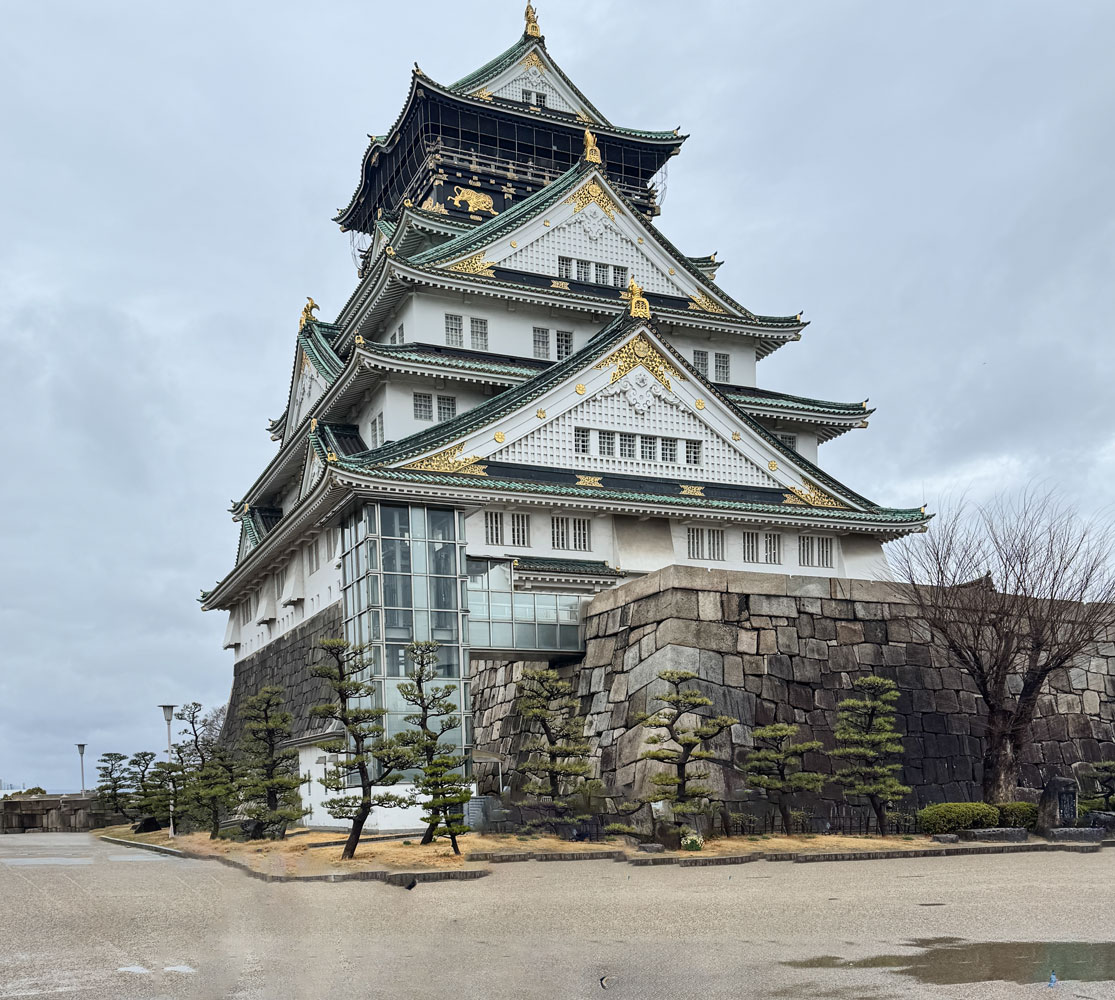
We went back to the ship, had lunch and the ship departed Osaka about 3pm, and then we played our usual Trivia game.
This evening was Krew Kapers night, where some of the crew put on a show for the guests.
The captain spoke before the show, thanking everyone for choosing Regent.
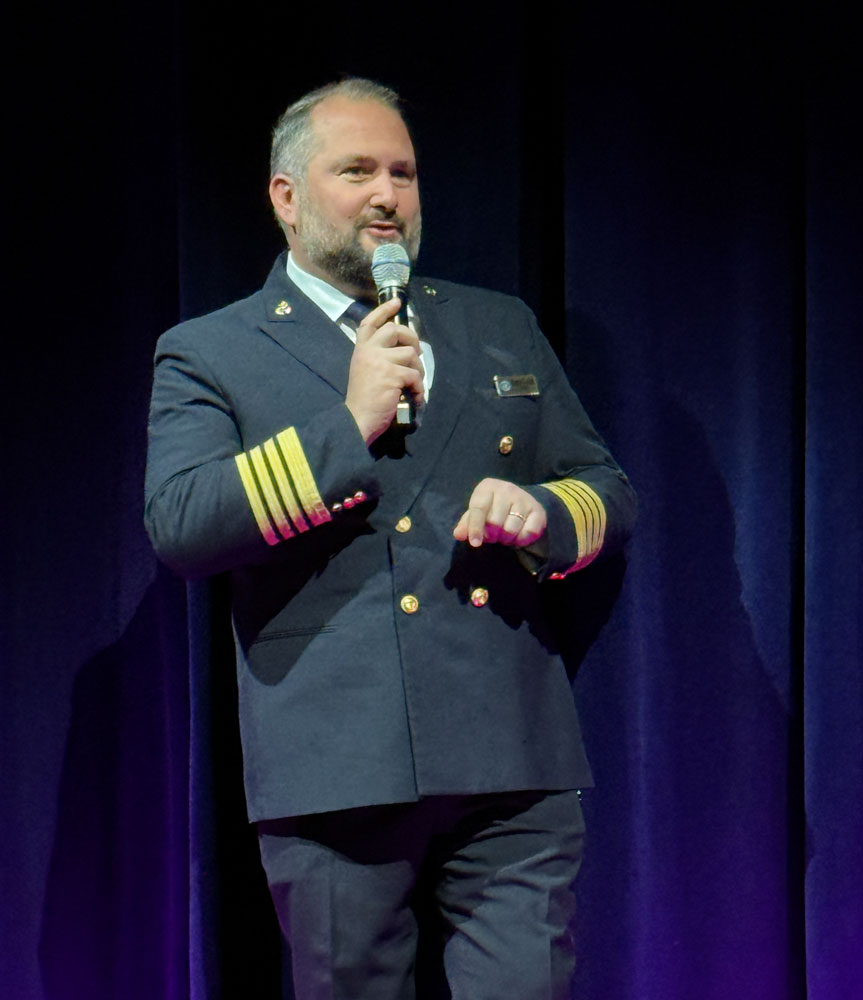
Then it was show time! I'll just put a few pictures of the acts.
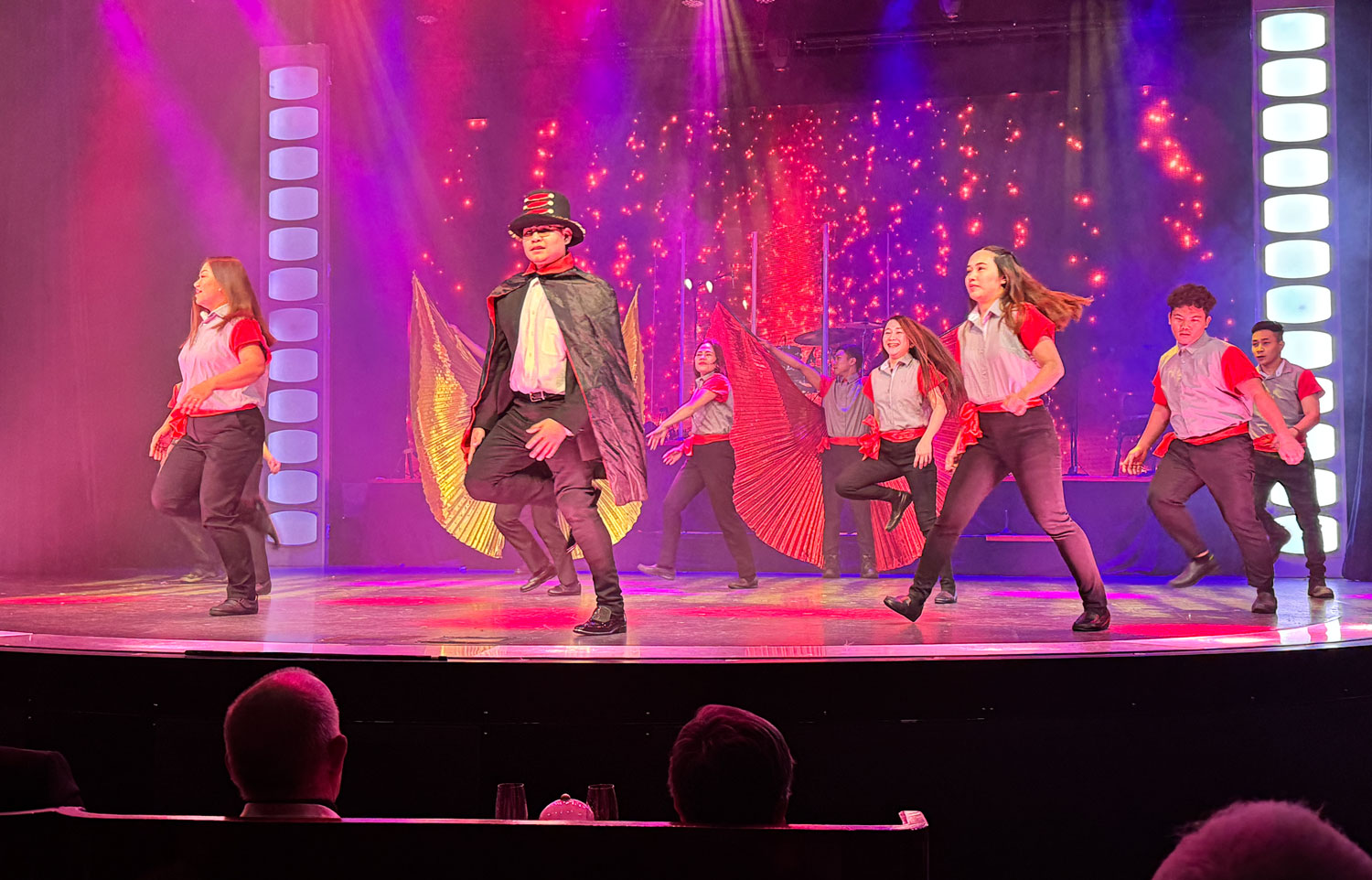
This act was of the Philippines, dancing between two clacking bamboo poles. The dancers had to really hop.
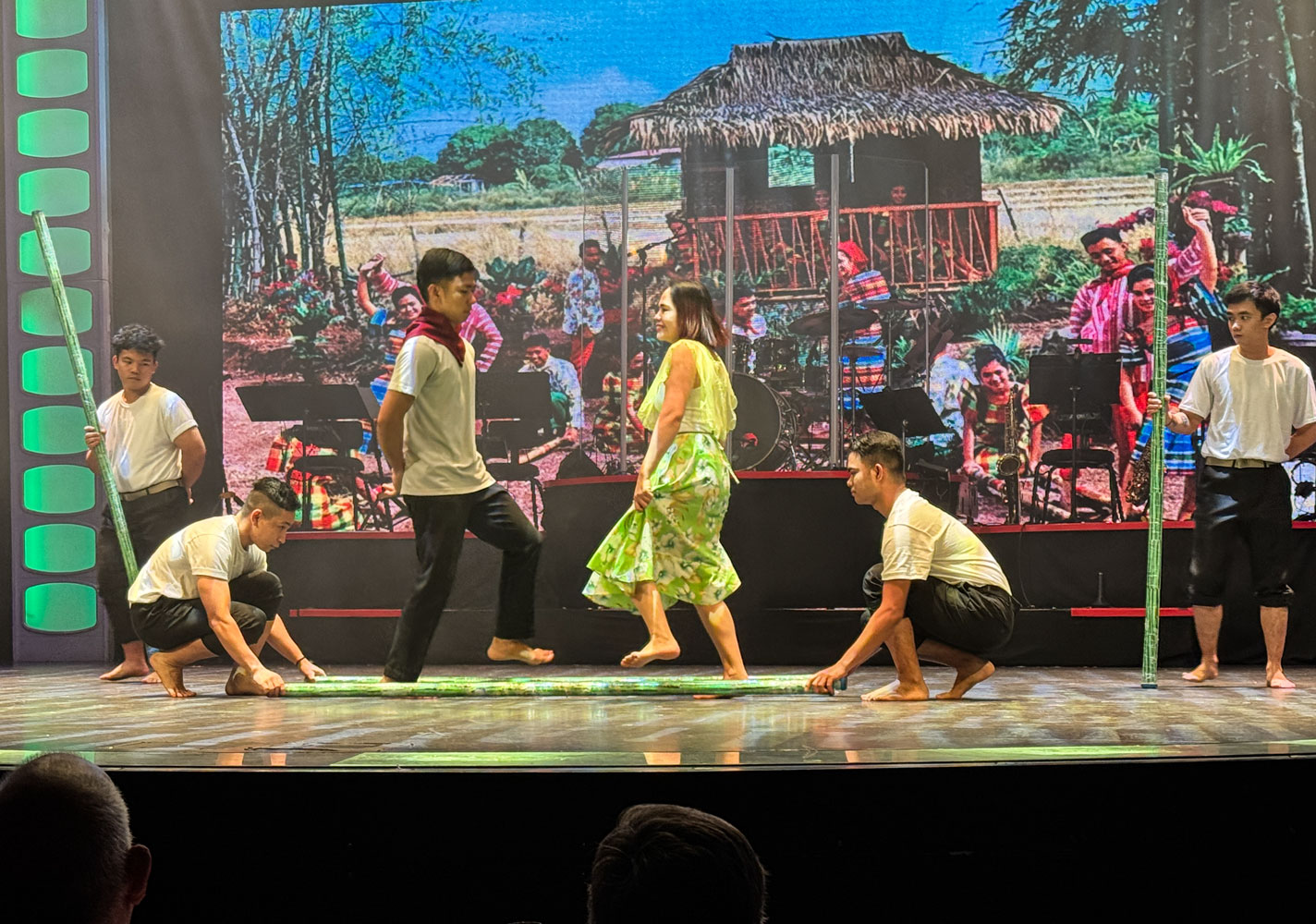
I think this act was from Indonesia.
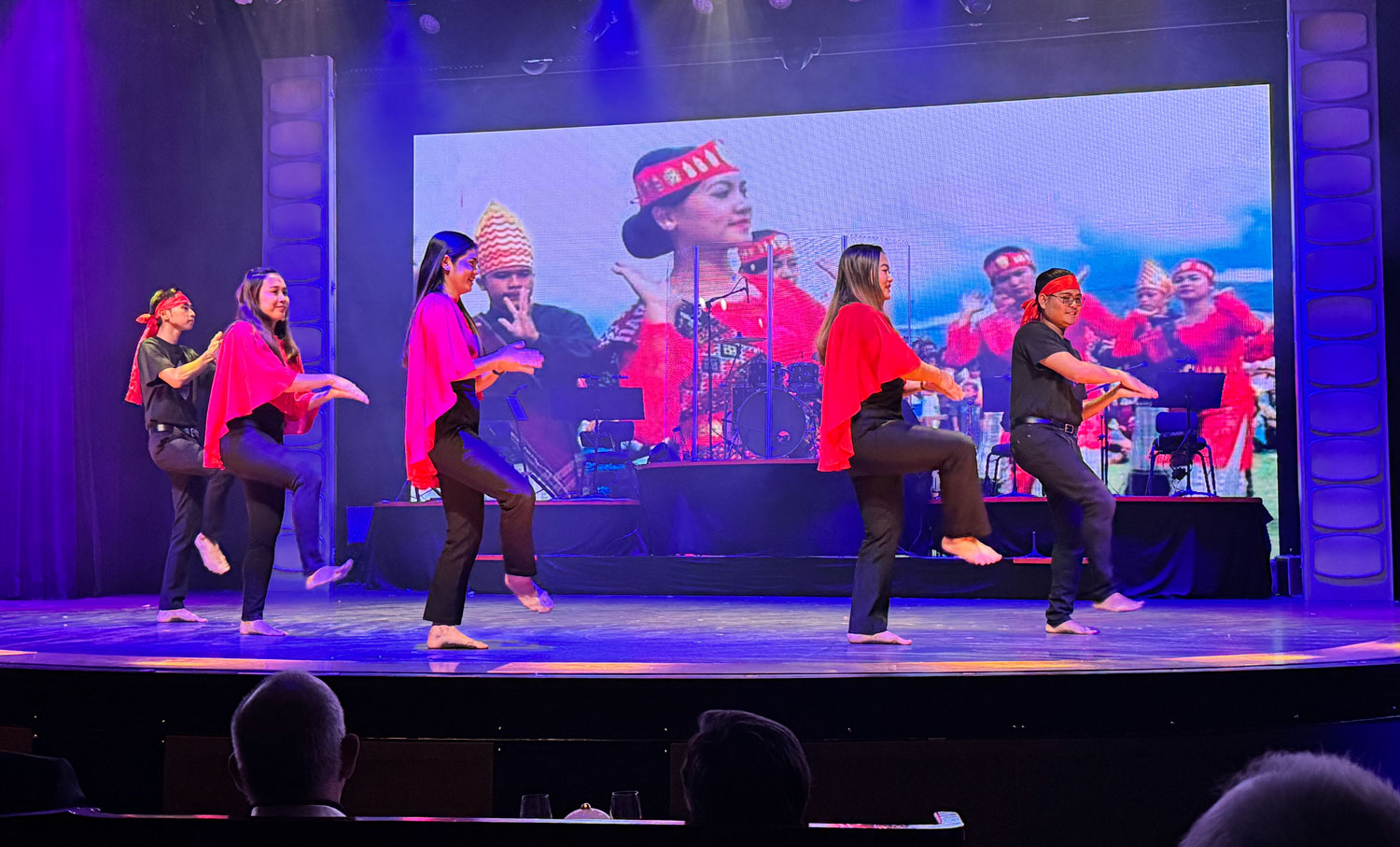
I have no idea where these guys were from, but they performed a funny pseudo-ballet with swans and tutus.
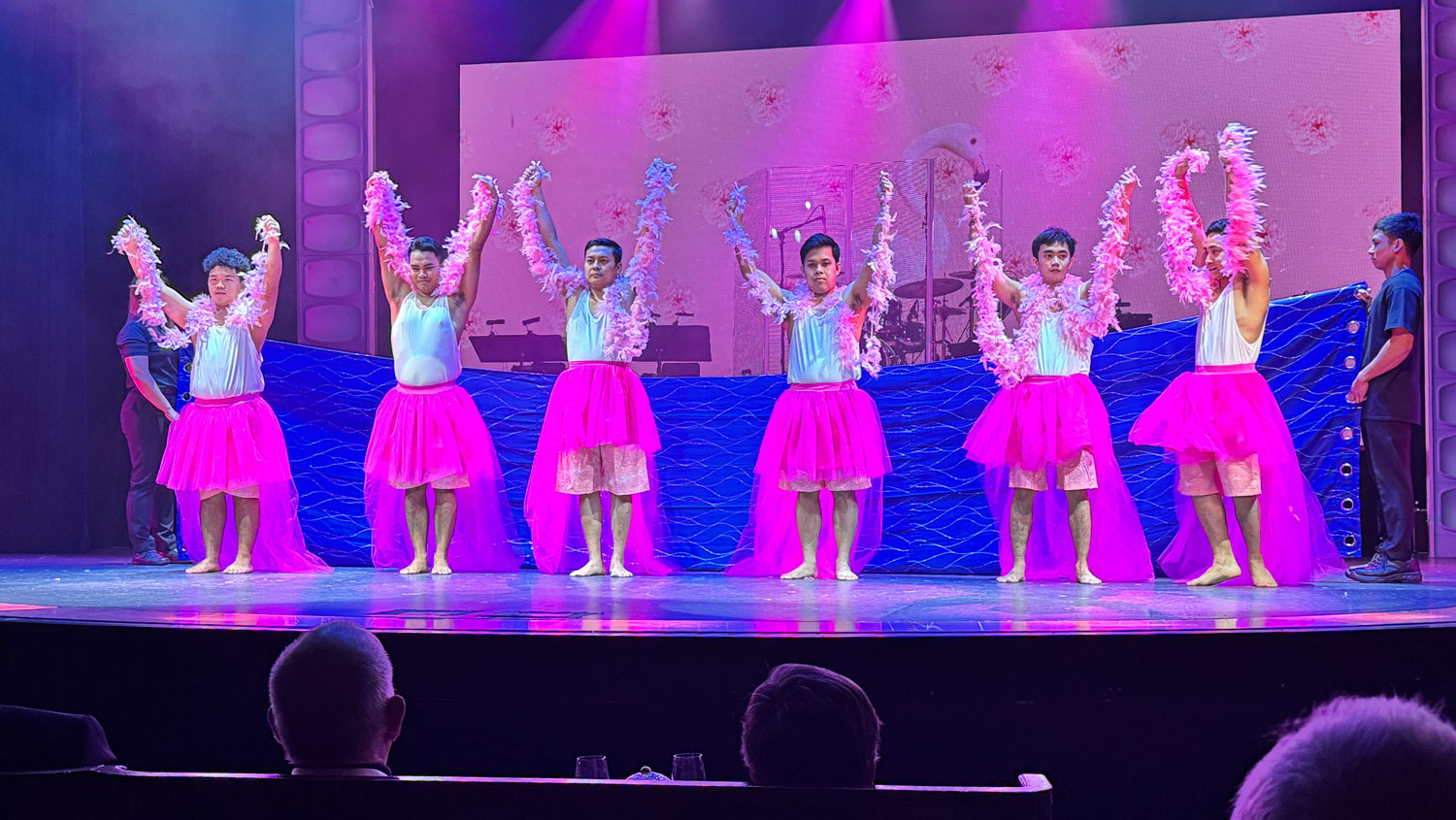
Then a group came out and led that crowd favorite, YMCA.
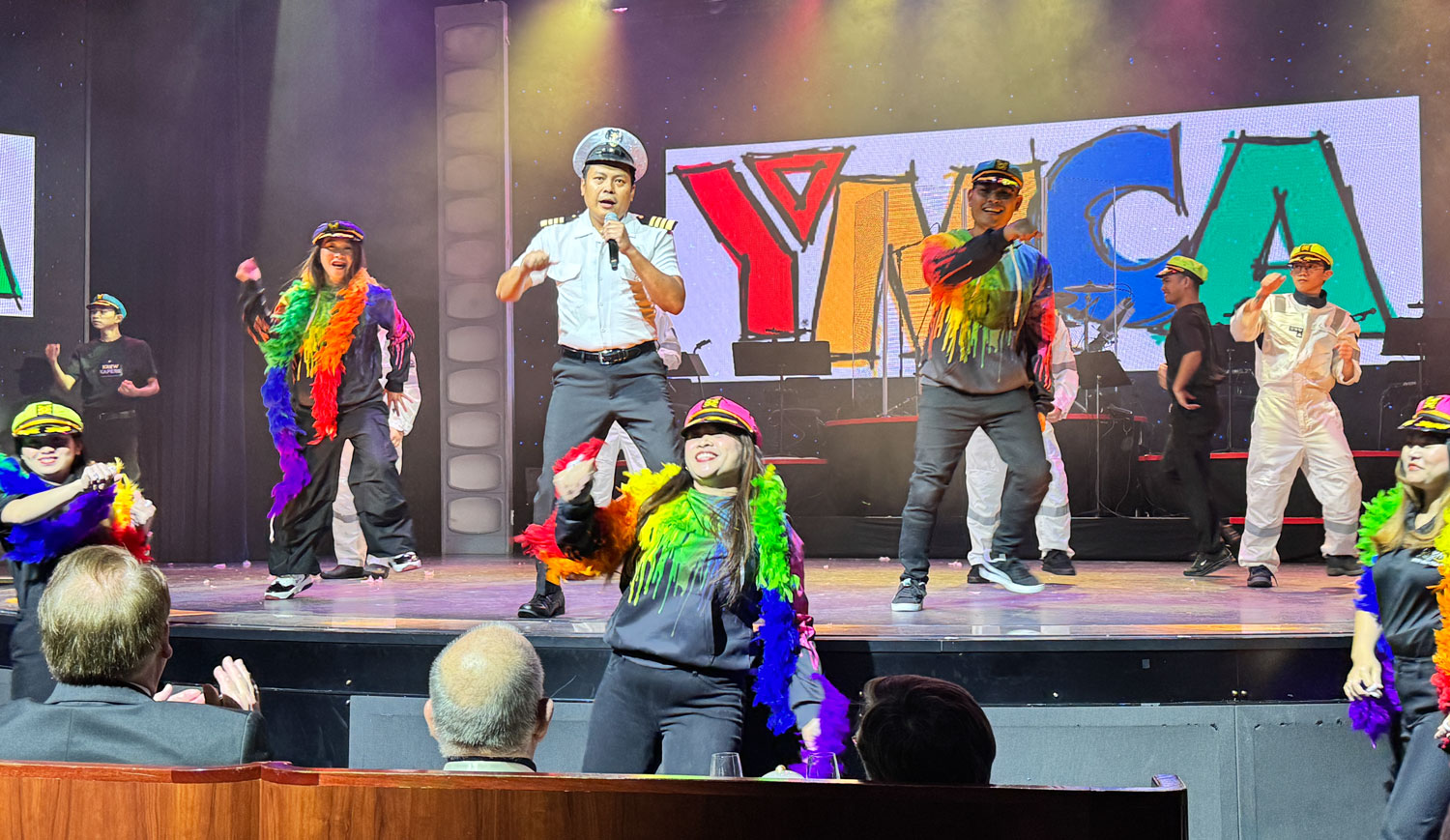
Then many of the crew members came on stage and were given a standing ovation.
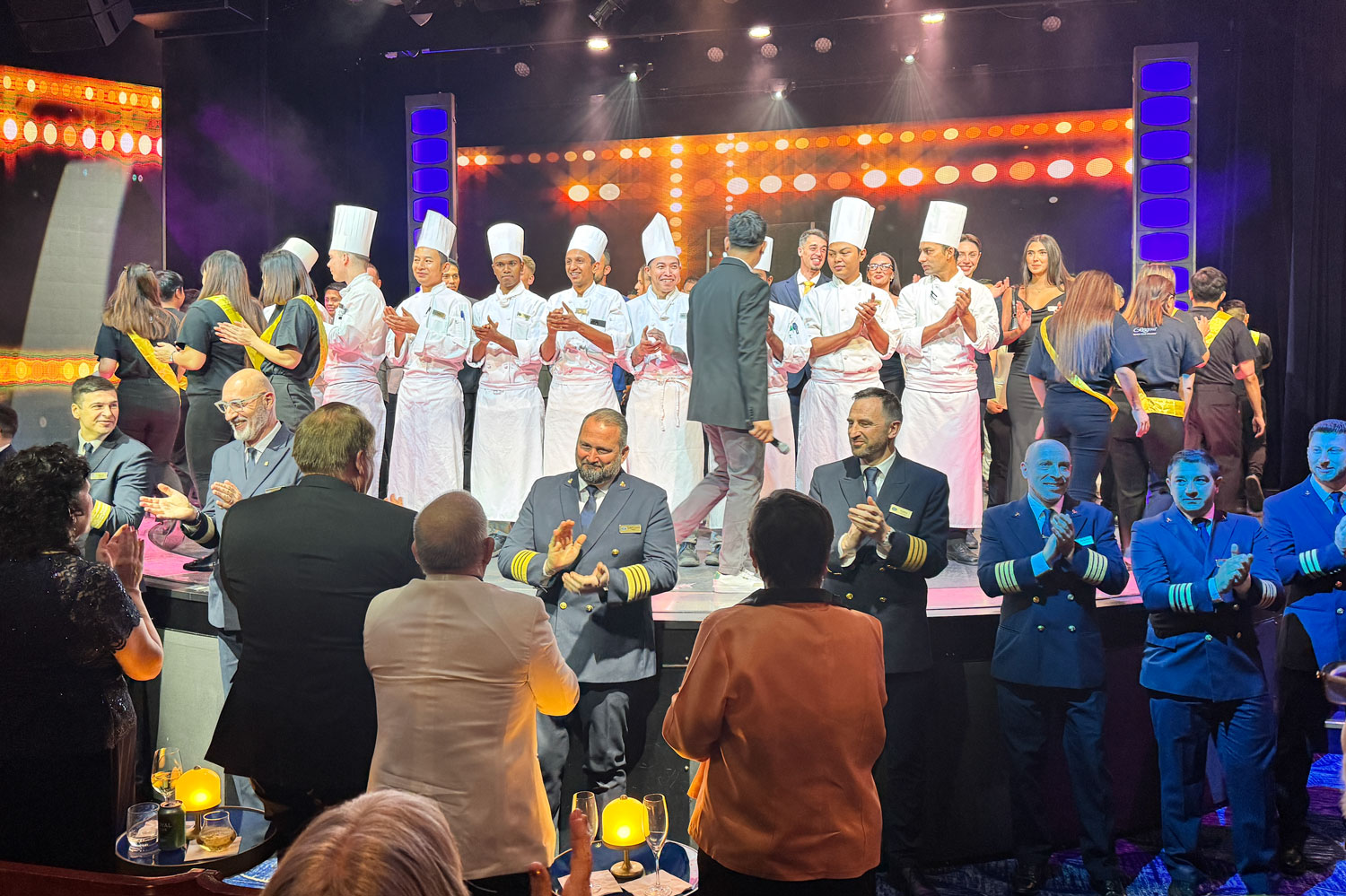
Next it was to dinner, and then to bed.
The seas were a bit high so we slept in our alternate cabin (764) this night.
+++++++++++++++++++++++++++++++++++++++++++++++++++++
3/4/2025 (Tuesday) We're in Nagoya this morning. It's cold (40 degrees) and rainy again. Our excursion is only 3 hours so maybe it won't be too bad. I dressed a bit warmer than I did yesterday.
We boarded the bus about 8:45am. Our first stop was the Nagoya Castle, originally built in 1612.
We arrived there about 9:30 and had a fairly long, wet walk from the bus parking area to the castle. Here's the castle.

The castle itself is closed for renovations. The original castle was destroyed in bombing raids during the Pacific War. It was rebuilt after the war.
The Honmaru Palace is open to the public and we went into it. First we had to take off our shoes. We were allowed to take pictures of the rooms and art in the Palace. The Honmaru Palace was destroyed in the same fire as the castle and was only rebuilt recently, opening in 2018.
Pictures of lions and tigers were used in the waiting rooms to show the power of the Shogun and impress those waiting.


A beautiful view further into the palace.
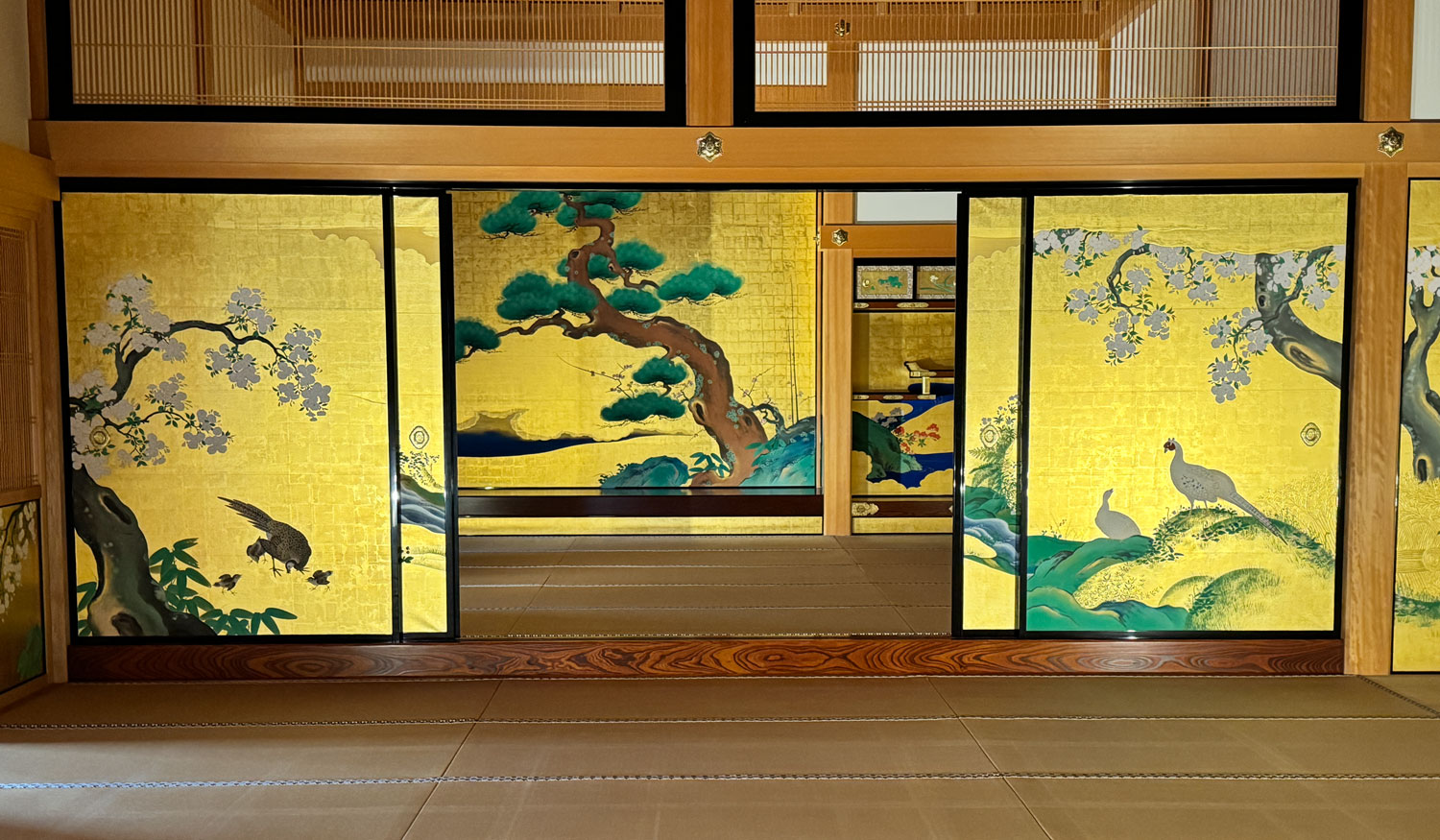
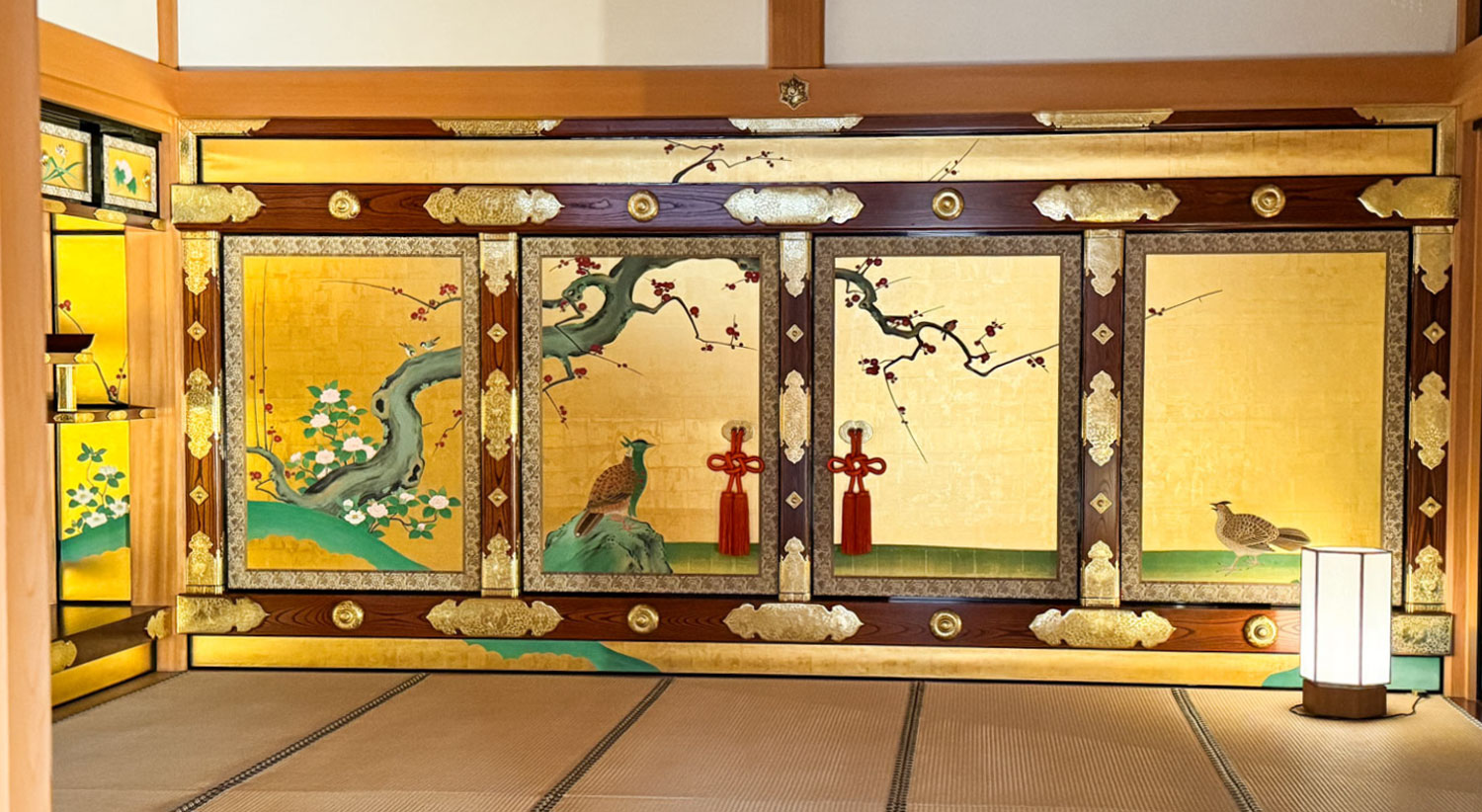
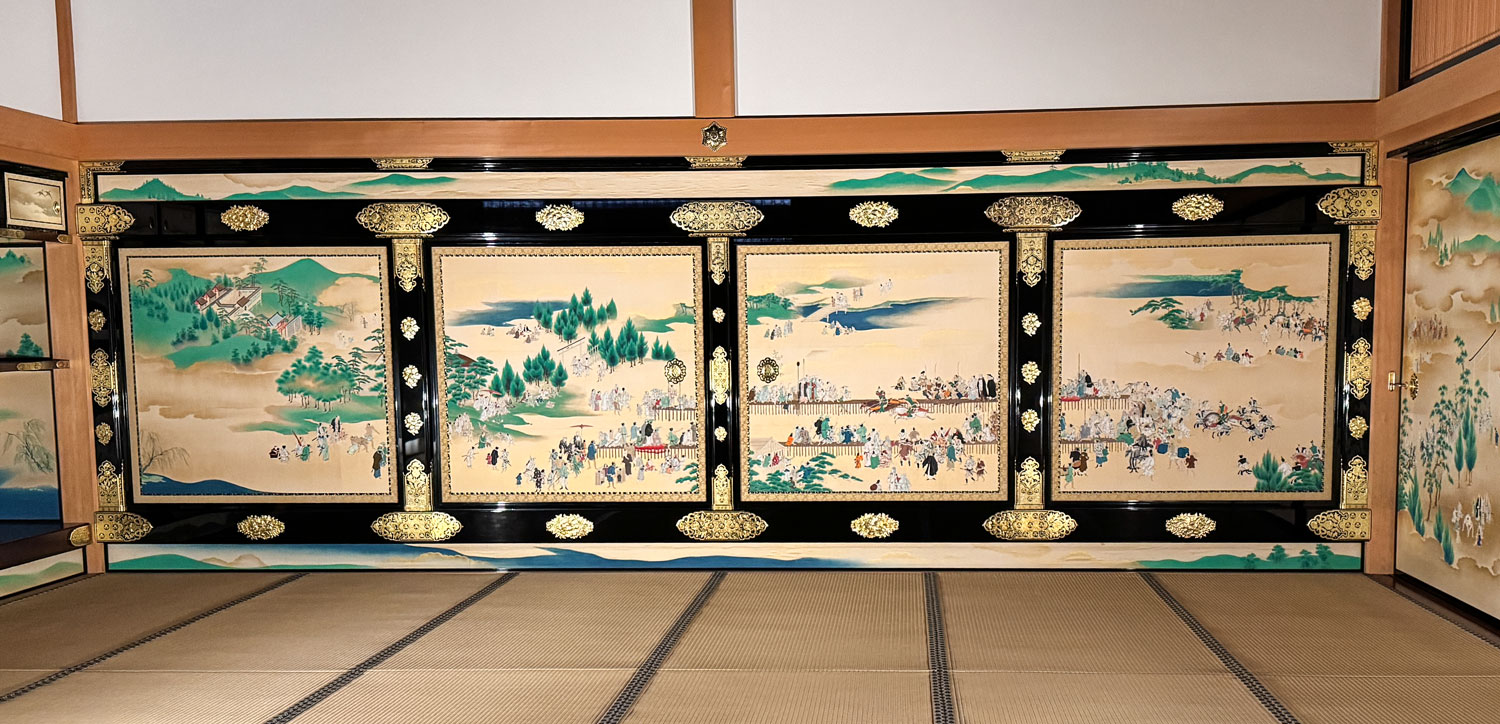
Here, I'm looking at the panels above the shoji screens. These are called transom panels.
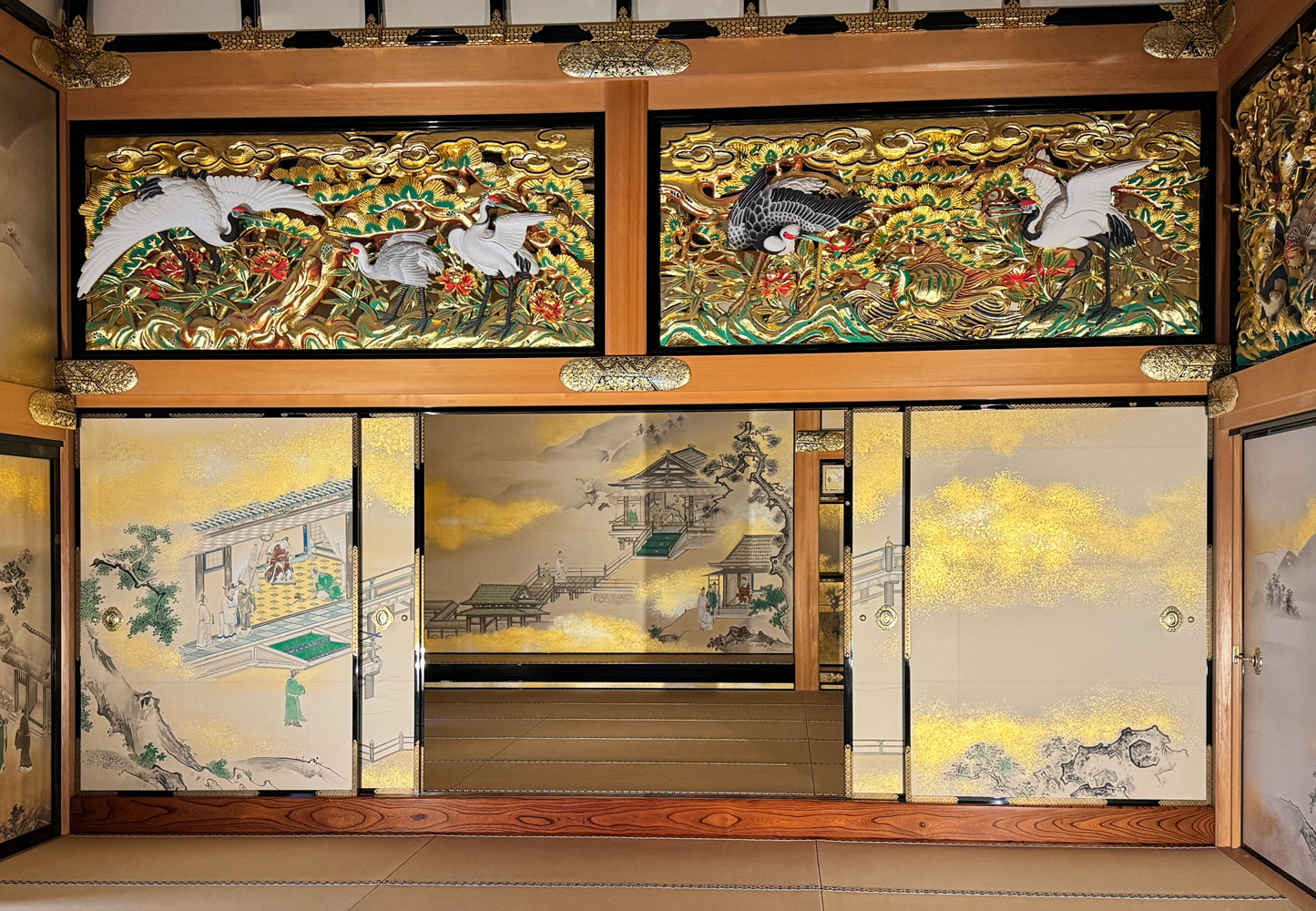
A closer view of one of the panels.
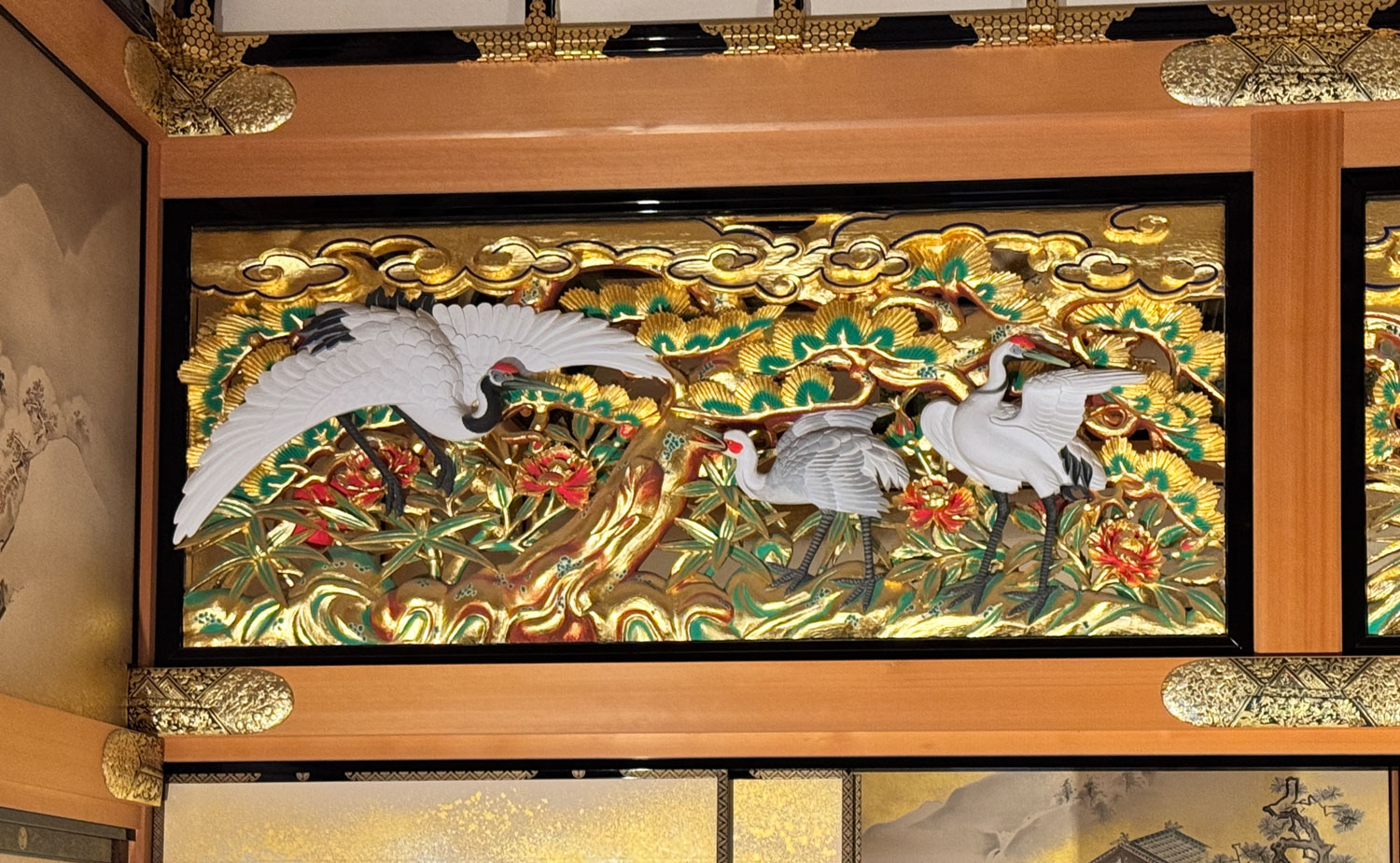
A panel from another room.
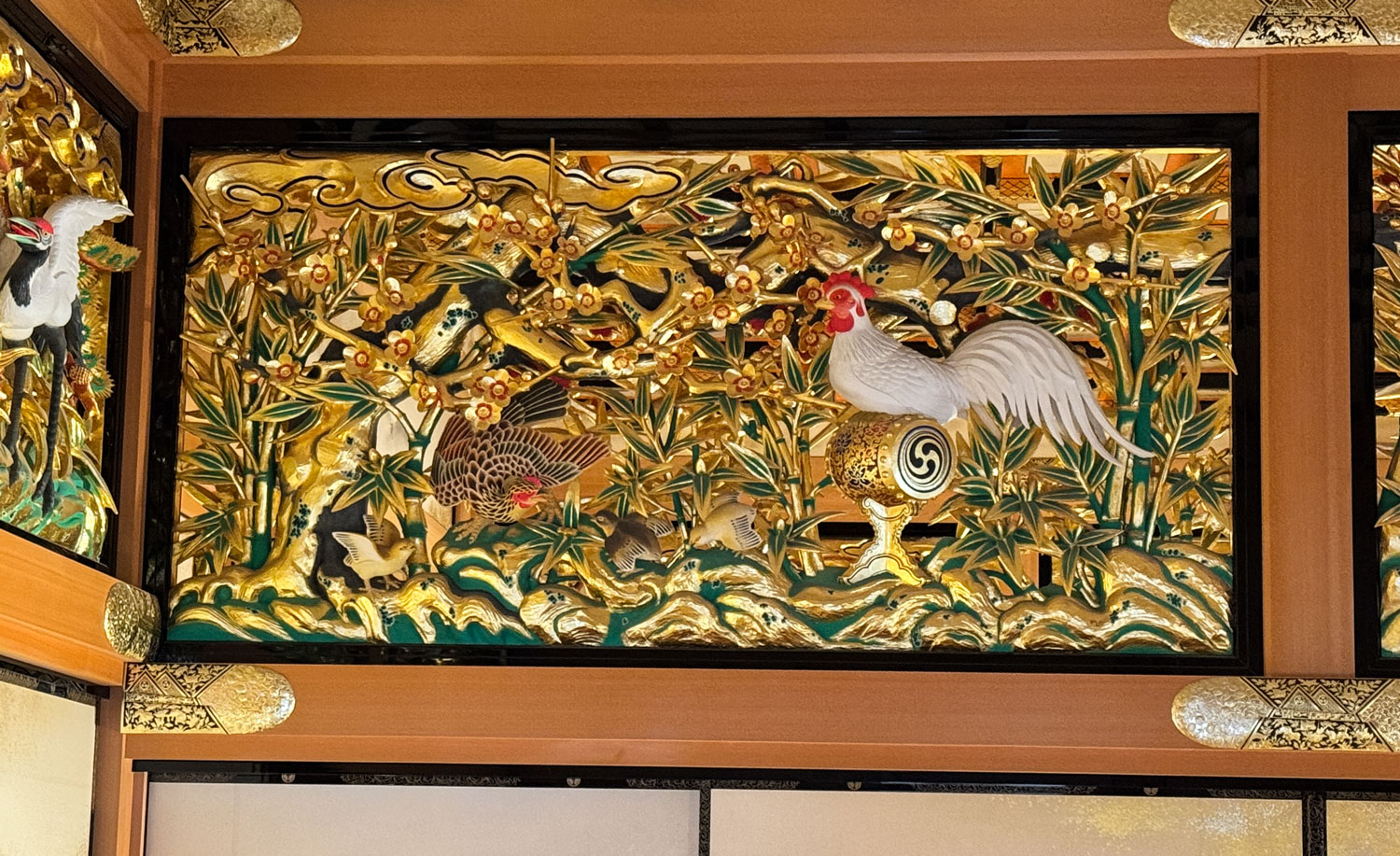
Another room.
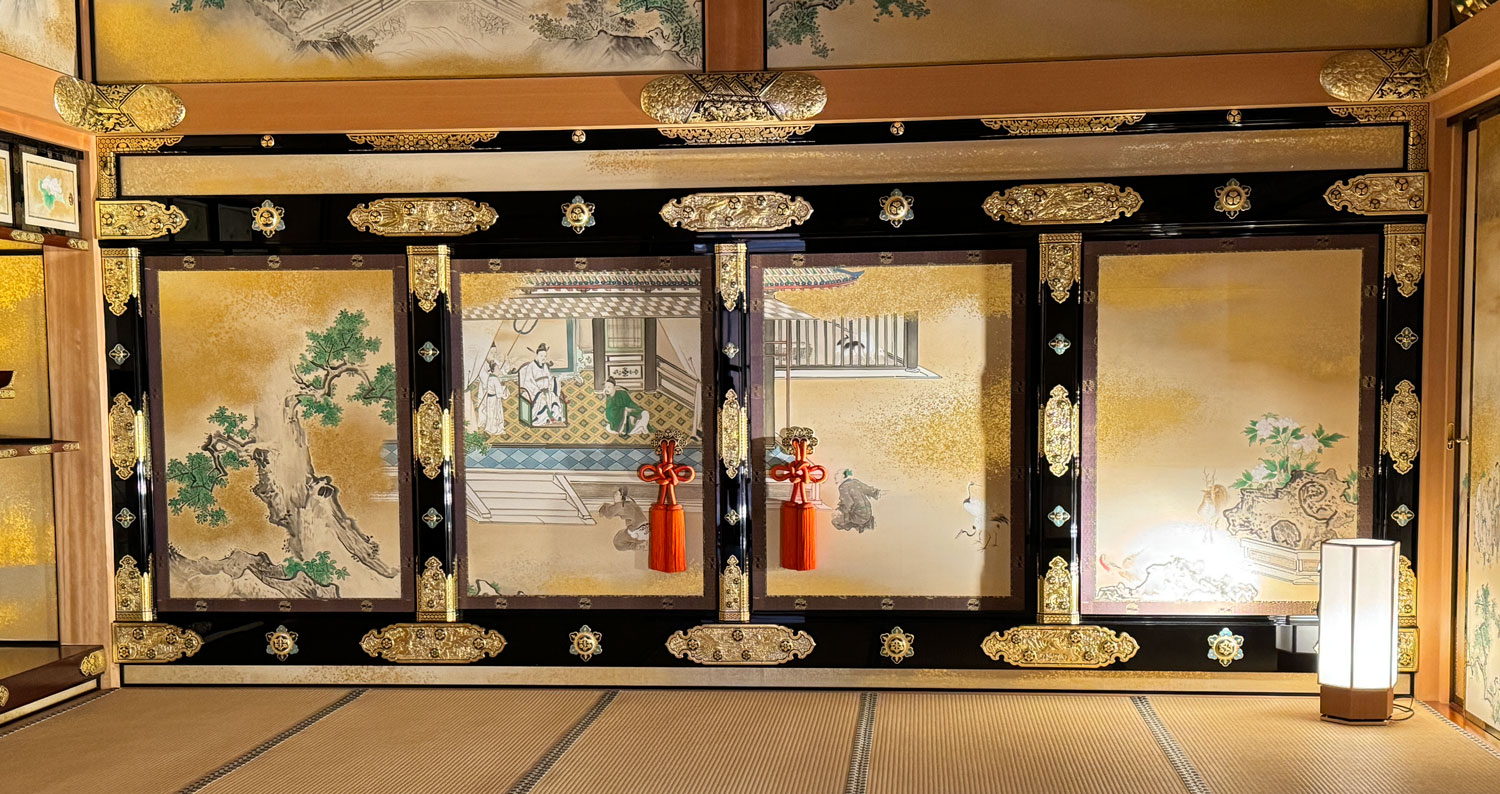
I have more pictures but that's enough to give you an idea of how the palace was decorated.
From there, the bus took us to Shirotori Gardens, a Japanese "stroll" garden. It was still raining so we didn't spend a lot of time there. Here's some of what we saw.
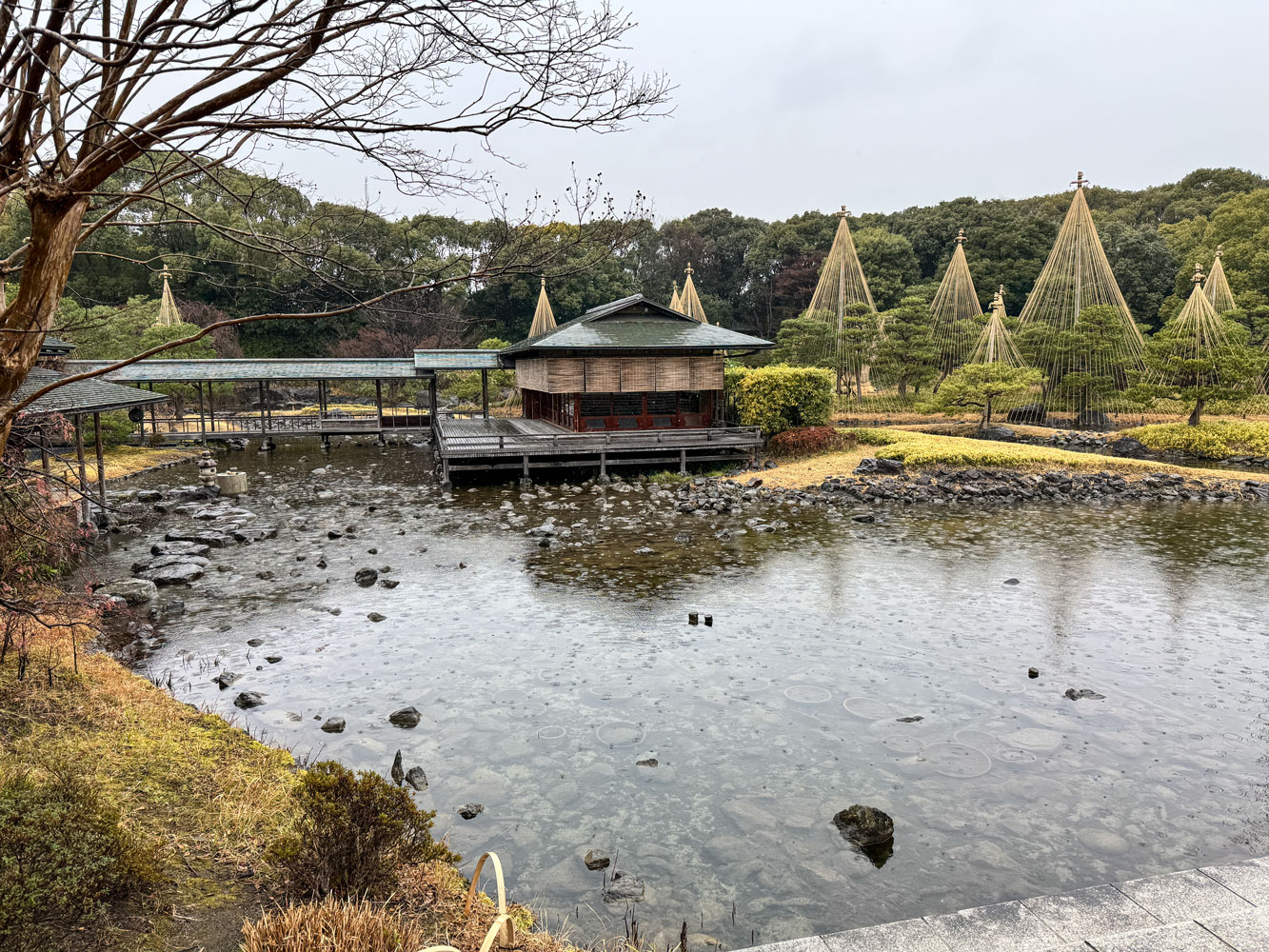
There was a Japanese couple in traditional kimonos being photographed in the garden. You can see raindrops in this photo, especially against the man's black coat, and the ripples in the water behind them.

Another garden scene.
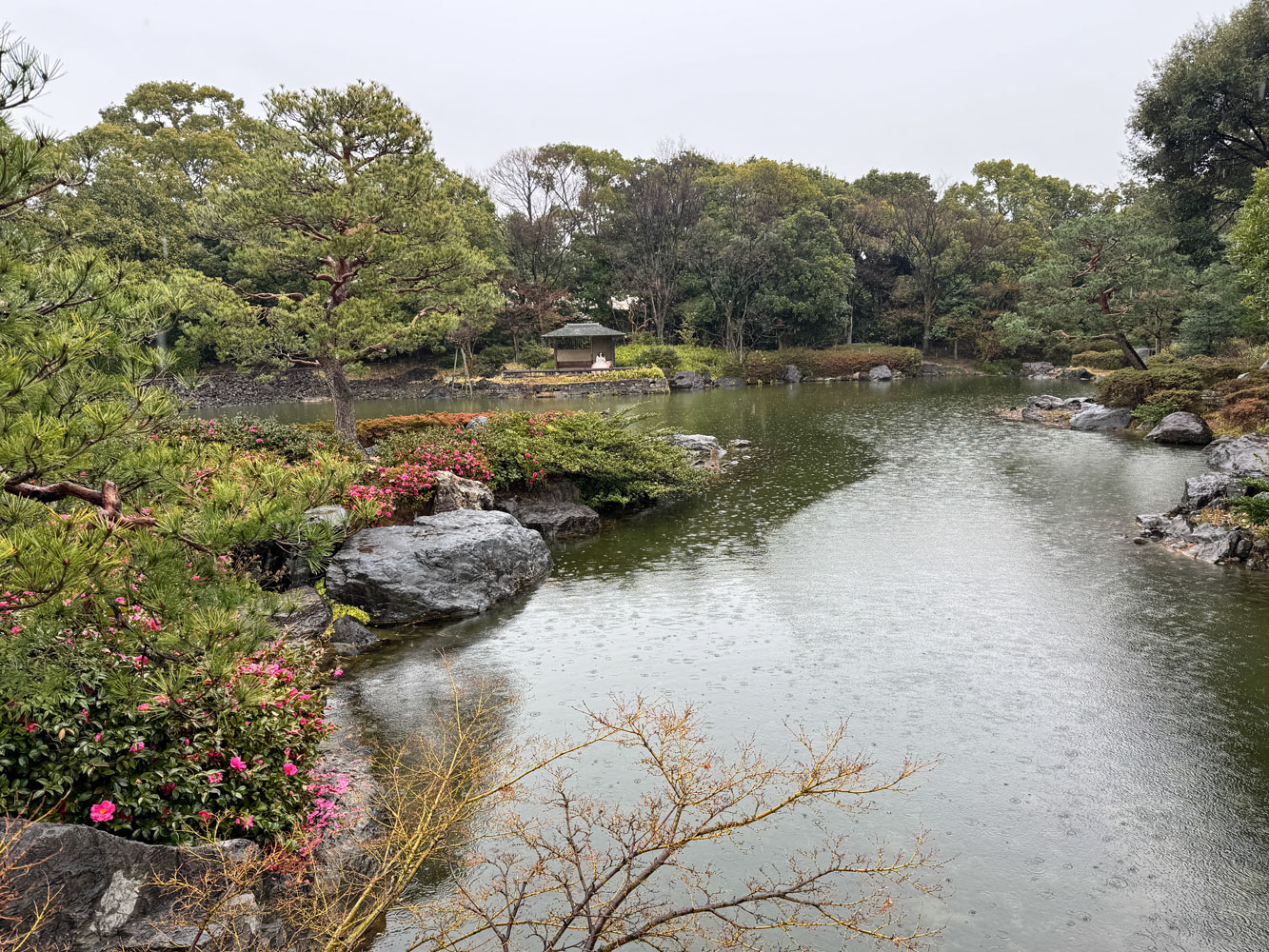
Another picture of the Japanese couple. They were gamely working to get the pictures, even though it was raining and they were holding paper umbrellas.
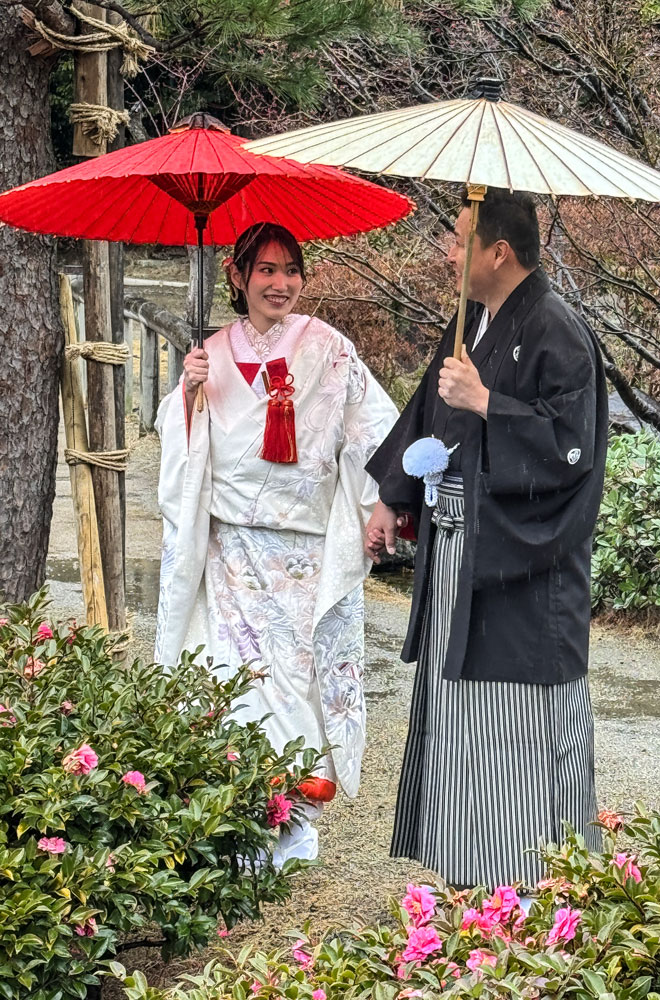
The cherry blossoms were just starting to appear.
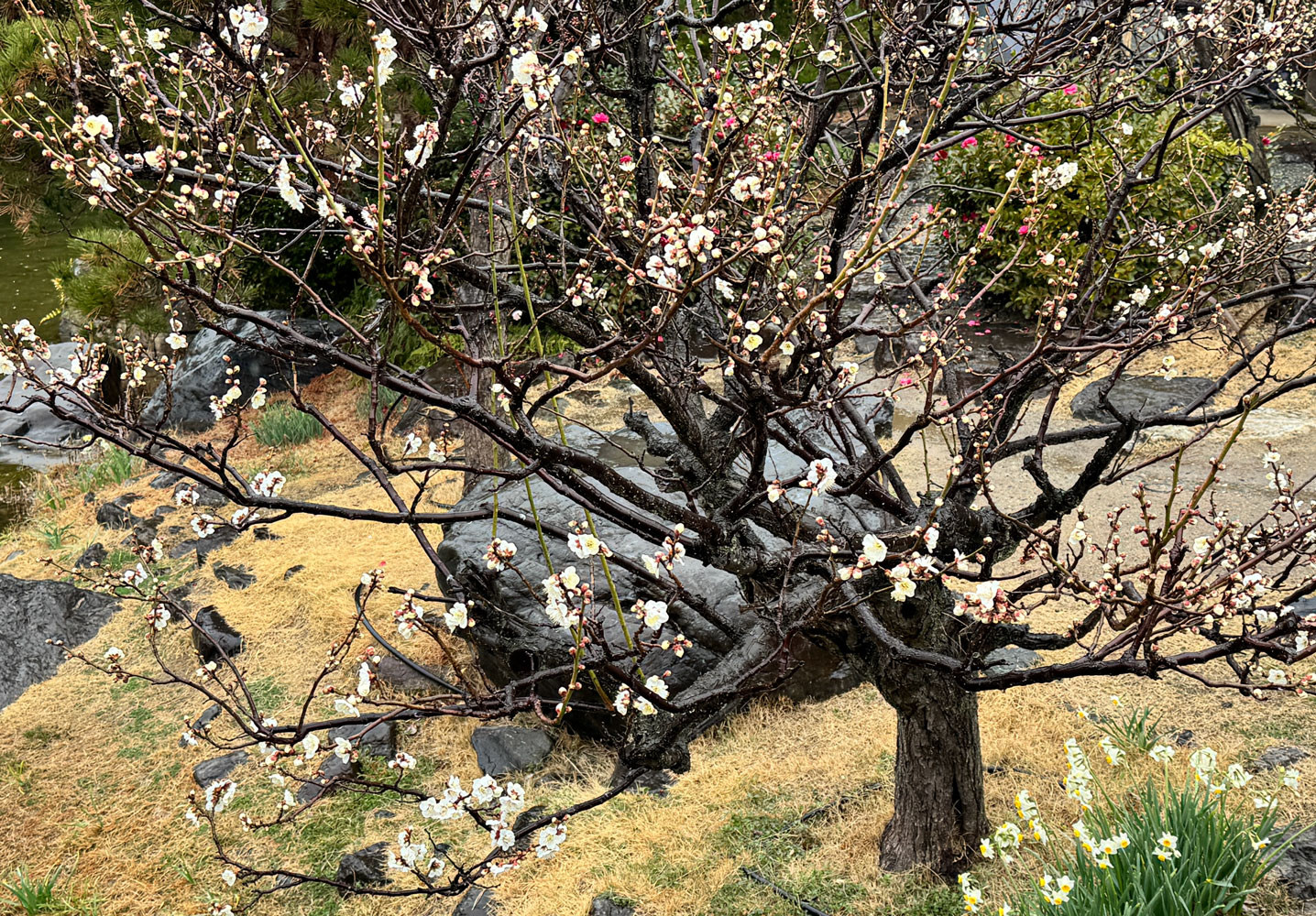
Closer look.
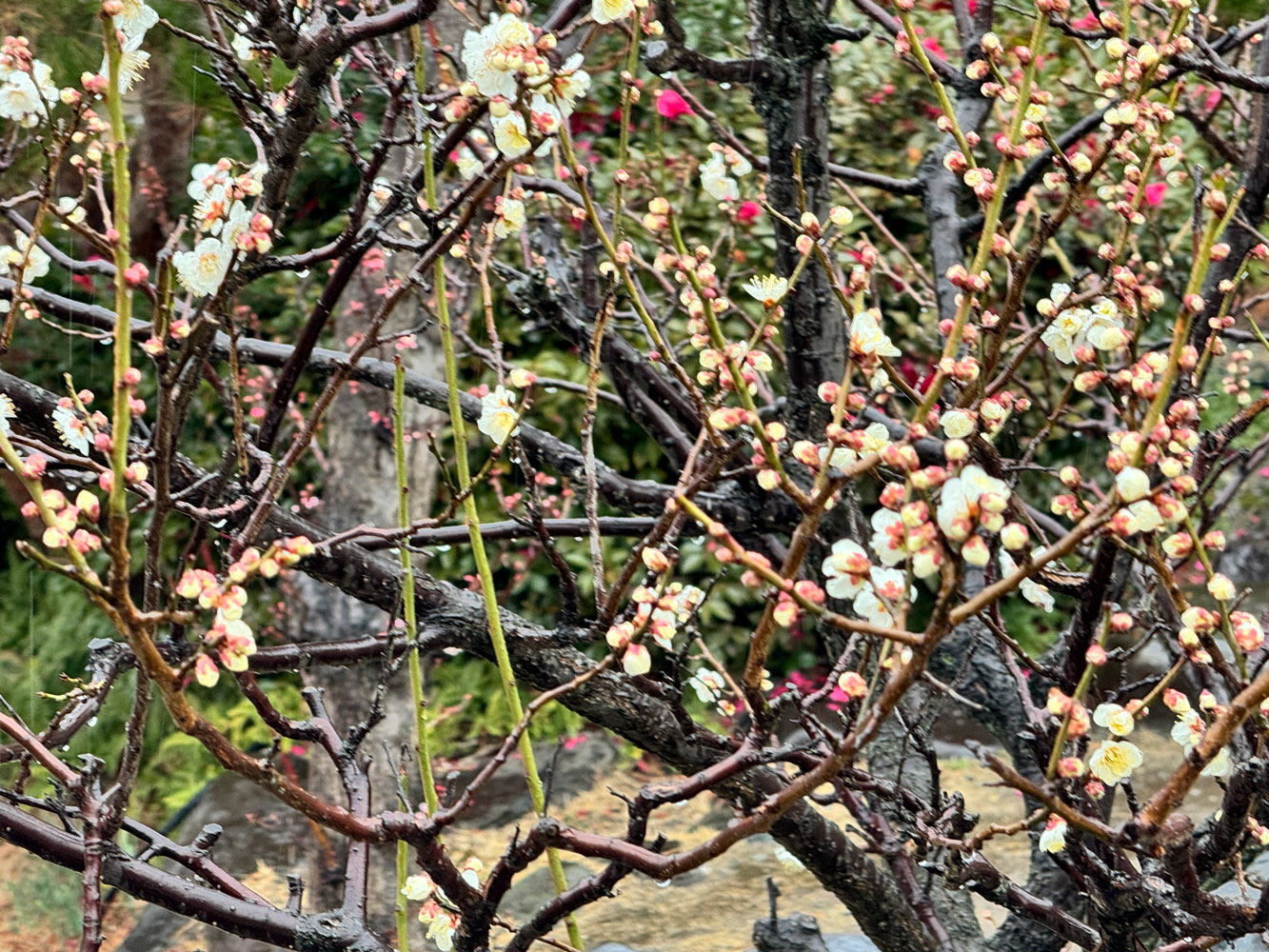
We left the garden and went to a Atsuta-jomgu Shinto Shrine. Here's the entrance, with Tori Gates. Only shrines have Tori Gates. Temples do not use them. It was still raining, but mostly just a mist, not hard rain.
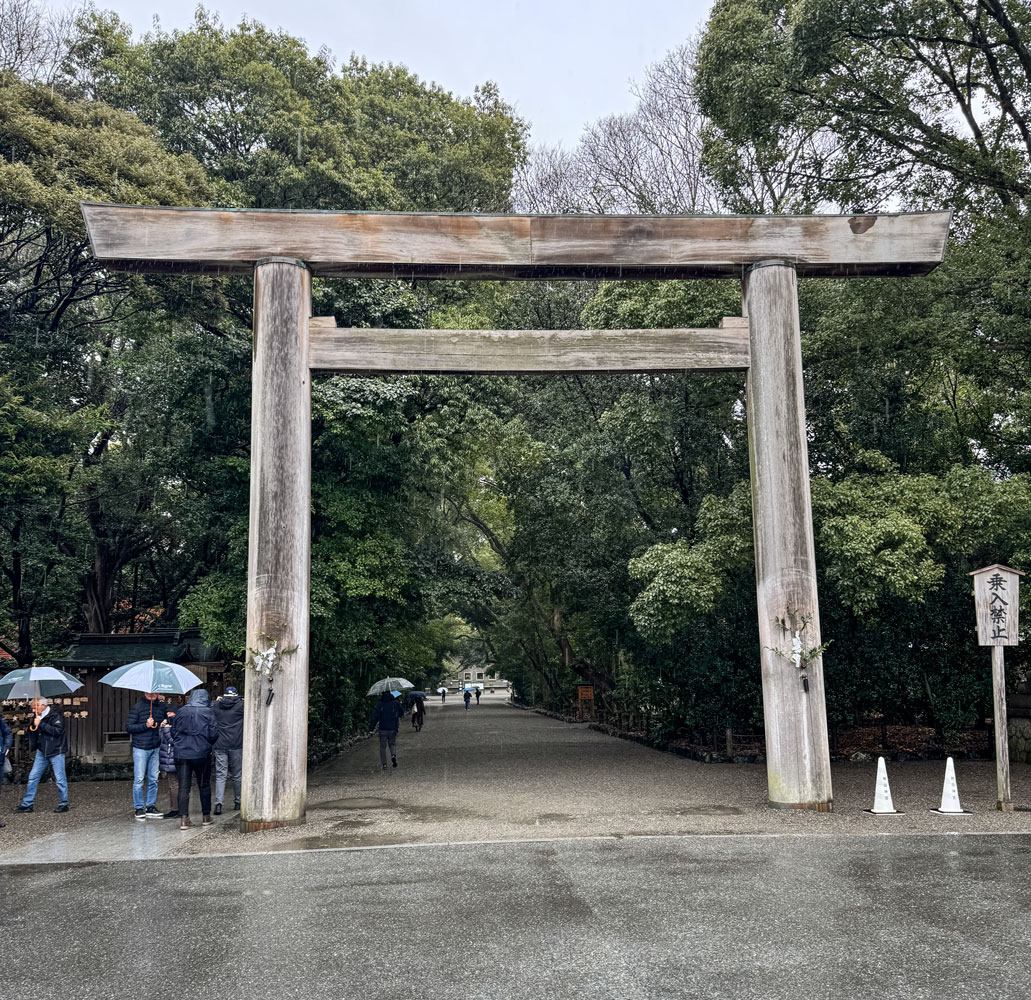
Here's a water feature where the faithful wash their hands before going on to the shrine.
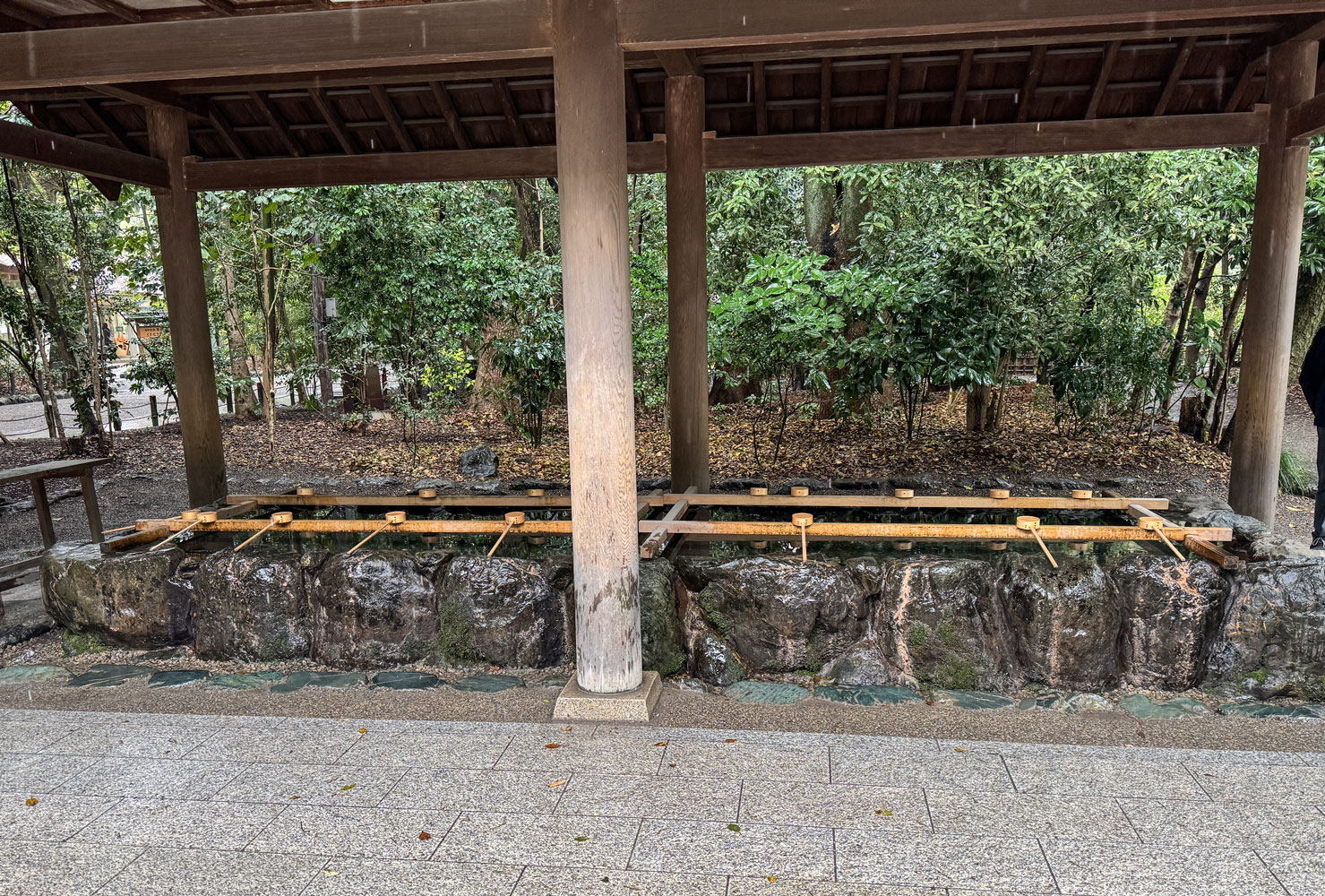
Next to the water feature was this building with sake barrels. I have no idea what sake has to do with a Shinto Shrine.
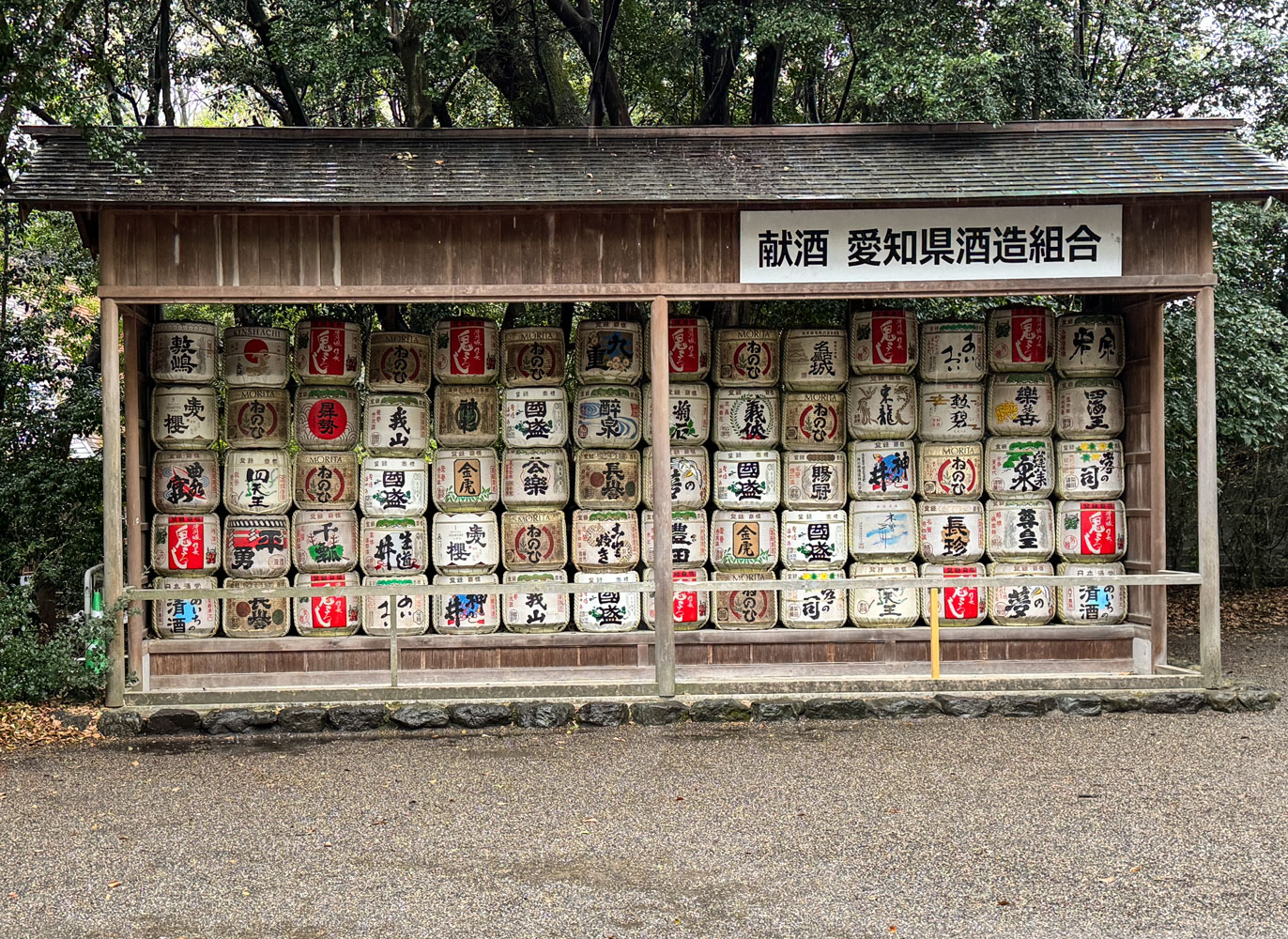
This was a "gate" that led to the haiden (the Shinto shrine building). They asked us not to take any pictures of the area beyond the gate, but Judy and I did go up the steps to see the entrance and the grounds between the gate and the haiden. It was actually very simple.
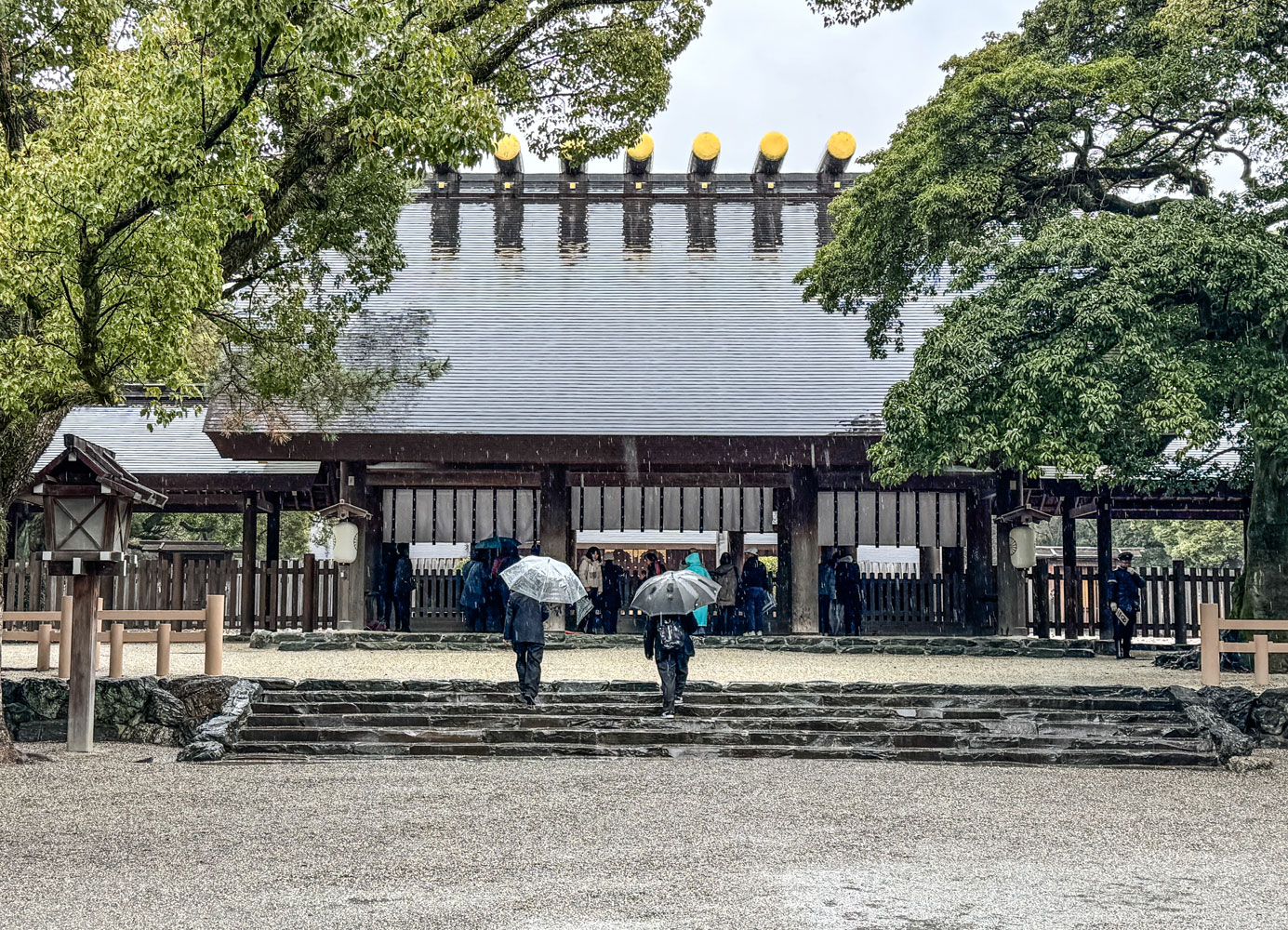
After that, the bus took us back to the ship. It was still raining.
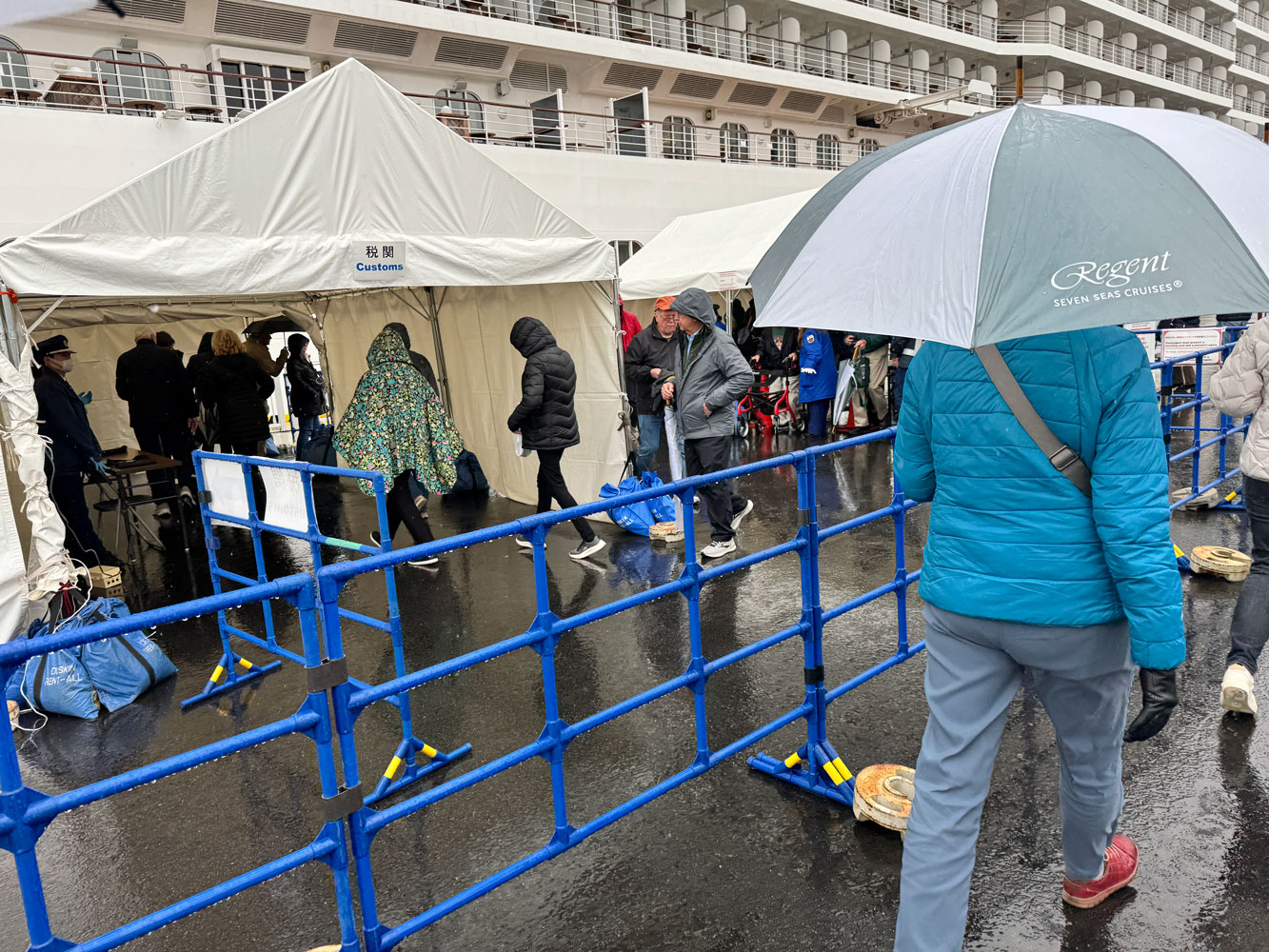
That afternoon we could redeem our Regent points for swag. I waited in line and got a black windbreaker for Judy, then ran up to the Observation Lounge to join Trivia, which was already in progress.
We did dinner in the Compass Rose and they had Wiener Schnitzel on the menu, which is one of my favorites. The waiter said that it was traditional to server Wiener Schnitzel on the last day of each cruise.
Tomorrow we depart the ship in Tokyo and we must have our checked bags out in the hallway by 10pm, which we did.
+++++++++++++++++++++++++++++++++++++++++++++++++++++
3/5/2025 (Wednesday) The ship docked in Tokyo this morning about 7am, and we disembarked at 8:30. Our Air Canada flight from Narita Airport doesn't depart until 6pm, so Regent arranged for a short sightseeing excursion in Tokyo so that we don't get to the airport too early.
The first place the tour guide took us was to the grounds of the Imperial Palace. It was raining fairly hard when we got there and many of the guests stayed on the bus.
The first thing we saw was this statue of Kusunoki Masashige, a 14th century samurai.
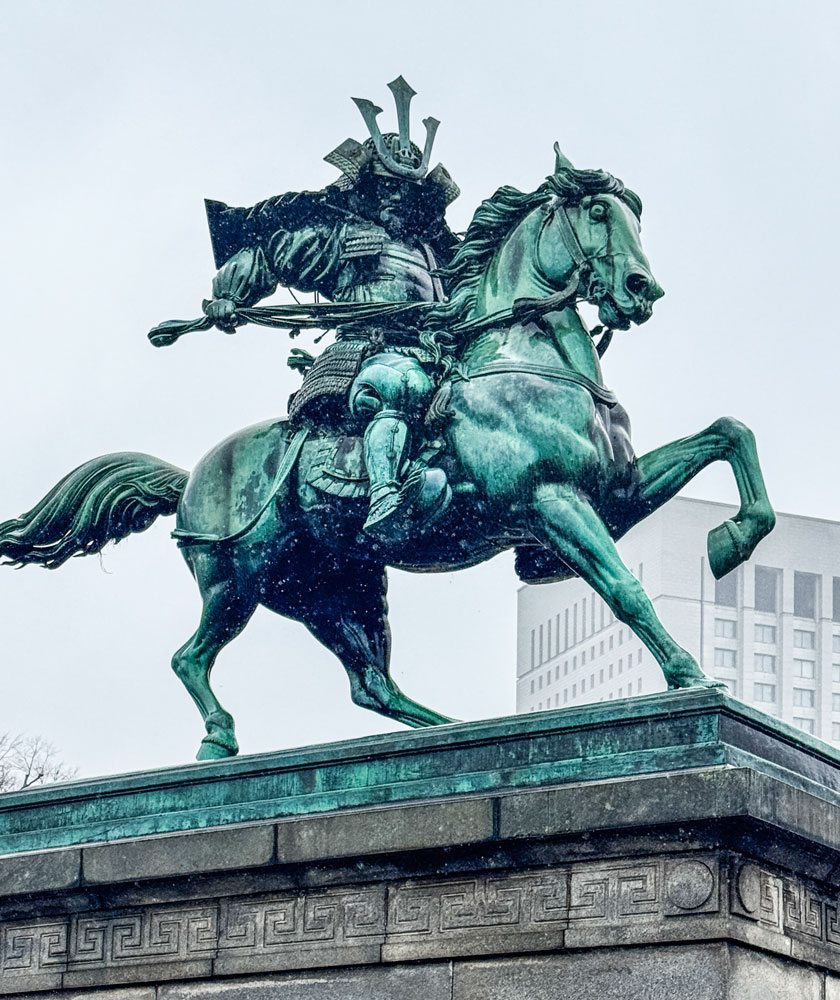
Then we walked a bit closer to the Imperial Palace (but still a long distance away) and took some pictures of the Seimon Ishibashi bridge that leads to the main gate of the Imperial Palace.
Then we made a quick return to the bus. Most of the guests did not have umbrellas - I had packed mine in my suitcase.
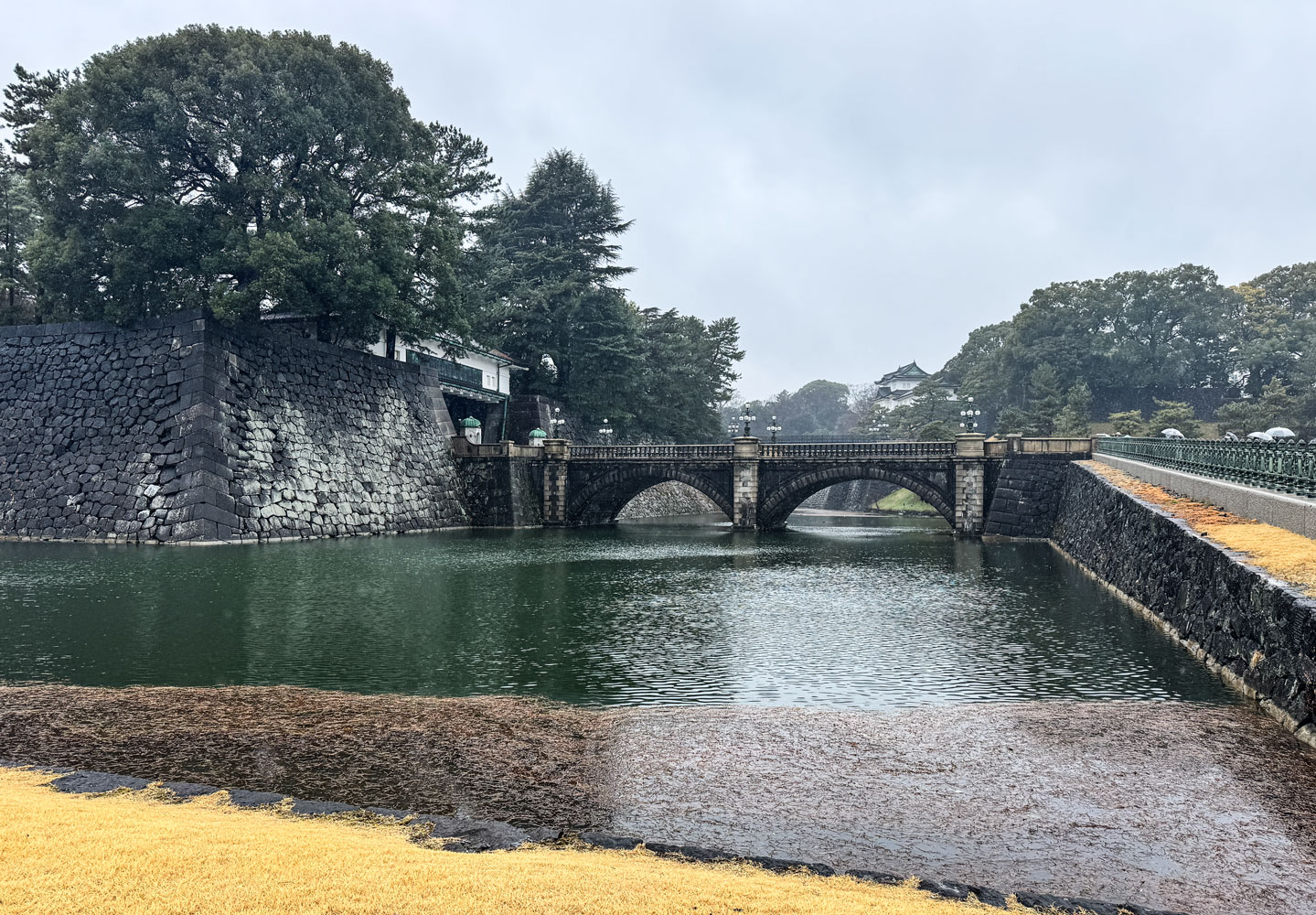
We drove by the Japanese Diet building (picture taken through the bus window). I had a tour of the Diet building many years ago during one of my visits to Japan. I don't really remember anything about the interior.
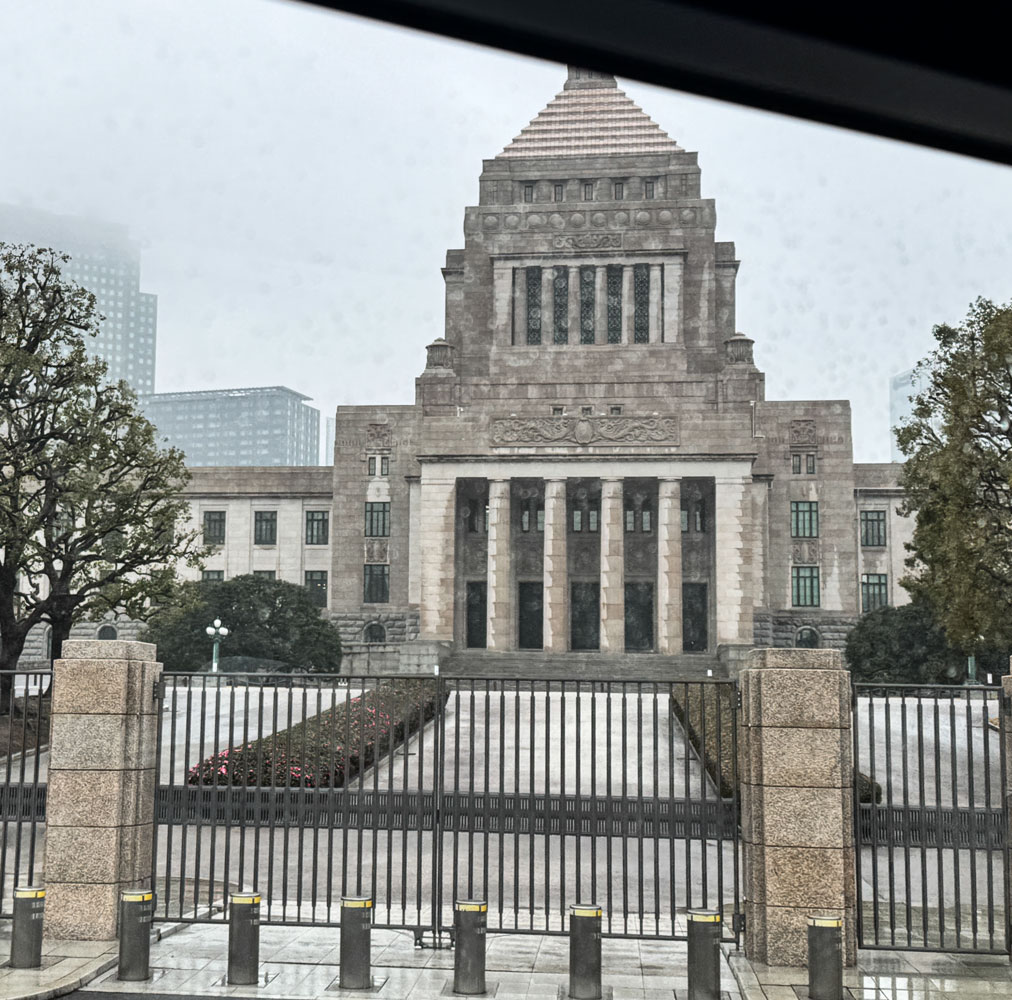
Then we went to the Tokyo Tower. Picture from the web.
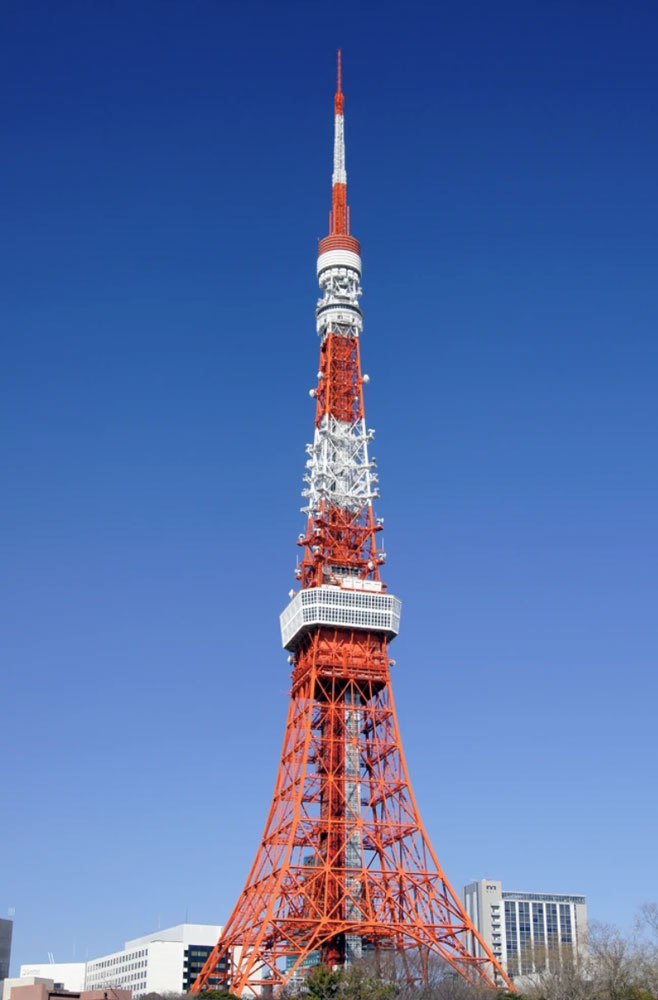
The tower was completed in 1958 and has an observation deck at 150 meters up the tower. There's a four story building at the base of the tower, and the bus parked in a lot that allowed us entry to the second story.
The main observation deck is two levels, and we took an elevator to the upper level. I took pictures of the area around the tower.
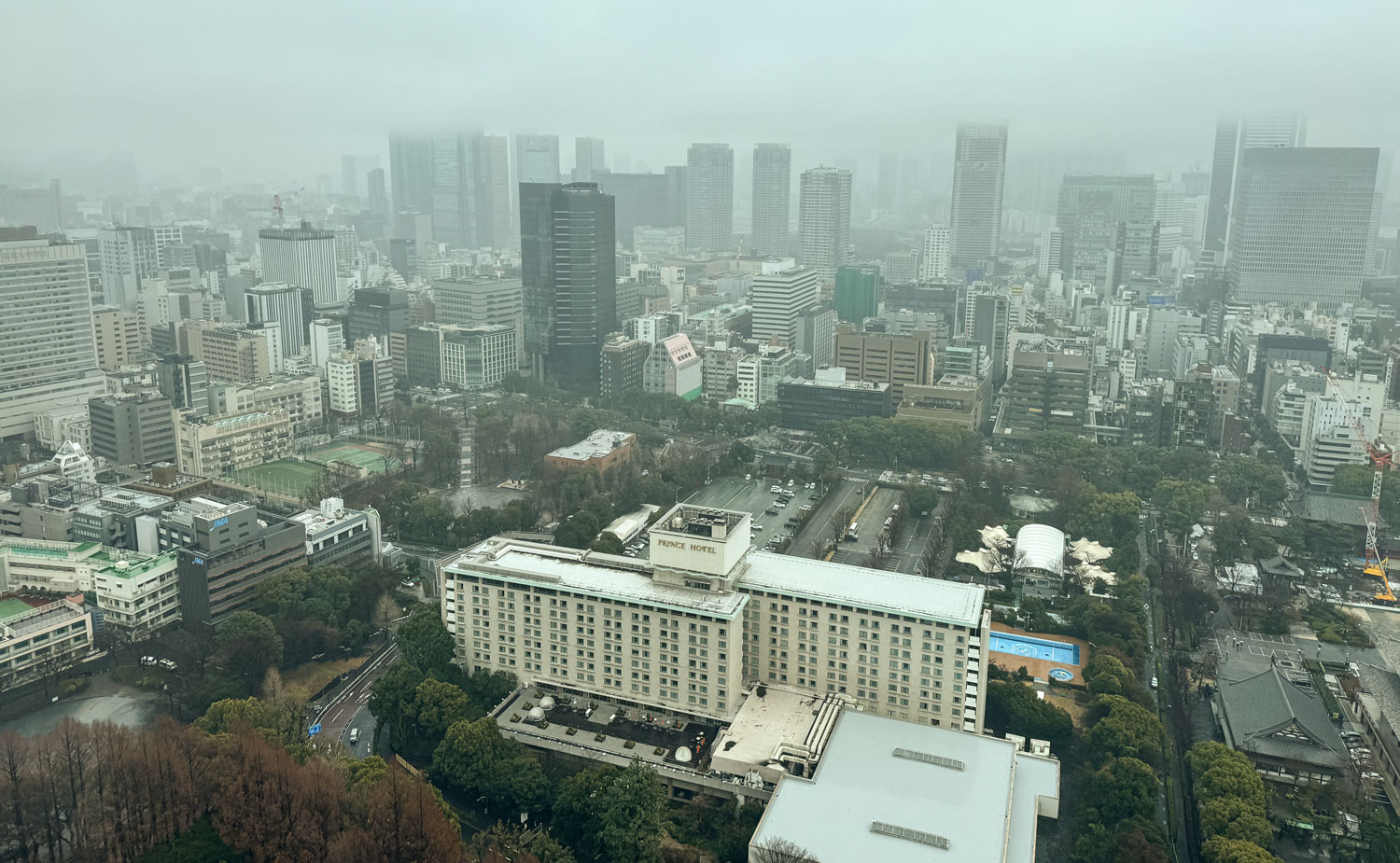
The Zōjō-ji Buddhist Temple is located very close to the tower. Ieyasu Tokugawa is enshrined there - not buried there. He's buried at Nikkō Toshō-gū in Nikkō Tochigi Prefecture. An interesting article about Tokugawa's burial place is here.
Note the small cemetery associated with the temple. Cremation is generally used in Japan. After the body is cremated, some fragments of bone are usually left. The family picks out the bone fragments, using special chopsticks, and the bone fragments and ashes are placed in an urn, starting with the bones of the feet so the person will be upright in the urn. The burial site, therefore, is usually only large enough to accommodate a memorial stone. See here for a description of the process and ceremony.
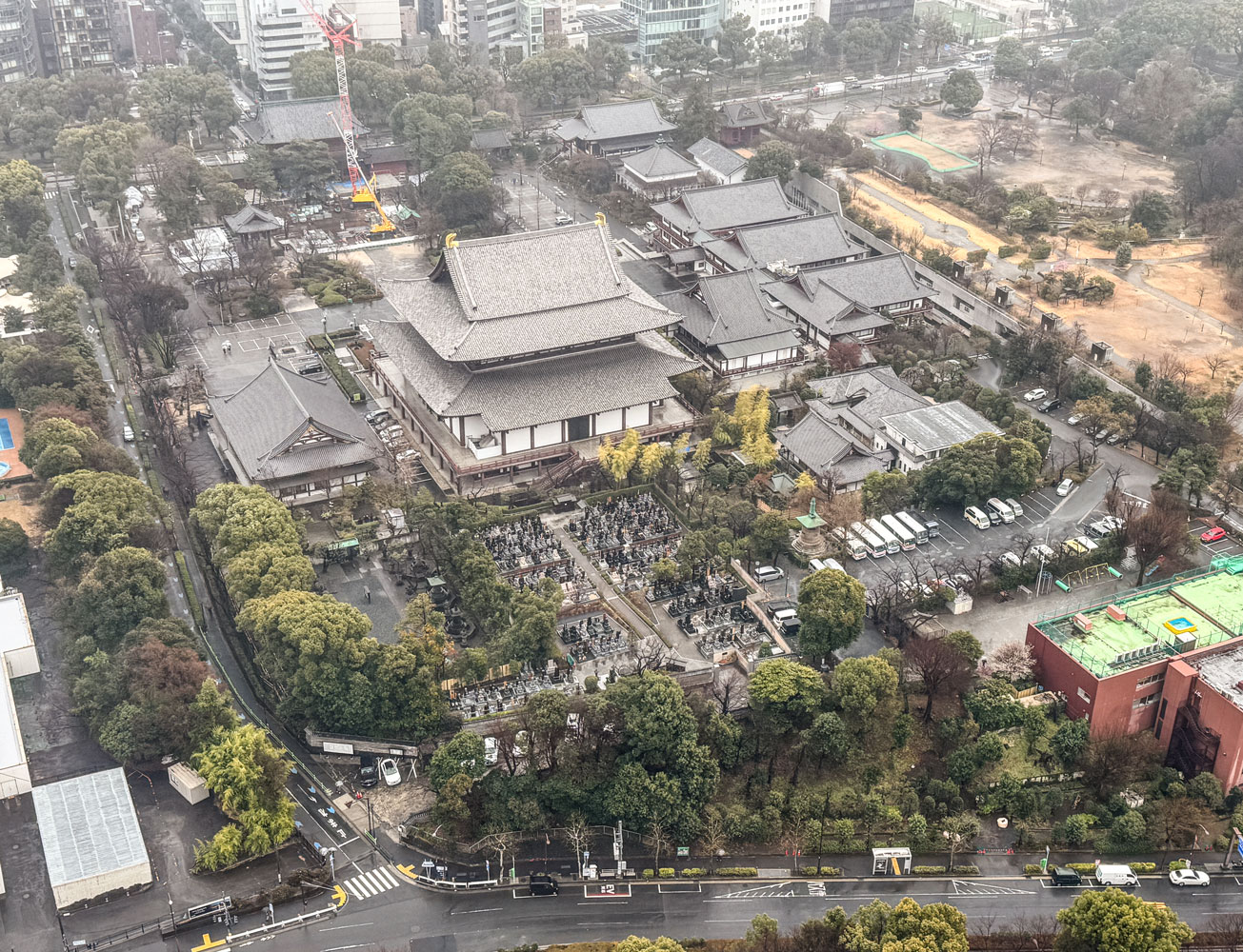
Another view of Tokyo.

I had some difficulty identifying this Buddhist temple. It's either Rurikō-ji or Shinkō-in, or it's a two-temple complex.
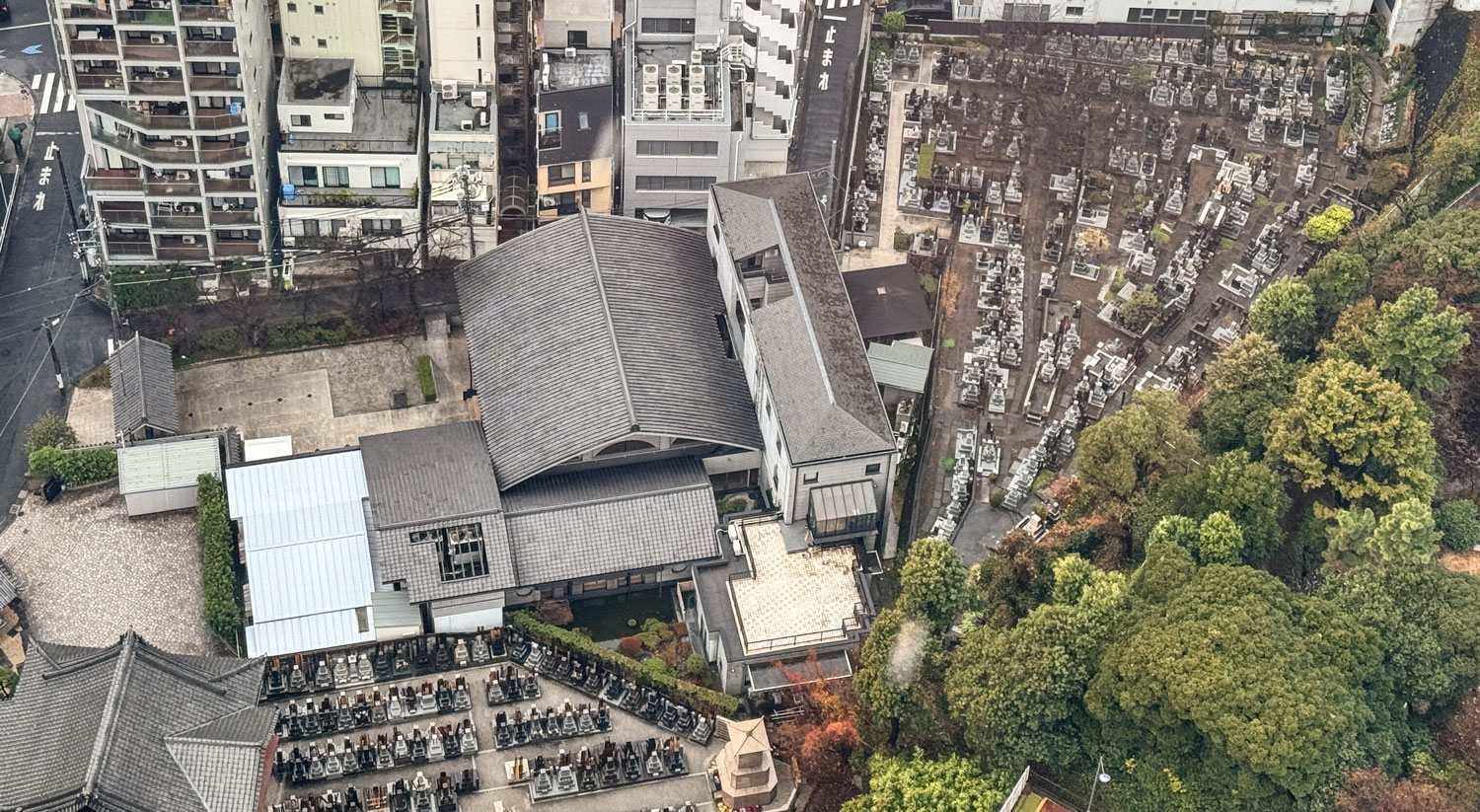
This is the Reiyukai Shakaden Buddhist temple.
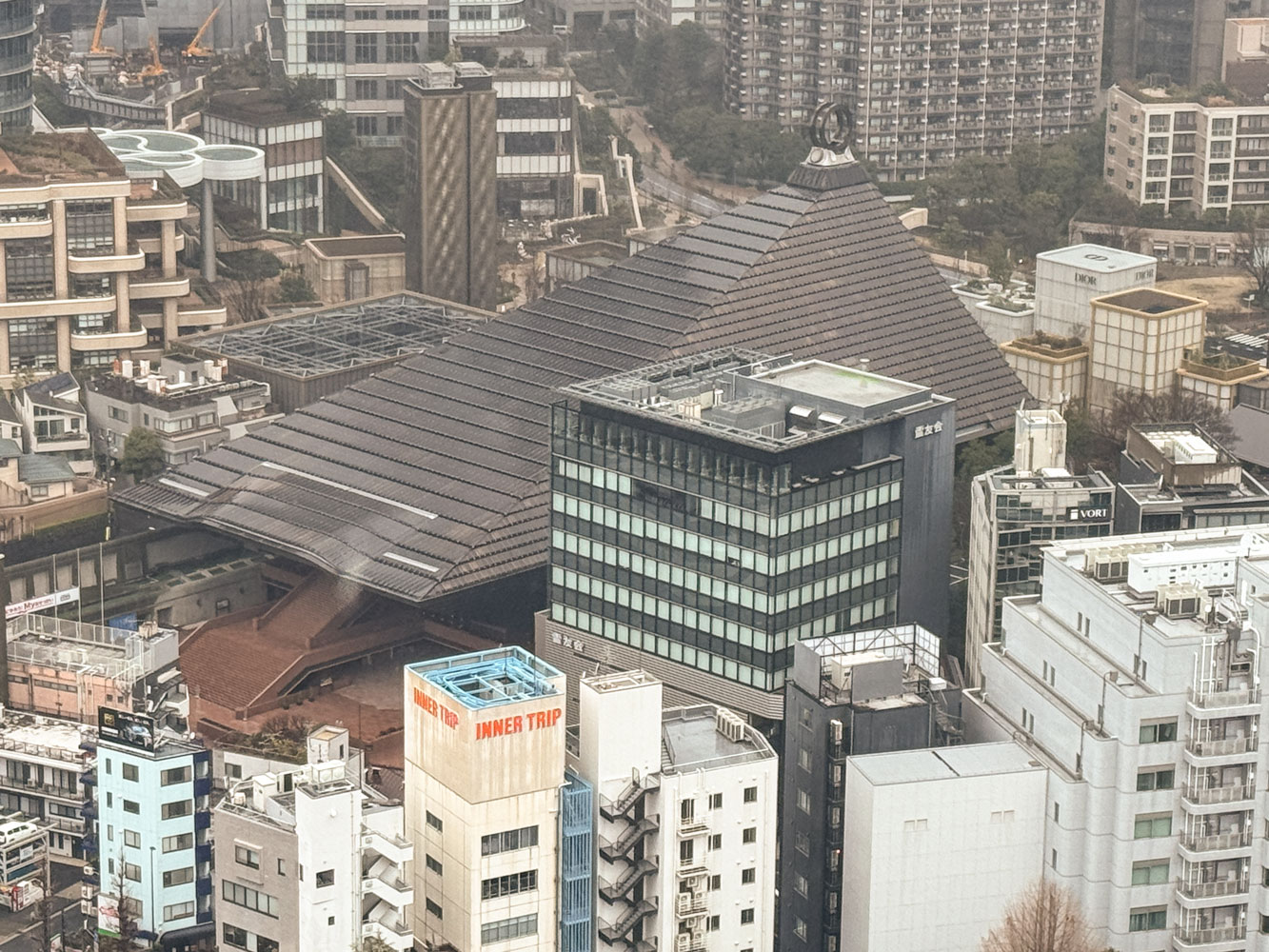
These Japanese kids were apparently on a field trip to the tower. Unfortunately, they were against the bright outside light which made for a difficult picture.
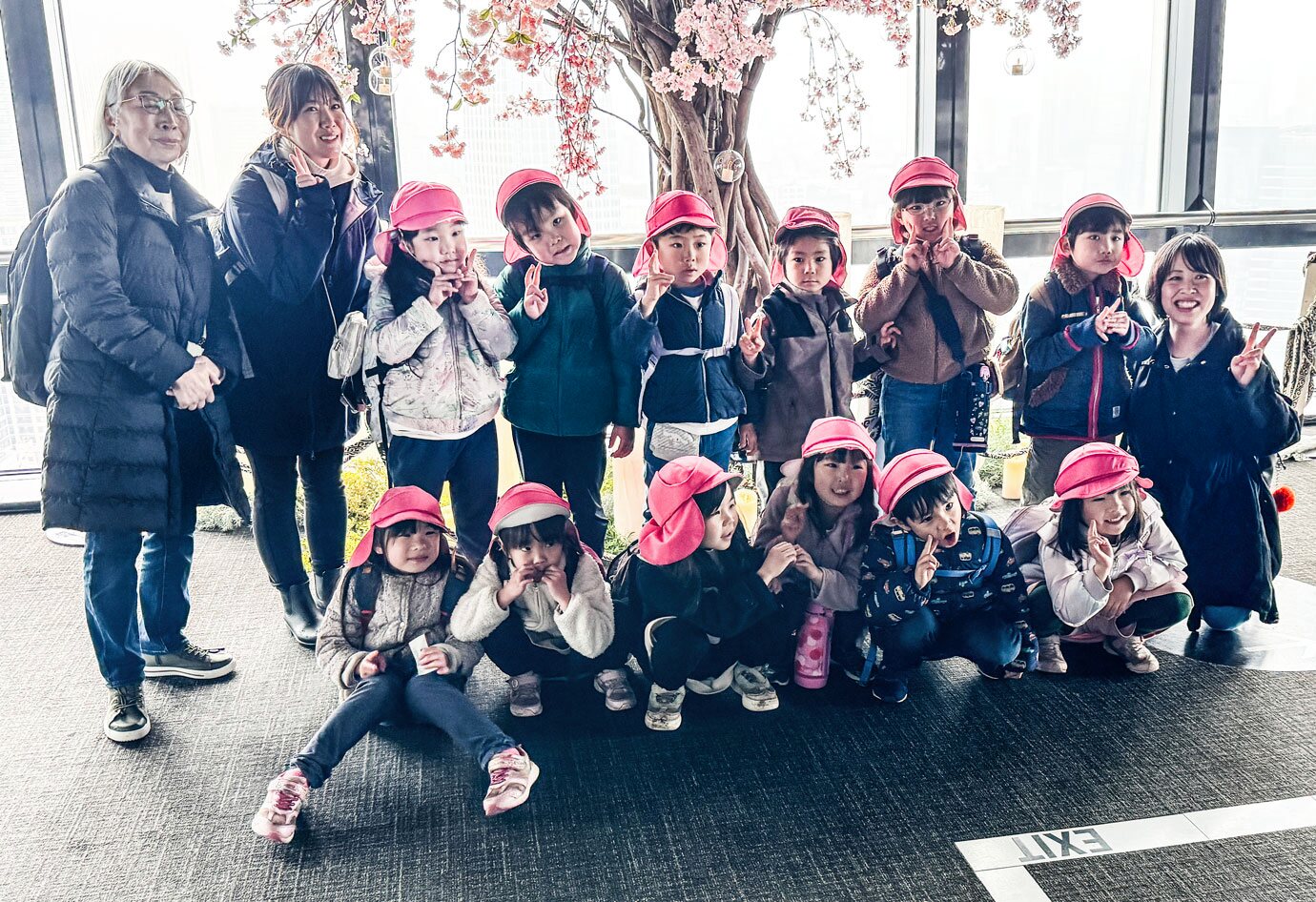
Judy and I went down to the base and got on the bus, which was now bound for Narita Airport - Terminal 1 for Air Canada. We arrived about 1:30 and the Air Canada check-in didn't open until 2pm.
After checking in and going through security, we went to the lounge and waited for boarding time for our 6pm flight on March 5th, to Vancouver.
The aircraft is a Boeing 777-300 and the food and service was fine, but the reclined seats in business class were not comfortable. It was a 9 hour flight, and we both were able to get a bit of sleep. I watched the Clint Eastwood movie "Letters From Iwo Jima". It was a good movie.
Through the magic of the International Date Line, we arrived in Vancouver about 9am on March 5th, a few hours "before" we left Tokyo.
When you arrive in Vancouver and are continuing on a flight to the US, you go to terminal E and clear US security, customs, and passport control as you enter terminal E. A flight from terminal E to anywhere in the US is then treated as a domestic flight.
Here's the sign over the entrance to Terminal E - looks like Terminal E is the United States, but it's a Customs and Border Protection Preclearance site.

We spent the time in the Air Canada lounge with three other people from the cruise. I should have taken a picture but forgot.
Shortly after noon, we went to the gate and boarded an Air Canada Boeing 737-8.
The flight was only about 2.5 hours - we arrived at 4pm and were met by Chris, our limo driver.
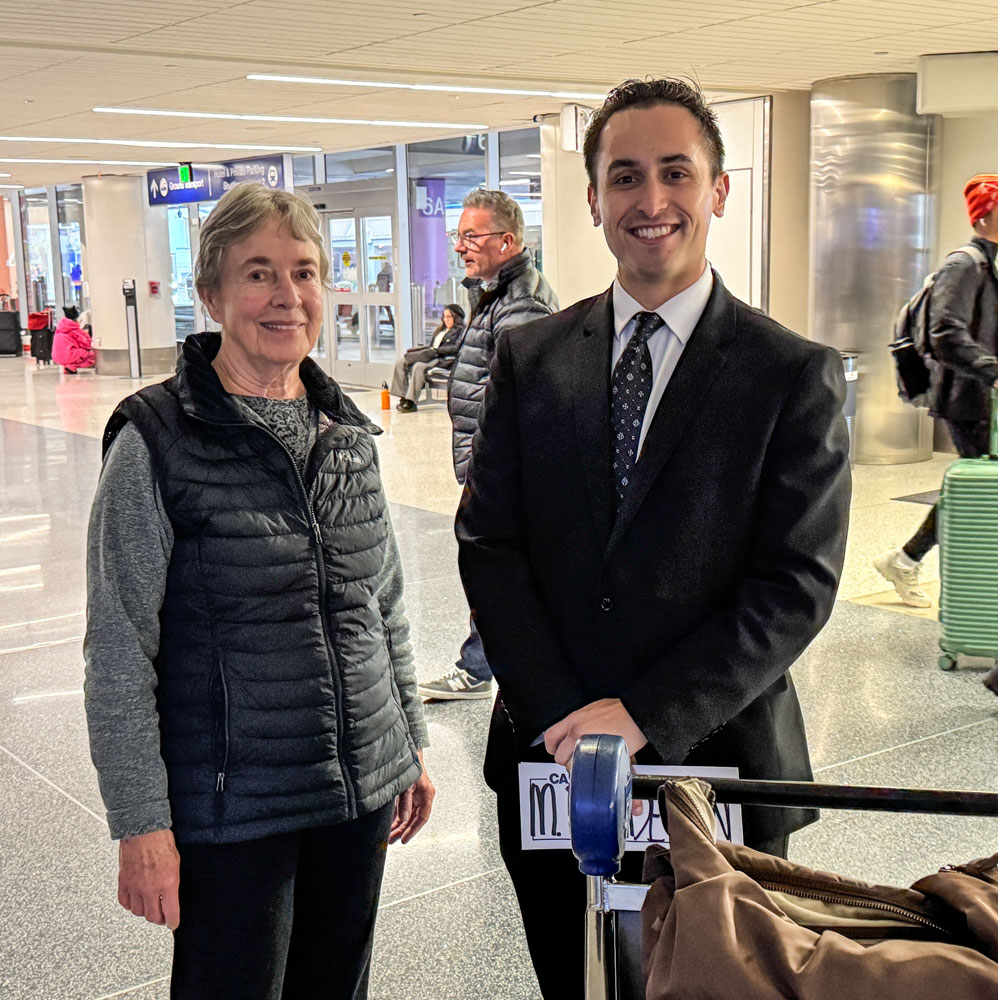
It was raining, so we headed out into a wet 4pm Los Angeles rush hour. During the two hour drive, Chris told us a bit about himself. He's an aspiring actor but only having modest success. I thought of the Dionne Warwick song "Do You Know The Way To San Jose" which has the lines:
LA is a great big freeway
Put a hundred down and buy a car
In a week,
maybe two, they'll make you a star
And all the stars that never were
Are
parking cars and pumping gas.
I always thought those lines encapsulated the struggle of the young people who come out to Los Angeles seeking fame and fortune in the television and movie business. Chris is dedicated, educated, trained and hard-working. We wish him good luck.
Chris knew all the fastest side roads to take when the freeways are clogged but it still took two hours to get home. He had worked as a transit bus driver in Los Angeles before joining Carey.
Our two girls (Cavalier King Charles) were crazy excited to see us but settled down fairly quickly. Our friend, Greg, who had been house and dog sitting, had left earlier.
That was the end of another adventure.
++++++++++++++++++++++++++++++++++++++++++++++++++++++++++++++++
Some comments by Mike about the trip:
Regent Seven Seas does a very good job on the ship. Everything is well taken care of and the staff is helpful and friendly. But Japan is a somewhat unique country - it still uses certain elements of its past, and celebrates its history.
A ship cruise just doesn't give you a real view of Japan. The excursions take you to temples and other sites, but you don't really get a feel for the country. There just isn't time on those excursions to do and see the things that make Japan unique.
For future travelers to Japan, I'd recommend a land tour that focused on immersing you into the culture. For example, I'd like a land tour that put the group into traditional Ryokans (Japanese hotels) so that you could experience a room with tatami mats and sleeping under a futon. But watch out for the Japanese pillows (makura) - they're filled with beans or buckwheat hull and I never found them comfortable. Many Ryokans have communal hot baths, but you need to learn how to use them before indulging. You wash before getting in. The tub is just to soak in after you are clean.
If you're into hot springs, Japan has many, mostly traditional, called Onsen. They're like a Ryokan but with hot springs to soak in. They're usually in rural areas.
The traditional Kimono dress is too complex and expensive for tourists (male and female) but in warmer weather a yukata is simple, low cost and easy to wear. It can be worn to a restaurant or most other places.
I'd like all of the food to be Japanese - breakfast, lunch and dinner. Maybe arrange a tea ceremony, a visit to a Kabuki or Noh theater, and perhaps a sumo match. Maybe a few lectures about Japanese religion and history, also.
I have no idea who might offer such a land tour.
Our next trip is a Regent cruise up the Norway coast.
Click here to go back to our main page.